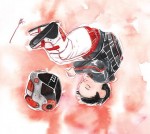 Jeff Lemire and Dustin Nguyen’s lovely Image series Descender was picked up by Sony for adaptation into a feature film last year before the first issue even hit the stands. It was even the subject of a big bidding war between studios, with the “House of Spidey” winning out. Just a little over 12 months later (by […]
Jeff Lemire and Dustin Nguyen’s lovely Image series Descender was picked up by Sony for adaptation into a feature film last year before the first issue even hit the stands. It was even the subject of a big bidding war between studios, with the “House of Spidey” winning out. Just a little over 12 months later (by […]
Viewing: Blog Posts Tagged with: Jeff Lemire, Most Recent at Top [Help]
Results 1 - 25 of 28
Blog: PW -The Beat (Login to Add to MyJacketFlap)
JacketFlap tags: Movies, Image, Sony, Jeff Lemire, Dustin Nguyen, Add a tag
Blog: PW -The Beat (Login to Add to MyJacketFlap)
JacketFlap tags: Reviews, Wolverine, Jeff Lemire, Top News, Andrea Sorrentino, Old Man Logan, Add a tag
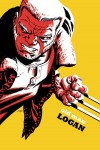 In the wake of the All-New, All-Different Marvel Universe, we’re taking a look at each and every #1 in the line. This week sees the return of Wolverine, but not the Wolverine you might immediately think of. Old Man Logan first debuted in 2008 in the regular Wolverine title. Author Mark Millar (Starlight) told a […]
In the wake of the All-New, All-Different Marvel Universe, we’re taking a look at each and every #1 in the line. This week sees the return of Wolverine, but not the Wolverine you might immediately think of. Old Man Logan first debuted in 2008 in the regular Wolverine title. Author Mark Millar (Starlight) told a […]
Blog: PW -The Beat (Login to Add to MyJacketFlap)
JacketFlap tags: Comics, Breaking News, Publishers, Top News, Top Comics, Valiant, Jeff Lemire, Bloodshot, Lewis LaRosa, Add a tag
When a comics publisher talks about a miniseries launching in a prestige format, we often think about some of the best material in comics. Landmark stories crafted by DC in the ‘80s including Batman: The Dark Knight debuted in this special thick format — the comic was so inspirational that other comics companies followed suit. […]
Blog: PW -The Beat (Login to Add to MyJacketFlap)
JacketFlap tags: Comics, Breaking News, Publishers, Valiant, Jeff Lemire, Top News, Top Comics, Blooshot Reborn, Lewis LaRosa, The Analog Man, Add a tag
Valiant Entertainment has decided to switch up their publishing slate with a brand new arc for Bloodshot Reborn containing a brand new status quota for the hero. The issue is shipping in 2016 with writing from traditional Bloodshot Reborn author Jeff Lemire and artist Lewis LaRosa. The new story entitled ‘The Analog Man’ debuting in issue #10 […]
Blog: PW -The Beat (Login to Add to MyJacketFlap)
JacketFlap tags: Descender, Image, Jeff Lemire, Image Comics, Dustin Nguyen, Top News, Top Comics, Add a tag
Descender is back! After a slightly longer than average hiatus, the series’ second arc, entitled “Machine Moon,” will begin in November. The first arc of Descender made waves when it debuted at the beginning of this year. Writer Jeff Lemire turned the classic premise of a boy and his dog on its head, setting their adventure in a […]
Blog: PW -The Beat (Login to Add to MyJacketFlap)
JacketFlap tags: Comics, Star Wars, Breaking News, Valiant, Dark Horse Comics, Jeff Lemire, Image Comics, Top News, Top Comics, Bloodshot, Descender, Mirror's Edge Exordium, Add a tag
This week, a longtime staffer of the internet’s premiere comic book website, The Beat, became obsessed…obsessed with ‘90s X-Men comics. We tried to take away copies of comics like X-Cutioner’s Song from the staffer — but the efforts of the full staff at the Stately Beat Manor (home of team Comics Beat) proved futile. We were […]
Blog: PW -The Beat (Login to Add to MyJacketFlap)
JacketFlap tags: Interviews, Comics, Image, Jeff Lemire, Image Comics, Descender, Emi Lenox, Mail-Bot, Plutona, Add a tag
Descender's Mail-bot reveals comic creators who are in fact actually robots and speaks about all things Plutona. The answers may shock you.
Blog: PW -The Beat (Login to Add to MyJacketFlap)
JacketFlap tags: Marvel, Breaking News, Publishers, X-Men, Jeff Lemire, Top News, Top Comics, Ramos, Add a tag
With author Brian Michael Bendis leaving the X-Men franchise via Uncanny X-Men #600, Marvel fans have been waiting for the announcement of the next creative team on the title. Now, the wait is over as the House of Ideas has revealed writer Jeff Lemire, penciller Humberto Ramos and colorist Edgar Delgado as the next team for the upcoming All-New, All-Different X-Men title: The Extraordinary X-Men. We asked Lemire about the prospects of writing the X-Men just last week in our exclusive interview with the creator — read what he had to say.
Many of the plot details in the comic are shrouded in mystery surrounding of Secret Wars. However, Lemire revealed that the story is spinning a stronger relationship between the X-Men and Inhumans — the Terrigen Mists will play a role in the story. Also, Cyclops and many of the main cast members appear to be missing from the traditional X-Men roster.
The new line-up sees a team without the more traditional versions Wolverine or Cyclops — that’s where Old Man Logan comes in with the eXtra eXperience. Storm is leading the Extraordinary X-Men in the place of the absent Wolverine. The All-New X-Men of the time displaced future are still represented in the title through Jean Grey. The adult Ice Man is gracing the team alongside the traditional versions of Colossus, Nightcrawler, and Magik. CBR announced the news and shared an exclusive interview with Lemire.
Here’s Lemire talking to CBR about the origins of the phrase “Extraordinary”:
We wanted something new that hadn’t been used before and “Extraordinary” almost felt like one of those ones where we couldn’t believe no one had done a book called “Extraordinary X-Men” before.
The author chimed in on how he feels about his past work intercut with this current feelings on the X-Men franchise:
I think in the past I got too focused on plot and lost characters a bit in the other team books. There’s a tendency to have plot plot plot, insert character moment here. For the X-Men, I’m approaching it much more where the whole book is a character moment with action stuff interspersed, kind of the reverse of that.
No release date has been announced for the title. Stay tuned to The Beat, as more Marvel information is set to be revealed this week.
Blog: PW -The Beat (Login to Add to MyJacketFlap)
JacketFlap tags: Interviews, Comics, Breaking News, Jeff Lemire, Top News, Sweet Tooth, Top Comics, Descender, Essex County, Roughneck, Add a tag
Jeff Lemire is one of the most prolific comics creators currently working in the industry. Following his breakout graphic novel Essex County, Lemire has explored themes of childhood and innocence lost through contemplative and grounded graphic novels like Underwater Welder and through genre series like Sweet Tooth and the breakout hit Descender, which was recently optioned for a film adaptation.
I recently sat down with Jeff Lemire to discuss his storied career. We explored his early career, the difference in perspective that fatherhood has provided him as a writer, and the horrors he learned were perpetrated by the Canadian government against the First Nation aboriginal community as he prepared to pen Roughneck. The word “X-Men” was also mentioned.
Alex Lu: How’s Descender going?
Jeff Lemire: It’s going great. Dustin’s finished issue five and he’s working on number six. I’ve written eleven scripts, and the reception has been as we possibly could have hoped, both critically and in sales numbers.
Lu: Eleven scripts? You’re pretty far ahead. Is that how you typically work?
Lemire: Yeah, I work really far ahead on everything. I’m juggling so many projects right now that the only way I can handle it is to be so far ahead on everything that I can take a couple months off one thing to work on something else. Right now is my time off from Descender so I can let it sit and come back to the scripts once Dustin draws them.
Lu: Because you work so far ahead, do you often find yourself revising older scripts based upon where the later ones take you?
Lemire: Oh, absolutely. That’s a real benefit that you don’t often get working in monthly serialized comics. When you’re doing the monthly schedule, most people are getting the scripts in right on time and flying by the seat of their pants. It’s nice, especially on creator owned stuff, when you have the opportunity to let the story take you wherever it wants to go and if you go in a direction you hadn’t anticipated, you can go back and rework earlier things to make everything line up. It’s a unique adventure.
Lu: In the third issue of the story, you introduce the concept of a robotic afterlife. Is this something that was in the story from the onset or was it something you came up with later?
Lemire: It wasn’t in the initial pitches, but it emerged early on in conversations with Dustin. I don’t want to give away too much about where the story is going, but the sequence you’re talking about came out of an idea Dustin had after reading the initial pitch.
Lu: What was the initial pitch like and how far have you deviated from it?
Lemire: It’s pretty close to the initial pitch. The story should run for 23 to 40 issues, and I think we’ve added one major character who’s now pretty integral to the whole thing, but other than that…I spent a long time on the pitch before showing it to Dustin so I had the building blocks in place. It was a matter of fleshing the characters out and letting some of them breathe and develop. Sometimes, seeing Dustin’s art will give me ideas for new directions or I’ll fall in love with a background character and I’ll start writing a bigger role for them because I like the look of them and want to tell a story about them.
Lu: I think one of the breakout stars of the first arc is the Driller bot. I didn’t think he’d make it past his introductory issue, but he’s still around!
Lemire: Driller was always one of the main characters. He, Tim, and Bandit were always going to be a threesome, right from my initial pitch. I was surprised to hear that people didn’t think he was going to he was going to stick around, but he’s here to stay. I always like my big dumb guy and he gives a good balance to the rest of the group. Physically, the difference between him and Bandit is a great juxtaposition.
Lu: The relationship between Tim and Driller seems similar to the one between Rocket Raccoon and Groot.
Lemire: Yeah, I guess! Driller has some secrets that Groot probably doesn’t have, though. There’s a bit more to Driller than what people are getting right now. We’ll leave it at that.
Lu: What’s been the most exciting part about working on the series so far?
Lemire: Oh, it’s definitely been seeing Dustin’s art. It’s the first creator owned book I’ve done that I haven’t drawn myself and it’s a real thrill to invest so much into something and then share it with someone. Then you’re surprised by how that someone brings themselves to it as well. Seeing these ideas that I came up with being realized and built upon by Dustin is a real thrill.
Lu: Were you thinking of Dustin when you came up with the pitch for Descender?
Lemire: He was the first artist I asked. I don’t remember if I had him in mind when I was writing the initial pitch, and I don’t think I did. However, now I can’t imagine the series without him because his watercolor style has become so indicative of what people think of when they think of Descender.
Lu: Dustin’s art is a great yet unexpected choice because of the way his natural watercolors stand in contrast with the cold and mechanical feel of this futuristic world.
Lemire: I think the art style he’s using embodies the whole core of the book. It’s a science fiction book about machines and things that are technical, but it’s executed in a very organic way. That mixture of the human and the machine embodies Tim and really, the heart of the book. It ends up being perfect in that way.
I think Tim is the most human character in the book, which is ironic given that he’s a robot. I think robots are the ultimate symbol of human arrogance. It’s us playing god, creating something in our own image. We’re seeing this world that’s outgrown us. These machines grew beyond us and we couldn’t handle it so we destroyed our own creations. I think that says something about us.
Lu: What were you influenced by as you developed Descender?
Lemire: It’s always a tough question to answer because I never remember exactly what I was into when I develop a concept. It’s a weird alchemy how any idea comes together. I can’t think of a lot of real sci-fi I was into at the time. One thing that influenced me a little bit was Jack Kirby’s Machine Man. I was really into reading all the 70s cosmic stuff he was doing at Marvel. I don’t think you see a lot of it in Descender, but I think it’s there somewhere. You know, I don’t know, I feel like I’m avoiding the question but I really don’t remember what I was into it. Sometimes these things happen real fast and these things just spill out.
Lu: How long have you been working on Descender?
Lemire: I think I started working on the pitch last February or March. I knew my DC exclusive would be done in June at that point so I was starting to develop things I could work on with Image or elsewhere. That was around the point Dustin got involved, but I had been working on concepts six to seven months before that as well.
Lu: Did you find it challenging to work with Dustin given that his style is so different from your own?
Lemire: Not at all. I think if you want someone to draw just like you, then there’s no point in collaborating at all. You try to find artists whose work you like and respect and you work with them because you want them to be themselves. It’s very easy for me to be completely hands off when I’m not drawing something and give my artist, in this case Dustin, the room to let him be himself. I respond to his work emotionally and aesthetically so I wouldn’t want him to be anything other than Dustin. I think it’s a very easy collaboration. There’s a lot of mutual respect and trust.
Lu: A lot of your creator owned work has been published in the form of a graphic novel. What made you decide to produce Descender as a monthly?
Lemire: The biggest creator owned book I ever did was Sweet Tooth, and I did that for four years so doing another was nothing new for me. I think I’ve really grown accustomed to a monthly format and I even kind of prefer it. In a film, you have two hours to tell a story and develop a character, whereas in television you can spend multiple seasons and many hours developing characters and plotlines. Comparing graphic novels to monthlies is similar because in monthlies you have more time to develop everything and execute stories. You’re not trying to boil everything down into an easily digestible three act structure like you are in a graphic novel.
I prefer that longer format monthlies provide; the ability to take an issue and focus on one character per month. You don’t have to be so focused on the amount of space you have to play with or the space you’re wasting in order to tell a story. I just finished a graphic novel, but I think I want the next thing I draw to be a monthly. I ultimately prefer things that way.
Lu: With monthlies, do you ever worry that you might wander so much that you lose sight of what you originally wanted to say with the work?
Lemire: No, because what I start with is usually very simple. One or two sentences. A simple core idea. It’s never anything too complicated or too complex. You’re not starting with a byzantine plot you’re trying to hold onto. It’s easy to remember a core idea, so it’s never been something I’ve been worried about. Plus, the more you get into a book and develop the characters, the more you feel like you know them and the easier it is to find your way through a work.
Lu: How long does it take you to find that kind of rhythm with your characters?
Lemire: It varies from project to project. Generally, with stuff like Descender, it develops pretty quickly. Once you write the first issue, if you’ve done it well, you get a pretty good sense of who these characters are. Especially when you’re the creator of these characters, you already know these characters better than anyone else so it’s not hard to find that rhythm as long as you stay true to and build off of your original idea.
Lu: Your story in the Vertigo CMYK Anthology, “Sweet Tooth: Black,” really struck me because it caused me to develop an empathetic relationship with a group of characters in a very short period of time.
Lemire: Thanks. I actually think it was a mistake to do that story. I was happy with how it came out but I had already told the Sweet Tooth story and I was really happy with the ending. After I made the Black story, I wondered why I went back to something I was happy with. I’m glad it affected other people.
However, doing more short stories is something I would love to find time to do. These days, though, I seem to jump from one project to the other and don’t have as much time to experiment as I used to. With this story, I think I just missed the character a little bit and thought an eight page zero issue would be a good way to scratch that itch without committing to something bigger, but in hindsight, I probably wouldn’t have done it. I don’t think I’ll ever go back to any of my stuff again. When something’s done, I usually move pretty quickly.
Lu: Something like Essex County seems like it still has room for development.
Lemire: Yeah, but I would never go back to it, either. I’ve had people ask me, and I feel like I’m a completely different person than I was when I wrote that book. Each book marks the place you were in when you did it, and it’s really hard to go back and be the same person you were. You mentioned holding onto that core idea and not losing it, but when you finish something it goes away and you get another core idea.
It’s really hard to go back and find that original idea, especially when that idea inspired your first book. I was in a very different place compared to where I am now, so it’d be very difficult to do more Essex County that would fit with what I was doing before. Plus, Essex County is almost ten years old and people are still enjoying it and it still sells very well so it still has a life and I don’t want to mess with that. I want to do new things.
Lu: Would you want to go back and explore the more realistic space you explored with Essex County, though?
Lemire: Absolutely. That’s the Simon and Schuster graphic novel I just finished. It’s not another chapter of Essex County, but it’s a return to the grounded family drama work I was doing from a different perspective. I love doing genre books like Trillium and Descender and I think I always will, but it’s also important for me to balance that work with stuff like Essex County to make sure I don’t stray too far away from reality.
Lu: And this new book is called Roughneck, right? What did you discover the difference in your headspace to be between this book and Essex County?
Lemire: Yeah…I’m a totally different person. When I was writing Essex County, I had never published anything and nobody knew who I was so there was no expectations on the work. I was still finding myself as a creator and on a personal level, I wasn’t a parent yet. I am now, and that dramatically changes your life and everything about your perspective on life. I’ve had a certain amount of success now so I get to do comics every day and make a living off it whereas I was struggling to write Essex County while working day jobs.
Lu: Even though you weren’t a father while you were writing Essex County, there are recurring storylines in that book and your other works about what it means to be a kid and to grow older and lose your sense of innocence. What is it about childhood that you find so fascinating?
Lemire: I have no idea! It’s one of those themes that I keep coming back to and keep exploring. To sit back and analyze why I do that is not really how my mind works. I do the analysis through my comics, so I don’t know what it is about childhood, innocence lost, and fatherhood that makes me keep coming back to them, and sometimes you don’t even want to analyze, think about, or articulate those things because you don’t want that well your ideas seem to come from to go away.
On a basic creative level, I have always enjoyed writing from a child’s perspective. It comes very naturally and I seem to have a knack for it. I think I’m interested to look back in a few years and compare the stuff I wrote before I was a father to the stuff I wrote after and see if the early works were about being a child while the later ones are about being a parent.
Lu: How has having a son influenced your depiction of kids?
Lemire: I think I have a much better sense of innocence and the sense of wonder through which they see the world. I think that’s why Sweet Tooth is the way that it is. It’s about this completely innocent kid slowly discovering the world around him, and I think Descender is much the same.
Lu: Do you think it would be accurate to say that before you had your son, your stories about childhood were influenced by your childhood?
Lemire: Yeah, I think that’s accurate. I think Essex County was about me fictionalizing and dramatizing my childhood. It’s where I grew up. On the other hand, Sweet Tooth and Descender are much more about my fears for my son and me wanting to protect him and his perspective about the world.
Lu: Now, tell us a little more about Roughneck.
Lemire: It’s a 275 page graphic novel written and drawn for Simon and Schuster for a Spring 2016 release date. The story focuses on a guy named Derek who is an ex-NHL tough guy whose career ended in disgrace after a violent incident. Since then, he’s returned to the remote First Nation community where he grew up in northern Canada. He’s been stuck in this small town and a bad place, drinking too much and fighting too much; not really moving on or finding a new path for his life after hockey left him behind. Then, his sister, who ran away from town when she was 15, comes back into his life. Her return triggers the creation of a new path for both of them. It’s a story of brothers and sisters, healing, and them reconnecting with the land and their Cree heritage. They find a healing in the old ways of their people.

Lu: Did you do a lot of research for this project?
Lemire: Yeah. I never feel like I’ve done enough because I’m not aboriginal and don’t have any native blood. So, as a white guy writing about aboriginal people you always feel like a bit of a pretender, but I did as much research as I possibly could. I spent a lot of time in one of the First Nations here in Ontario, just meeting people and talking, trying to understand the community more and being inspired by it.
Lu: What was it that made you want to tell this story?
Lemire: A couple of things. I got really inspired by this Canadian novelist, Joseph Boyden. He’s done three novels now, and they’re all favorite books of mine. He writes about a lot of the northern communities in Ontario and I just fell in love with that community through his stories and wanted to learn more about them. That created a big gap in my understanding of Canada.
Canada is a very big and diverse country, but there wasn’t a large native community where I grew up. I had no firsthand experiences with aboriginal people and their culture. I realized how ignorant I and so many other Canadians to the first peoples of Canada, so the project became a way for me to learn more about that culture and hopefully help others connect to that culture as well.
Lu: In American schools, we’re taught quite a bit about the current and historical treatment of Native Americans. How were and are the aboriginal people of Canada treated?
Lemire: Horribly. We basically committed cultural genocide and we don’t even learn about it in school. You see a headline every once in a while, but we really have no understanding of what really happened to these people and how these communities found themselves where they are today, which is marginalized and isolating. It’s a third nation living in a first nation, and when I started to learn about that it triggered my need to explore and learn about the positive aspects of First Nation culture.
We so often see the negative stories that focus on the hardships the people face and the end result of years of abuse that we’ve inflicted upon them. You never see the beautiful and amazing parts of their beliefs and their culture. They’re a vibrant and resilient people, and these are the things I wanted to communicate to other white Canadians through my work.
Lu: You never learned about the suffering inflicted on aboriginal people in school?
Lemire: Not really, or at least not nearly as much as I should have been, that’s for sure. Also, I’ll be fully honest, it’s hard for me to go back in my mind and remember what I was actually taught in school and how much I was paying attention. Nonetheless, I’m not being hyperbolic when I say there was a cultural genocide. The church and the government of Canada basically wiped out native culture and took their children, putting them in residential schools where they were forced not to speak their language. They never saw their parents again, and in many cases they were sexually and psychologically abused by the people running these schools. This went on for decades until the 80s and 90s, and most Canadians aren’t aware of exactly what we did to them. I think it’s something we need to be educated about more because it’s a huge part of our culture and country.
As much as I love Canada…you know, to go back to the subject of my early work versus now, Essex County was my perspective on Canada as a naive 20-whatever year old who loved the classic old-age feel of hockey and nostalgic things that we positively associate with Canada. Roughneck is the 39 year old me who’s now looking at Canada and realizing the country and history is a lot more complicated and shameful than I realized back then. There’s a pretty stark contrast between my perspectives, and even though I use hockey as a central metaphor both, I use it for two very different reasons.
Lu: It’s incredible to me that these shameful practices persisted into the 90s.
Lemire: Yeah, I think the last schools closed in the 90s. I can’t speak to the history of abuses and when those stopped, but it’s clearly not something that’s way back in our history that we can just forget about. It’s still very recent and very much being dealt with by modern aboriginal communities.
Lu: Race issues are a huge topic in America nowadays. Is it often discussed in Canada as well?
Lemire: Yeah, you know what, as much as I’ve bashed Canada in the last bit of this interview, I think that’s one spot where we’re a lot further ahead than you guys. It’s easy for me to say sitting in Canada, not being a part of your country, but I do think we’re a bit more progressive in terms of race relations.
I happen to live in Toronto, one of the most multicultural cities in North America, so maybe my perspective is a little different because so many different cultures and races live together here. It’s so different from what a lot of the US is experiences. In terms of First Nations and aboriginals, though, we’re shamefully ignoring another huge problem.
Lu: I consider myself blessed to have grown up in a community that was relatively racially diverse. Was your childhood community the same way?
Lemire: No, not at all. I grew up in Essex County, which was a tiny farming community in southwestern Ontario, was 99.9999% white. There was a lot of ignorance and there still is in these small towns about different cultures and races. You can’t help but be surrounded by that, growing up there, but I was lucky because both of my parents were very progressive and open minded and accepting of other races when I was young. That influenced how I grew up. I moved to Toronto when I was fairly young, so I came of age in an extremely multicultural city. That, combined with the basis my parents gave me led to me becoming a very liberal-minded person.
Lu: Was there a transitional shock going from a very homogenous community to a very diverse one?
Lemire: No, I don’t even remember thinking about it. I think it was all part of the excitement of being in a big city and being surrounded by all these new people and all these people that wanted to create art. Being young, it was all just newness and excitement, rather than anything I needed to adjust to.
It’s interesting that, even though you came of age in a metropolitan area, many of your stories take place in the countryside. What is it about the province that keeps calling you back?
In the case of Essex County, it was a story about where I grew up and how I grew up. Sweet Tooth was set in a rural post-apocalyptic setting because I was so sick of seeing post-apocalyptic cities in every movie. That book was also a return to nature through human-animal hybrids and it just felt more appropriate to set things in more bucolic settings. Roughneck is also about a very specific small town that’s very different from Essex County, being set in one of our First Nations.
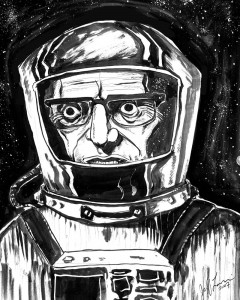 Lu: When do you think we’ll start seeing pages from Roughneck?
Lu: When do you think we’ll start seeing pages from Roughneck?
Lemire: I’m not sure. It’s my first time working with a non-traditionally comic publisher. Simon and Schuster, being a book publisher by trade, has a different way of operating and promoting the book. I’m not really sure what their schedule is in term of releasing previews, but I do know they work a lot further ahead than comics publishers which is why the book won’t come out until next year. So it’ll probably be a while.
Lu: What brought you to Simon and Schuster as opposed to Vertigo, Image, or Top Shelf?
Lemire: I think it was just something I hadn’t tried yet. I’ve worked with basically every kind of comics publisher from mainstream DC/Marvel to Top Shelf and the smallest indie publishers. I wanted to see what would happen if I did a book that was aimed at the traditional book market and built on some of the groundwork I laid with Essex County. I had a big breakout here in the Canadian literary market with Essex County and I feel like I never followed up on it. Simon and Schuster has a strong Canadian branch, and given the specific subject nature of Roughneck, I knew I’d need a publisher that understood what I was writing about and could get the message out in an accurate and big way.
Lu: I’m really looking forward to seeing how the book turns out. One final question: X-Men?
Lemire: I can’t comment. All I can say is that I am working on other stuff for Marvel, as Axel Alonso has mentioned before. The identity of those books will probably start to be revealed at San Diego Comic Con, but I’ll also say that you shouldn’t believe everything you hear on internet rumor sites.
Descender #5 releases on July 8th. Roughneck comes out in Spring 2016.
Blog: PW -The Beat (Login to Add to MyJacketFlap)
JacketFlap tags: Comics, Breaking News, Publishers, Valiant, Jeff Lemire, Top News, Top Comics, bloodshot reborn, Mico Suayan, Add a tag
In the wake of the premiere event series The Valiant came this week’s Bloodshot Reborn #1. The storyline published by Valiant comics gave Bloodshot an entirely new status quota that see’s the character questioning his own humanity. The series with art from Mico Suayan and writing from Jeff Lemire chronicled the complicated new mindset on Bloodshot. Within the issue, the anti-hero finds himself in the sparse new environment of Colorado trying to find some peace after being manipulated by Project Rising Spirit.
We reviewed the first issue, and thought that “Valiant seems closer than ever to reimagining the concept for one of their greatest and most beloved superheroes towards sheer delight with the power of Jeff Lemire, Mico Suayan, and some clever ideas.”
Comics Beat sat down with Valiant Editor-in-Chief Warren Simons to get some added perspective on the series that debuted this past Wednesday.
Comics Beat: From other interviews, author Jeff Lemire cited that he had something massive in mind for Bloodshot after The Valiant ends. Could you tease anything about that revelation without spoilers?
Simons: We’re going to take Bloodshot in a direction he’s never gone before. I think many people will be surprised by that, but I also think if you look at the world outside your window, it’s a natural evolution of the character, especially taking into account what he’s experienced. The close of The Valiant #4 plays an important role in that, but isn’t a precursor to reading or enjoying Bloodshot: Reborn.
CB: What new threats do the mysterious doppelgängers add to Bloodshot’s world?
Simons: The threat is not always directly toward Bloodshot, which in some ways is more of a challenge for the character.
CB: Can you key us in on Bloodshot’s new mental state when the first issue begins?
Simons: He’s definitely seen better days. When he was a soldier controlled by the paramilitary group Project Rising Spirit, he was forced to do atrocious things against his will, and he’s haunted by that past. Jeff Lemire and Mico Suayan have taken the book in a new, unexpected direction, but there are a few of the great core components in there that Kevin Vanhook and Don Perlin tapped into with the original incarnation.
CB: How does Jeff Lemire blend his art style with the captivating work of Mico Suayan?
Simons: As the editor of the title, I’m very happy to have incredible talents like Jeff, Mico, and David Baron here. The book is beautiful.
CB: Does the relationship between Kay McHenry and Bloodshot continue to evolve from The Valiant?
Simons: Yes, but not in a way that you’ll probably see coming. That’s the most I can say without spoiling anything.
CB: Can you tell us how the theme of identity plays a role in this comic?
Simons: I think it’s part of the core of who Bloodshot is, tracking back to the 90s. Once upon a time he was not a very nice guy, and he’s no longer that person, but his past actions still haunt him.
CB: How does Bloodshot as a 90’s legacy character continue peak your interest? What does he offer towards newer readers?
Simons: As with many of the Valiant characters, there’s an origin or high concept that’s very compelling, which is why these characters are beloved to this day. Those key elements are still there, and they drive the character to this day.
CB: How is Jeff and the rest of team Bloodshot Reborn building off of the previous run of the title?
Simons: Duane Swierczynski, Christos Gage, Joshua Dysart, and the entire Bloodshot team did a fantastic job of establishing the character in the Valiant Universe. As we’ve seen in events like Harbinger Wars and Armor Hunters, he is a very integral part of this world. Bloodshot Reborn is about the next evolution of the character.
CB: Do you have a long term goal in mind for the series? I understand that Jeff was crafting the book before The Valiant began?
Simons: Jeff’s been constructing his vision for Bloodshot Reborn for some time. In fact he’s already turned in over 12 issues of scripts as his story continues to develop. We’re very exciting about the things to come.
CB: Thanks for your time.
Blog: PW -The Beat (Login to Add to MyJacketFlap)
JacketFlap tags: News, Interview, Interviews, Comics, Image, Jeff Lemire, Image Comics, Dustin Nguyen, Top News, Descender, Add a tag
By: Lindsey Morris
2015 is already a banner year for the creators of Descender, which has seen smashing success weeks before the release of its first issue. With the film rights recently acquired by Sony Pictures and amazing groundswell from the gorgeous preview pages, Descender is poised as an early contender for the best comic of the year.
Writer Jeff Lemire was kind enough to speak with Comics Beat about the incredible universe he has been crafting with co-creator and artist Dustin Nguyen in their new monthly ongoing series.
Comics Beat: Let’s start with a summary of Descender. What can readers expect from the series?
Jeff Lemire: So Descender is a science fiction comic in an ongoing series that I’m writing, and Dustin Nguyen is drawing and painting. The story sort of focuses on a young boy robot named Tim-21 who becomes, for various reasons, the most hunted robot in a universe where all robots, androids, and AI have been outlawed, hunted, and destroyed. There is something special about Tim and the secrets surrounding his origin that make him the most sought after robot in the universe.
CB: Tell me about the process for creating this story. You’re blending themes that you’ve worked with before in Sweet Tooth and Trillium like time, space, and being ostracized and hunted. Did this narrative come naturally to you?
JL: It certainly is an exploration of stuff that I’ve touched on in the past, but in a lot of ways … Like in Sweet Tooth, there’s the idea of the complete innocent, lost in a world full of fear and hatred and violence. Seeing it through his eyes is always something that has fascinated me and continues to.
I think as a parent myself, I kind of look at the world that my son will grow up in, and the fear and ignorance in everything going on – and it’s a scary place. I start to worry about what will happen when I can’t protect him from that anymore, so that’s always something that’s very much on my mind, and definitely something that went into Sweet Tooth, and again into Descender.
I think Descender has maybe something a bit new for me, in terms of exploring our relationship with technology. And again, I think that goes back to my son. He’s six now and I look at his relationship with technology compared to how it was for me when I was six. I’m 40 now, so you know, when I was a kid we didn’t even have computers in our houses or anything and here he is swiping an iPad when he’s five. It’s such a bizarre leap in technology and just the way he relates to technology. So that’s something that was on my mind as well. You look at Tim, and he epitomizes that, because he IS technology. He’s the ultimate interface between mankind and technology – he’s a robot so advanced that, in a lot of ways, he’s the most human character in the book.
So that was all swimming around in my head when I was developing the story, for sure.
CB: It’s funny you should say that, because when I was reading the first issue, I actually forgot for awhile that Tim was a robot.
JL: Yeah, I kind of wanted that. When I was first writing, I almost wrote it so that the first half of the book you think he’s just a normal boy, until he kind of reveals himself. And the way Dustin watercolors the book – the humanity he puts into the faces of the children and in general – I knew, hopefully, that Tim would be a very relatable character.
CB: Well Dustin is doing an amazing job, those pages are breath-taking.
JL: Yeah, it’s crazy he can do that on a monthly schedule. He’s a machine. Dustin was exclusive at DC for I think 14 years, and I think he was underused there. They sort of took him for granted just because he was so reliable. He’s one of those rare guys that can do the monthly deadline without much of a problem. So when they had something they needed to get done, they went to him, and as a result he didn’t get much opportunity to spread his wings. I’d see his sketchbooks and stuff at conventions, and I saw the drawings and paintings he’d do, and I knew that if he had a chance to do creator-owned, he’d really catch some people by surprise. He’s really embraced the opportunity on this book for sure. I’m pretty lucky to be working with him.
CB: So how did you two end up on this project together?
JL: Well I was at DC as well for what, five years? So Dustin and I just got to know each other through circumstance of being at events together or whatever. I think we both really admired each others work and always talked about wanting to do something together. And then I knew his exclusive was finally coming up and mine was as well, and I was looking to do more creator-owned stuff so it just seemed like a great time for us to try something, and he was really into the idea. So it was just a combination of good timing, and us both being at a point in our careers where we were both anxious to do more creator-owned stuff.
It’s a very effortless collaboration to be sure, and he’s an easy-going guy, so it’s very easy. I’m very hands-off with him, and he’s the same with me, because we really like each others work and just let each other do our thing. It’s very relaxed – there’s very little communication outside of “Oh, this looks cool, thanks!”
CB: Well that was actually my next question, because it seems like you maybe don’t give him too much direction, and just let him go nuts. All that freedom could be a little overwhelming to some, but you both seem to be taking it in incredible stride.
JL: Yeah, I know his work, so I knew that we both come at visual story-telling from a similar place. I knew just inherently that he would tell a story just as good or better than I could if I was doing layouts or whatever, so I didn’t feel the need to control that element. I just let him do his thing and it’s been awesome working with him.
CB: Did you have the watercolor medium in mind already when crafting the story?
JL: No, I think I had a one-page sort of pitch of Descender that I showed him, and it was pretty undeveloped at that time, just the basic idea. The idea of him doing it in watercolor wasn’t part of it then, but as soon as he said he wanted to do that I got really excited about the possibilities.
Another thing Dustin does really well is he has a background in design. So when you’re building these cultures, worlds, technologies, architectures, and everything else, he can actually design that stuff. He has the robots figured out on a 3-dimensional level where he can actually take them apart and put them back together. So when you have that degree of design sensibility in the pages, but then executed it in watercolor, which is a very organic looking medium, it creates a very interesting visual tension on the page.
Sci-fi can be very cold and sterile, depending on the artist, so the use of watercolor gives it a certain sense of life, an organic look that I really like.
CB: So how long was the first issue in the making? It’s almost flawless, so a lot of careful work must have gone into creating this introduction.
JL: Just by the nature of the story there was a lot of ground work to be done before I could start writing scripts. The story itself revolves around a central mystery involving Tim, and these giant robots that appear in issue one – what they could be and what they might mean. So there was a lot of things I had to make sure I had figured out, and I had to know where I was going.
On top of that, just the world building. There’s I think 12 or 13 different planets at this point that we’ll be visiting throughout the story, and I wanted each one to feel like a real place. So you have to put a lot of work into designing and figuring out the technologies and cultures of these worlds, just to give them a different look and feel from one another. There was a few months of hardcore world-building and plotting before I wrote scripts. It’s been awhile – at least 8 months before I wrote any scripts.
CB: The first issue of Descender is already incredible cinematic. Was that on your mind while creating this universe?
JL: Oh, for sure. When Dustin and I started talking about Descender and conceiving it, our influences were a lot more cinematic than comic. Just by its nature the sci-fi we really loved tended to be films or television shows, and not so much comics. 2001: A Space Odyssey is my favorite movie, so a lot of Kubrick’s pacing and the way he frames shots were really in my mind, and Dustin’s as well. Dustin brings his own set of influences, but I really feel like the pacing on this is a lot more cinematic than other work that I’ve done.
CB: So Sony Pictures recently acquired the film rights to Descender. And super quickly!
JL: Haha, yeah it all happened very quick. I’ve had other properties or stuff I’ve created… there’s always talk of stuff happening, options and stuff, but it takes forever for anything to actually get done, or it falls through. But this one, for whatever reason, as soon as we announced the book at San Diego last year with Dustin’s promo image, there was just a ton of interest from Hollywood right away. I guess it just sparked something, and basically as soon as we had the first issue ready we started getting offers. It was a bit of a whirlwind.
At the end of the day it’s very exciting and everything, but Dustin and I mostly just care about telling the comic. I kind of write for him. I write stuff that hopefully he’ll think is really gonna be fun to draw, and when he reads the scripts and reacts, that’s sort of the satisfaction I have. That and seeing the art come in. If the movie stuff keeps happening and turns out to be good, that’s awesome, but again, I’m really focused on the comic. That’s what I control and that’s what I can get excited about.
CB: Is there anything else you can tell us about what we have to look forward to in the wake of Descender #1?
JL: Yeah, well every issue is going to be painted, which is fun. The cast is a little bigger than the first issue would have you believe. Tim-21, it’s his story, but there are a lot of other characters that bring different points of view to this universe that I’m excited to explore. Issue #2 kind of focuses a bit more on Tim’s past. We see how he came to the colony, and his first interactions with humanity and how they made him who he is. We learn that he’s very adaptable. You know, he’s a machine created in a laboratory, and he was sent to this colony and you kind of see how his first interactions with humankind evolved him into this character that you see in #1.
The final call for pre-orders is Monday, 2/9/15, so be sure to use Diamond Order Code JAN150567 to reserve your copy!
Descender #1 hits the shelves 3/4/15 from Image Comics.
Blog: PW -The Beat (Login to Add to MyJacketFlap)
JacketFlap tags: Image, Jeff Lemire, Dustin Nguyen, Top News, Add a tag
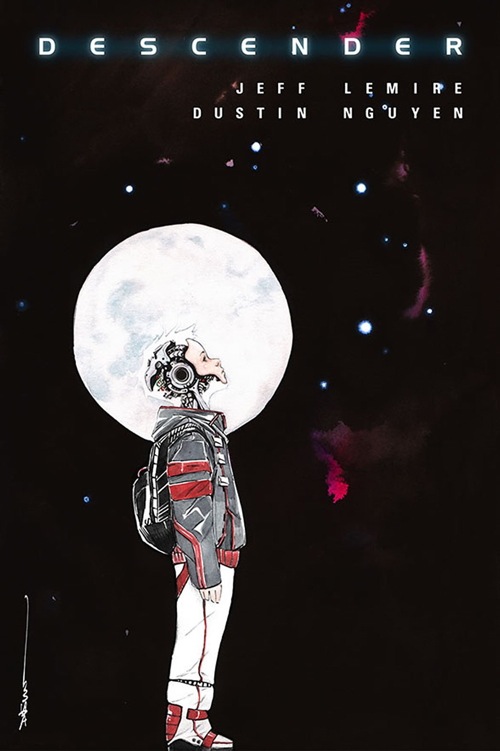
People in Hollywood are STILL liking indie comics. Descender, one of the mighty Image armada by Jeff Lemire and Dsutin Nguyen, has just been picked up by Sony after what THR called “a competitive bidding war.” That could be only four figures…but probably much more figures. The book comes out in March. I’m running out the door so here’s the PR:
Sony Pictures Entertainment announced today that it acquired the feature film rights to Descender, the forthcoming comic book series from New York Times bestselling author Jeff Lemire and New York Times bestselling comic artist Dustin Nguyen. Josh Bratman will produce the film with Lemire and Nguyen attached to executive produce. The first issue of the eagerly awaited series will be published by Image Comics on March 4, 2015.
“It was a competitive situation for Descender, and we are thrilled that it ended with Sony Pictures acquiring the series,” said Lemire and Nguyen. “We know that their film translation will do justice to the original comics, and we are thrilled with their belief in the franchise potential.”
A sprawling, science-fiction space opera full of mystery and adventure, Descender is a rip-roaring, heart-felt cosmic odyssey about a little boy looking for home in a universe that hates and fears him. The incredibly lifelike artificial boy, TIM-21, may hold the secrets deep in his machine DNA to the origin of robots that have decimated entire planets. As a result, he is the most-wanted robot in the universe. Before long the entire galaxy is looking for TIM-21 and his rag-tag group of unlikely companions, as they make their way from one exotic planet to the next with new foes advancing on them at every turn.
Lemire is the creator of the acclaimed graphic novels Sweet Tooth, Essex County, The Underwater Welder and Trillum. His upcoming projects include the original graphic novel Roughneck from Simon and Schuster, as well as Black Hammer with Dean Ormston for Dark Horse Comics, Plutona with Emi Lenox and A.D. with Scott Snyder. In 2008 and in 2013, Lemire won the Schuster Award for Best Canadian Cartoonist. He received The Doug Wright Award for Best Emerging Talent and the American Library Association’s prestigious Alex Award, recognizing books for adults with specific teen appeal. Lemire has been nominated for 8 Eisner awards, 7 Harvey Awards and 8 Shuster Awards. He has also written such titles as Green Arrow, Animal Man and Hawkeye for DC and Marvel Comics.
Nguyen is best known for his work on American Vampire along with numerous Batman titles including: Batman Eternal, Batman: Streets of Gotham, Detective Comics, and most recently, Batman: Li’l Gotham, which has spawned its own line of toys, of which Nguyen is the designer.
Lemire and Nguyen are represented by Angela Cheng Caplan of Cheng Caplan Company, Inc. and represented legally by Allison Binder of Stone, Meyer, Genow, Smelkinson & Binder.
Michael De Luca and Rachel O’Connor will oversee the project for the studio.
Blog: PW -The Beat (Login to Add to MyJacketFlap)
JacketFlap tags: the valiant, mat mindt, Previews, Valiant, Jeff Lemire, Paolo Rivera, Francesco Francavilla, Top News, Add a tag
The Valiant is the lynchpin of Valiant Next, a new hopping on point for readers from Valiant. A prestige format limited series with art by Paolo Rivera, and a variant cover by Francesco Francavilla, there’s no chance we’re not going to run a preview any time it gets into our inbox. The story by Matt Kindt and Jeff Lemire doesn’t hurt either—and they’ve also collaborated on a variant cover.
The Immortal Enemy has crawled out from the black depths of history to destroy this generation’s Geomancer and send Earth back to the Dark Ages! Now…the Eternal Warrior, Ninjak, and Kay McHenry must overcome their worst nightmares before the unlikeliest of white knights rides in to save the day. Will he be enough to battle back the unyielding evil that threatens to plunge the Valiant Universe into the darkness?
Be here on January 21st as the world’s most formidable heroes join a battle ten millennia in the making, only in THE VALIANT #2 – featuring covers by Paolo Rivera (Daredevil), Jeff Lemire (Trillium) & Matt Kindt (Mind MGMT), and Francesco Francavilla (Afterlife with Archie)! An entirely self-contained comics event spotlighting Bloodshot, Eternal Warrior, Geomancer, and a cast of heroes and villains from across the Valiant Universe, THE VALIANT is a visionary new adventure from three of the greatest creative talents in comics today.
THE VALIANT leads into a number of new series that sound intrguing, including,
- IVAR, TIMEWALKER #1 by Fred Van Lente and Clayton Henry in January
- DIVINITY #1 (of 4) by Matt Kindt and Trevor Hairsine in February
- IMPERIUM #1 by Joshua Dysart and Doug Braithwaite in February
- NINJAK #1 by Matt Kindt and Clay Mann in March
- BLOODSHOT REBORN #1 by Jeff Lemire and Mico Suayan in April
Art & Cover by PAOLO RIVERA (OCT141678)
Interlocking Variant Cover by JEFF LEMIRE & MATT KINDT (OCT141679)
Variant Cover by FRANCESCO FRANCAVILLA (OCT141680)
B&W Sketch Variant by PAOLO RIVERA (OCT141681)
Blank Cover also available (OCT141682)
$3.99 | 32 pages. | T+ | On sale DECEMBER 10 (FOC – 11/17/14)
THE VALIANT #2 (of 4) [VALIANT NEXT]
Written by JEFF LEMIRE & MATT KINDT
Art and Cover by PAOLO RIVERA (NOV141677)
Interconnecting Variant Cover by JEFF LEMIRE & MATT KINDT (NOV141678)
Variant Cover by FRANCESCO FRANCAVILLA (NOV141679)
$3.99 | 32 pages. | T+ | On sale JANUARY 21 (FOC – 12/29/14)
Blog: PW -The Beat (Login to Add to MyJacketFlap)
JacketFlap tags: Jeff Lemire, Top News, Hawkeye, NYCC '14, NYCC'14, Marvel, Breaking News, Add a tag
By David Nieves
During Marvel’s “Axel-in-Charge” panel at NYCC, the publisher’s editor-in-chief Axel Alonzo announced that Spring would see a brand new creative team on Hawkeye Vol.2. Marvel enlisted the creative team of Jeff Lemire and Ramon Perez.
Lemire was quoted on the panel as saying, “I think it’s a high water mark for modern comics. I cannot hope to replicate their (Fraction and Aja) success, but I can hope that I can tell my story as best I can… I’m really, really proud of what we’re doing.”
Hawkeye #1 by Lemire and Perez is scheduled for a March 2015 release.
Blog: PW -The Beat (Login to Add to MyJacketFlap)
JacketFlap tags: Valiant, Jeff Lemire, exclusives, Paolo Rivera, Robert Venditti, Top News, Matt Kindt, NYCC '14, Robert Gill, Fred Van Lente, Michael Walsh, Add a tag
Valiant will be set up at NYCC at booth #2028 with exclusives and signings by Jeff Lemire, Matt Kindt, Fred van Lente, Michael Walsh, Robert Venditti, Robert Gill and Paolo Rivera. They also will have an exclusive X-O Manowar toy!
From Thursday, October 9th through Sunday, October 12th, join Valiant at Booth #2028 inside the Javits Center in midtown Manhattan to shop a brand new selection of NYCC-exclusive offerings – including the limited edition X-O Manowar Urban Vinyl Figure by CKRTLAB Toys! The first in a new line of Valiant Urban Vinyl figures set to debut in 2015, the first-ever X-O Manowar stands 5.5 inches tall with 6 points of articulation and comes enhanced with a luster-rich metallic finish, “lightning sword” weapon accessory, and collectible packaging that is perfect for display.
Plus: pick up the X-O MANOWAR #0 NYCC Exclusive Variant, featuring an all-new cover by rising starMichael Walsh (ARCHER & ARMSTRONG, Secret Avengers)! Jump on board here and discover the untold origins of Valiant’s armored Visigoth hero with Valiant’s latest essential zero issue by acclaimed creators Robert Venditti and Clay Mann!
And that’s not all – look for signings and appearances all weekend long from some of Valiant’s biggest talents, including Robert Gill (ARMOR HUNTERS: HARBINGER), Jeff Lemire (THE VALIANT), Matt Kindt (THE VALIANT, RAI, UNITY), Paolo Rivera (THE VALIANT), Michael Walsh (ARCHER & ARMSTRONG), Fred Van Lente (THE DELINQUENTS, ARCHER & ARMSTRONG), Robert Venditti(X-O MANOWAR, ARMOR HUNTERS), and many more!
Then, on Friday, October 10th at 12:15 PM, join an all-star panel of guests for the VALIANT COMICS: THE VALIANT, RAI, X-O MANOWAR AND BEYOND panel presentation! This winter, superstar creators Jeff Lemire, Matt Kindt, and Paolo Rivera launch the year’s most anticipated new series withTHE VALIANT…but what happens next? Find out here as Jeff Lemire (THE VALIANT), Matt Kindt(THE VALIANT, RAI, UNITY), Paolo Rivera (THE VALIANT), Fred Van Lente (THE DELINQUENTS, ARCHER & ARMSTRONG), Robert Venditti (X-O MANOWAR), Editor-in-Chief Warren Simons, and Chief Creative Officer Dinesh Shamdasani lead off an exclusive round of news and announcements, right here at New York Comic-Con! Plus: RAI, X-O MANOWAR, UNITY, ARCHER & ARMSTRONG, QUANTUM AND WOODY, and much, much more!
And the action continues on Saturday, October 8th at 8 PM as Valiant brings the superstar creative team behind THE VALIANT – Jeff Lemire, Matt Kindt, and Paolo Rivera – to New York’s famous St. Marks Comics for an exclusive post-show signing, featuring free THE VALIANT: FIRST LOOK preview editions, and more!
Blog: PW -The Beat (Login to Add to MyJacketFlap)
JacketFlap tags: Image, Breaking News, Top News, Descender, Jeff Lemire, Image Comics, Dustin Nguyen, SDCC '14, Add a tag
 By Kyle Pinion
By Kyle Pinion
Announced at Image Expo this year at San Diego Comic Con, Jeff Lemire’s first ongoing series with Image, Descender, is described thusly:
Ten years ago massive, planet-sized robots called “The Harvesters” materialized without warning and invaded the orbits of all the United Galactic Council’s worlds wiping out entire planets and civilizations before disappearing again. In a fear-fueled response to this machine holocaust, the galaxy blamed millions of robotic companions, whom they suspected of somehow spawning The Harvesters. All robots and androids were immediately outlawed and ruthless bounty hunters called Scrappers were charged with scouring the universe for any surviving robots.
The incredibly life-like artificial boy, TIM-21 may hold the secrets to the origin of The Harvesters deep in his machine DNA—and as a result is the most-wanted robot in the universe. With only his small pet-bot, Bandit and the lumbering mining droid, Driller at his side, TIM-21 goes on the run. Before long the entire galaxy is looking for this rag-tag group of unlikely companions, as they make their way from one exotic planet to the next with new foes advancing on them at every turn.
Lemire and I chatted briefly about this exciting new series as a third part to our earlier discussions about his upcoming DC Comics work and The Black Hammer at Dark Horse. We discussed some of the sci-fi direction of the series and just why the child-protagonist was such a key choice for Lemire and his collaborator Dustin Nguyen.
What triggered the idea for Descender? How long has it been percolating?
Descender actually started as an idea for a company owned character. Then I realized as if changed and grew that it was becoming something totally different and I would be better served to go all the way and make it into a creator-owned project. I’m drawing a 200+ page graphic novel for Simon and Schuster right now called Roughneck, so I knew I wouldn’t have time to draw Descender or The Black Hammer so I decided to try working with other artists whom I admire and want to work with.
With Trillium, Justice League United (to an extent) and now Descender, you’ve started to edge more towards science fiction, is that a major area of influence for you as a writer?
My work has always drifted towards genre. Even the first Essex County had scenes that were steeped in “magical realism” or genre. And I would argue that Sweet Tooth and Nobody were sc-fi too. So I don’t see this as a move towards sci-fi. And having said all of that, Roughneck is probably the most grounded thing I’ve ever done. No genre elements at all.
But, I do see what you’re saying in terms of “space-based” sci-fi. What I liked most about Trillium was the world-building, so Descender will allow me to develop and create not just one alien planet or race, but dozens.
I also seem to be reading more and more sci-fi lately. Dan Simmons has become a big influence. His “Hyperion” books blew my mind.
It’s difficult to pave new ground in science fiction, what are you hoping to contribute to the genre with this series?
Honesty, who knows? I don’t go into something trying to make a big statement or contribute to the genre, I just try to tell a good story. One that I like and would want to read. What it becomes beyond that is beyond my control.
I will say that I intend to use space opera here the same way I used the post-apocalyptic genre in Sweet Tooth. The genre elements will be the backdrop and the focus will very small, character based work.
What is it like to write from both the perspective of a child and a being that isn’t quite human?
I’ve always enjoyed writing kids. Right from the first Essex County. It just seems to be something I’m comfortable with and something that comes naturally to me. TIM-21, the lead character in Descender, is no different. He is probably the most “human” character in the book. At least at the beginning of the series. That may change as the book unfolds.
Androids aren’t often portrayed as children, ‘AI’ excepted, what made you decide to make Tim a child? And what differentiates a child android from an adult android in this context?
See above. I love writing kids and I love exploring story through a child’s point of view. That sense of innocence and wonder and awe. What a great way to explore big sci-fi ideas. There are so many different types of robots and androids in the book, not just human-looking androids or adult/child androids. And they all have different functions, personalities and motives.
What is the aesthetic of the setting? We’ve seen outer-space set stories in western like backdrops, steam-punk, Blade Runner type dystopias, clean minimalism and so on. Is there a particular direction that informs the universe of Descender?
All of the above. Each world and each planet they come to will have a different aesthetic and look. It;s a great way to keep the story fresh and let Dustin really cut loose. One planet may be a aquatic planet, the next issue they may be on a space-port that is like deep space old west. It just keeps reinventing itself.
What do you think, or hope, Dustin Nguyen will bring to this overall vision? Was he instrumental in the development of the concept, or did he come on-board afterwards? If the latter, did it change in any significant fashion from his involvement?
Dustin brings an incredible amount of humanity to the characters. Just look at that promo image. The look on TIM-21′s face is something I could never describe in a script. It’s just so perfect. He is also an incredible visual story teller.
It’s funny, I like to write kids and i knew from his sketchbooks, Lil’ Gotham etc… that Dustin likes to draw them. So it was a perfect match.
Does Descender center on humanity specifically, or will readers get an opportunity to see alien races as well?
Humanity is only one race that is represented in the book. The galaxy we focus on has a dozen planets, each with it’s own race and culture.
Are there any particular scenes or moments that you’re very excited for people to read?
The opening sequence in issue 1 is pretty “big” in scale. I can’t wait to see how Dustin draws it. And the cliffhanger in issue 2 is pretty good too.
Descender will debut in March 2015 from Image
Blog: PW -The Beat (Login to Add to MyJacketFlap)
JacketFlap tags: Dark Horse, Breaking News, Jeff Lemire, Top News, SDCC '14, Add a tag
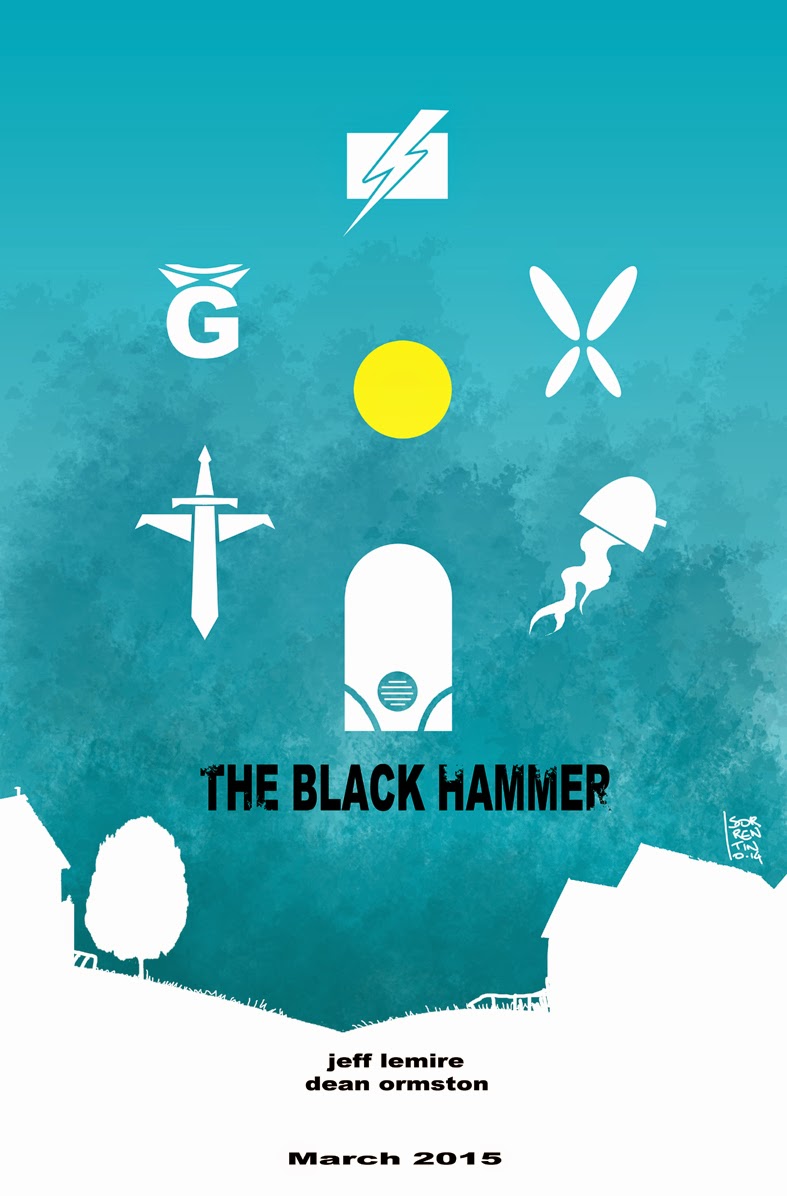 By Kyle Pinion
By Kyle Pinion
In part two of our weekend long discussion with Jeff Lemire, we sat down with him to discuss his newly announced Dark Horse creator-owned title The Black Hammer to find out more about the influences of the title, its potential metaphorical under-pinnings and why he chose to go with Dark Horse for this series specifically.
When you’re getting into a creator owned title like The Black Hammer, I’m sure there’s a sense of freedom due to your direct ownership of the book, but is there a sense of added pressure of finding its audience as well?
I don’t feel a lot of pressure, not really. I just get excited about the idea and want to work on it. I stopped worrying about those kinds of things a long time ago. You just make the books you want to make and people will like it or they won’t. As long as you’re happy with it, who cares?
Why Dark Horse for this particular title? I know you have a new book (Descender) with Image, and all your upcoming work with Valiant. Why was Dark Horse the right publisher for The Black Hammer?
There’s a couple of reasons. I was at DC exclusively for four or five years, coming out of being for only one company for that long, there was certainly a sense of wanting to try new things and wanting to work with different people. Not being locked in with one person or one company again right away. With Dark Horse, one of my best friends is Matt Kindt, and they had done so well with Mind MGMT and Matt was very happy with how that book has been handled so I thought it would be cool to come over and do a book with Matt.
The actual premise of The Black Hammer has been talked about at length elsewhere at a number other sites, so what were some of the influences that led to getting to that point?
Well, the concept itself kinda reveals the influences, its about a group of superheroes who come from every era of comics. And they’ve been wiped out of continuity, and one day they wake up in this small farm and they have no idea why they’re there or how to get back. The influences are all there, you have a different character from each era of comic history that I love. You have a character named “Madame Dragonfly” who is sort of the embodiment of all those great 70’s House of Mystery/House of Secrets horror comics. You can see everything I love growing up is in there, which is kind of mashed with the stuff I normally do in my independent work like in Essex County with a focus on family and small town life. More quiet, character based storytelling. It’s mixing those two things together into something hopefully unique.
Is this the kind of story where the majority of the “super-hero action” takes place in flashback?
I guess you’d call them flashbacks. The bulk of the book is very much their life now, taking place in the small town, ten years after they arrived. They’re trying to live as normal people, a normal family, despite how strange they are and how strange their background is. That’s the bulk of the book, the in-continuity adventures and stuff from their past is just that, they’re vignettes or flashbacks that reveal more about their history and their relationships with one another and things like that.
Is there an ending already in place or planned?
Yeah, I know the ending just like how I knew Sweet Tooth was going to end. I knew the last page of that and I know the last page of this as well. But between the beginning and the end, it’s very fluid. There’s a lot of room to explore different things along the way. So, I know the end-point, but how long the whole series will be, it’s hard to say.
Is it a great amount of fun to write in different character voices from different eras?
Yeah, it’s definitely fun, but there’s also a balance…I had to experiment a bit. When I’m writing something from the 30’s, do I go full-on and try to emulate the writing style completely and go pastiche or do you adapt the sensibilities of that with a more modern voice? I just tried to find a balance there.
Is there any metaphorical material that you’re looking to mine into, ala Kingdom Come?
There is that, but I don’t really want to talk about it…it’s not a spoiler thing, but my thoughts and feelings on superhero comics will probably become pretty clear by the end of this, so we’ll just leave it at that. There’s stuff I love and stuff I don’t, I have opinions. There’s certainly a commentary about the state of the industry. It’s pretty blatant. But also, I have a love that stuff, for all of comics history, and I think this is a pretty sincere love letter to comics as well. It’s not just satire or commentary, it’s me kind of trying to show all the stuff I used to love to read.
You’ve had this idea for quite some time right?
It’s funny, this project has been gestating longer than anything I’ve ever done. I finished Essex County and I started working on this. You’ll be able to see the influence of Essex County in it right away, it very much is Essex County but with super-heroes. I’m not ashamed to say, that’s pretty fun to write. So that was about 2007-2008 when I started working on it, and I was going to draw it as a graphic novel. Then I started to work with Vertigo and DC and my career kind of took off doing other things like Sweet Tooth, and now I’m working on new things that I’m drawing myself. So, it just became obvious that this was something that I really wanted to do, but that I wouldn’t have time to draw the whole thing myself and that was part of the decision to come to Dark Horse and find an artist like Dean.
What does Dean bring to the book that is different from what you would have done had you drawn it yourself?
It’s very different, I met Dean at Thought Bubble, a festival in the UK, about two, maybe three years ago. But I had known his work before that, I followed his work at Vertigo and was a fan. I really admired his stuff, I felt it was very graphic, very bold style. He also has a sense of strangeness, like he can draw monsters, but with a strange humanity to them. I thought it would be interesting to filter superheroes through that strange dark voice that he has, I knew it would be unique and that it wouldn’t look like a normal super-hero comic. It would look like a strange super-hero comic. It can’t just be a thing I’m emulating, it needs its own voice for sure.
When we see the flashbacks, will different styles emerge?
We’re still very much in the process of deciding how far we go with that. How do we use color? Does he completely alter his drawing style for each era? So those are the creative things we’re sort of in the process of working out. I’m not sure what the answer is yet, as I’ve written two scripts and he’s still in the design stage. We’ll see how it plays out.
Having spent so much time at DC under your exclusive, you’re now spread amongst several different universes per se, is that an overwhelming feeling at all?
It’s fun, I love DC. I grew up reading DC and I have nothing bad to say about my time there. They treated me really great. There’s stuff I’m proud of and stuff I’m not so proud of. That just comes with doing a lot of stuff. It’s cool to play in new playgrounds like the Valiant stuff with new characters and a much smaller universe that I wasn’t familiar with. It’s brand new to me, so that’s fun. And, with this book, I’m creating my own comic book universe that is a combination of my own sensibilities and pulling things from history. It’s not so much overwhelming as it is fun. It’s fun to have fresh starts, new people to work with and new things to play with.
And The Black Hammer is coming in February 2015?
I believe March.
Blog: PW -The Beat (Login to Add to MyJacketFlap)
JacketFlap tags: Top News, Scott Snyder, Ray Fawkes, Kyle Higgins, Marguerite Bennett, SDCC '14, DC, Batman, Jeff Lemire, DC Comics, Daniel H Wilson, Dan Jurgens, Batman Eternal, James Tynion IV, Add a tag
 By Kyle Pinion
By Kyle Pinion
One of the bigger initiatives to come from the Big Two this year is the advent of the three weekly titles from DC Comics: Batman Eternal, Futures End, and Earth 2: Worlds End. With the latter on the verge of release, and Batman Eternal continuing to perform well in DC Sales Figures, members of the various creative teams for the titles gathered for DC’s Weeklies panel. Writers on hand included: Scott Snyder, James Tynion IV, Ray Fawkes, Kyle Higgins (Batman Eternal), Dan Jurgens, Jeff Lemire (Futures End), Marguerite Bennett and Daniel H. Wilson (Worlds End).
The panel, moderated by Bob Wayne, was neatly delineated with each title receiving its own focus time. With that, things were kicked off with Batman Eternal.
- Scott Snyder thanked the attendees for picking up Eternal and making it such a sales success: “We came up with an idea that we felt would be so big and infect that neighborhood in Gotham. I helped write the first few and I’ll come back and do the last, but it’s these guys that are just killing it on the series. The great thing about it is that it’s not happening in a small corner.” Snyder also stated that when Batman returns in Issue 34, it will deal with the fall-out of Eternal, flashing forward past the Weekly time-frame, with the consequences of the series reverberating through a number of books.
- Fawkes discussed the breakdown of writer tasks and interests within their team, stating that he specifically will be writing the sub-plot dealing with Jim Corrigan and Batwing through the duration of the series. Higgins also chimed in, mentioning that despite coming onto the series late (replacing outgoing writer John Layman), his arc would begin in the 30′s and he would be bringing back The Architect in those issues (a character he co-created with Snyder in the Pre-New 52 Gates of Gotham mini).
- In describing the break-down of the series’ acts Higgins added: “The way that we’re structuring this is three acts. The end of the first big act of the series will be right around issue 20. Section two tees up something new and different with different characters. That’s the stuff I’m doing; I’m working with Jason Fabok to tell the end of section two.” Snyder added in that each of the acts are designed to raise the stakes until the city is on the edge of destruction while reaching a giant crescendo in its finale.
- Moving on to Future’s End, the panelists were a little less verbose regarding future plans, with a big as of yet unannounced event on the horizon, but they discussed the dynamics of the “incredibly unlikely group of writers” that make up their team. With Lemire pointing out that the unusual mix of writers gave way to the eclectic cast that makes up the title’s roster.
- Jurgens and Lemire were especially quick to praise Ryan Sook as the unsung fifth member of their team, who sat in on their writing meetings and created character sketches based on the ideas being bounced around.
- Regarding writer specific favorites, Lemire mentioned that it was Brian Azzarello who was gravitating towards Terry McGinnis, and this in turn led to a discussion amongst the panelists as to whether Terry is called Batman or Batman Beyond in the book proper. (A: He’s not called anything as of yet, as he has few associates per Lemire).
- Lastly, the panel’s focus turned to Earth 2: Worlds End, with “show-runner” Wilson describing the series as: “We’re in a situation where we’re continuing what’s going on in Earth 2 and there are some catastrophic events on the way and we’re bridging into the future. On the ground level, we have characters like Dick Grayson who are surviving on the ground, then you bump up a bit and you have the World Army, then, to the top level. Having all of this play out at the same time is really interesting; figuring out who deals with what and what’s happening to the world.”
- Both Bennett and Wilson agreed that the series will be shifting its gaze less to the big picture and more to the people within it, with Bennett specifically citing Batman Eternal as a huge influence on her work here: “It’s not just a story of attrition or the death of the world, it’s a story about the people in that world. It’s a story of triumph, of love and hope that’s coming out of the ruins.”
- Both writers also wanted to stress the importance of the series having a sense of accessibility, and the first issue will provide an intro as to the happenings within the Earth 2 monthly title.
- Lastly, Wilson mentioned that readers should be on the look-out for them to address some unanswered questions, particularly in regards to the fate of Sam, Alan Scott’s partner.
- The panel then moved into the Q&A portion, which begun with an elaboration on who is tackling what character in Futures End; Lemire is writing Frankenstein and any space characters, Giffen has the Cadmus team and Grifter, Jurgens is writing Tim Drake and Superman, and Azzarello oversees Terry McGuiness.
- Regarding any restrictions on ideas that the Eternal crew might have proposed, they said there weren’t any, and that in issue 20 the status quo will shift tremendously. With Tynion adding in: “We’re marching closer and closer to the end with every single issue, and issues #21-23 is the real turning point to set up that next section and things are going to start changing rapidly. Gotham is going to become very dangerous very quickly.” Fawkes also added that characters like Killer Croc, Jim Gordon, and Batwing will come out of the events of Eternal with new lives.
- On what the writers of Eternal would remember from the series as a whole: Snyder answered that the title is key theme. With Fawkes emphasizing this point, stating that the team wanted readers to believe this is the story that would destroy Batman, but once they reach the conclusion they’ll get the meaning of the title in that context.
- Snyder closed the panel stating that the coordinated work amongst the writers on Eternal affected the narrative of his upcoming Batman arc “Endgame”: “When I seehow much they’re doing, it was like, ‘Let’s make Batman do that too.’ ‘Endgame’ is about taking Batman and giving readers a Gotham they’ve never seen before.
Blog: PW -The Beat (Login to Add to MyJacketFlap)
JacketFlap tags: Top News, SDCC '14, Justice League United, DC, Breaking News, Jeff Lemire, Green Arrow, Add a tag
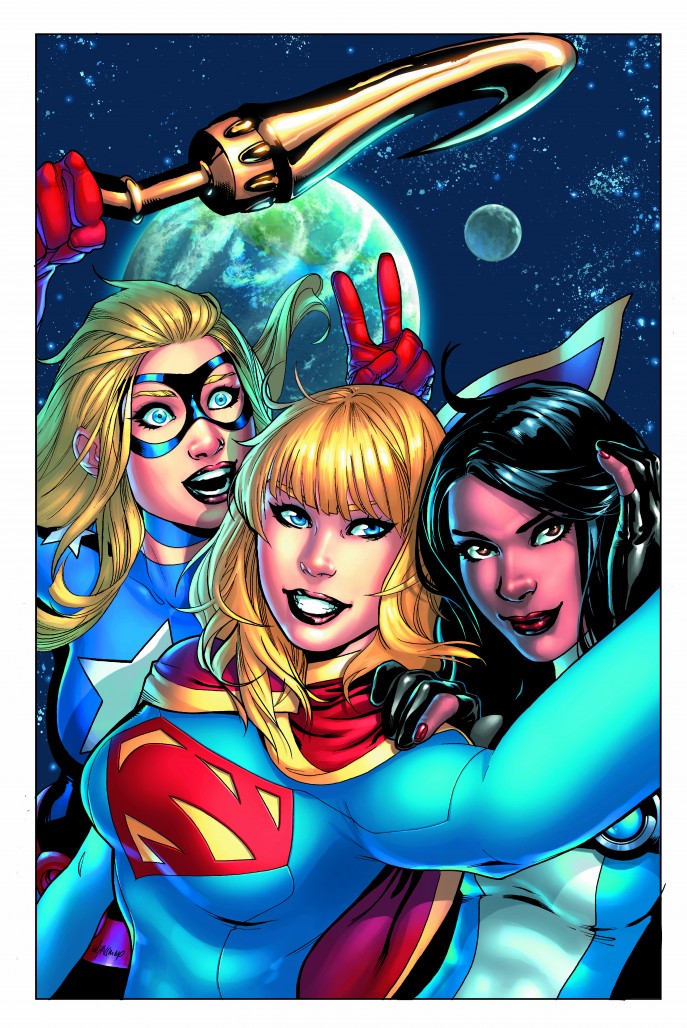 By Kyle Pinion
By Kyle Pinion
While Jeff Lemire has recently been making waves with the announcements of his upcoming The Black Hammer at Dark Horse and Descender at Image, his DC work continues to be amongst the premiere offerings of the publisher. I had a chance to sit down with Lemire to discuss what’s coming from him in The New 52.
Kyle: Congratulations on another well-deserved Eisner nomination for Trillium. It’s kind of funny to think about this – Trillium is sort of an opening shot in this line up of sci-fi titles that have started to release from other creators. Where do you see Trillium sitting in this “new sci-fi revolution” we’re seeing in comics?
Jeff: Yeah, well I think Saga was the first shot. It was so inspiring to see a sci-fi book do so well. I think every nerd has a sci-fi story they want to tell eventually, and this is the time. Where does Trillium sit? I don’t know – it just came out so you kind of have to look back in maybe 5 years from now to see where it stands and if people are still talking about it. I tried to experiment a lot and tried to tell an emotionally affecting story set in a big, cosmic setting. It’s hard to analyze your own work when it’s so fresh still.
Kyle: And I know you have a special attachment to the stuff you draw yourself. Do you have plans to do more of that soon?
Jeff: Yeah, I’m working on a graphic novel right now for Simon & Schuster that I’m drawing that’ll come out next fall. Then I’ll probably do another ongoing monthly thing that I’ll draw after that.
Kyle: Justice League United is one of my favorite titles coming out of DC right now. It’s very exciting and a lot of fun, the origins of that title though – it changed at one point from Justice League Canada when it was announced initially to Justice League United. Is there a background story as to why that changed?
Jeff: No, it’s pretty simple. I was really just taking over Justice League America and I wanted to move the team to Canada, which they were totally cool with, so we changed the title to Canada and then as we got closer to publication, I think they realized having Canada in the title might be a little bit too specific for international readers and American readers. So it just made sense. We want to get as many people reading the book as we can, and it didn’t affect the content of the story at all, so it was cool with me. No drama.
Kyle: The tone of Justice League United is very DC animated universe-esque. Was there an outward attempt to aim for a more fun tone?
Jeff: Yeah, very much. I feel like there are so many super hero comics that are very serious and take themselves very seriously. Green Arrow, for example, is very much that, I write some of that stuff too. But I think there needs to be more balance, and I think sometimes we forget that these are super hero comics. They should be fun, and the characters should be having fun. And I really tried to bring that back. A lot of the stuff that I read when I was younger, that I gravitated towards, had a sense of humor to it, and a sense of fun and wonder.
Kyle: It’s kind of opening up a lot of the cosmic stuff of the New 52 as well. Was that one of your long term goals with the series?
Jeff: Absolutely, yeah, that’s some of my favorite stuff in DC history is all the cosmic stuff. It was one big corner of the universe that hadn’t really been exploited too much aside from the Green Lantern titles, you know, so I felt there was a lot of potential there. I’m really getting into Raan and Thanagar and the politics there and seeing other alien races and the Legion of Super Heroes coming, which blows everything wide open.
Kyle: So what can you tell us about the Infinitus Saga?
Jeff: Ultra the Multi-alien, the child that they found in the first arc was a big part of that moving forward, and what Ultra is destined to become is something that has a huge impact in the 31st century. So we see a few Legionnaires come back to deal with Ultra, and that kind of spirals from there into a massive cosmic saga. I grew up reading Legion and the great darkness saga so this is my attempt to throw down the gauntlet and do one of those big sprawling space opera stories with like 40 super heroes running around the galaxy. It’s been a blast.
Kyle: Can we expect to see your Legion further beyond this story, possibly?
Jeff: I don’t know. I would love to. That’s definitely a property I have a lot of ideas and opinions on. I think there’s a lot of untapped potential right now. So that would be something I would definitely be interested in. Who knows?
Kyle: I hope so. Do you have a favorite Legionnaire, Jeff?
Jeff: I do. And it’s Ultraboy. Or Brainiac 5. Or Mon-El. Those 3.
Kyle: You get one choice sir!
Jeff: I always dug him (Ultra Boy) more as a kid, I love that idea that he was as powerful as Superman but he could only use one at a time, that’s so fun. It kind of limits him. Superman can be too powerful sometimes to write plausible threats for him, whereas Ultra Boy had that power but it was limited in a really fun and interesting way. He was very charismatic as well.
Kyle: The storytelling potential of that is pretty strong. I always liked the fact that his powers comes via a whale, being named Jo Nah.
Jeff: Those costumes are so cool, and for some reason his costume always got me. I just liked drawing it as a kid.
Kyle: So we can expect some good Ultra Boy scenes perhaps?
Jeff: Yeah I haven’t really had a really good one yet. I’m on the fourth script of a six issue story so I’ve got to really find a good moment. You’ve got to find one moment for everyone, because there’s so many of them. I’ll find his.
Kyle: And that’s going to run through the next, what, 5 issues of JLU?
Jeff: Yeah, it starts in the Annual. Then it goes for 5 issues after that. So 6 issues total.
Kyle: Is Mike McKone going to be penciling?
Jeff: No, Mike’s done on Justice League United. He’s moved on. Mike, he’s awesome to work with, I love him, but he always knew he was only going to do the first arc because I think he has some other projects he wanted to get done. So we’re bringing in an artist named Neil Edwards from the U.K. I think Neil worked with the same studio as Bryan Hitch, so they have a common thread in their style, and he’s great. He’s been great so far.
Kyle: Equinox is going to have her profile increase over the next few issues as well. Are you excited to have your own character that you created taking the forefront of the story?
Jeff: Very much so, there are a couple of cool things; like the Futures End issues where we jump 5 years into the future. I got to play with her and where she is 5 years from now, so she’s much more confident and much more entrenched in the larger DC universe, playing a bigger role, so that was fun. And in the Legion story, she’s someone who’s lived in a small isolated community, and all of a sudden she’s in space with 40 other alien super heroes, and her reaction to that is a lot of fun to play with, and her being an aboriginal woman and meeting Dawnstar who is an aboriginal woman from the future, and learning that she’s a huge inspiration for the next thousand years, is this really great moment that I’m really proud of.
Kyle: have you heard much from the basis of the character, Shannen Koostachin’s family?
Jeff: Yeah, it was kind of misreported. The character wasn’t really based on Shannen. Shannen – that story is very inspiring – she was a young activist who was killed, and I wouldn’t presume to try to tell her story in a super hero that without her family’s blessing or anything. The idea of creating a teenage character who was based in the same area, she is certainly one of the inspirations for her, but the character wasn’t really based on her.
Kyle: It’s good to have that clarification! So, with the little bit of time we have left I’d like to talk to you about Green Arrow. It’s a fabulous run, probably one of my favorite DC comics coming out right behind JLU, it’s coming to an end sadly. Was it always planned it would end at issue 35?
Jeff: No, I didn’t really know when it would end whe? I started it. I knew there was the big Outsiders story I wanted to tell and the Richard Dragon story, so I just kind of let it happen at its own pace. There were a couple of things that Andrea (Sorrentino) wanted to tackle project-wise and I think he was really a collaborator in every sense on this book, a real co-story teller, and I didn’t want to do the book without him. I feel like we had created something special together. I know he was anxious after 20 issues to move onto something else, move on to a new character and keep things fresh for him, so I knew that was coming. And the Futures End thing provided us with a unique opportunity to literally tell the end of Green Arrow’s story. Because he dies in Futures End, I could literally tell the story from my last issue to his death, the last 5 years of his life, and finish his story essentially. So that’s kind of a unique thing, because usually you just pass the character on so they can tell the rest of his life in one big issue.
Kyle: You are actually going to be able to hang on to Green Arrow and Animal Man and JLU, and you’ve got Frankenstein in Futures End. Isn’t it funny that you seem to have the same characters following you throughout the New 52?
Jeff: You fall in love with them, you invest in them, and you put a lot of yourself into them. You spend months and months and sometimes years writing the characters and it’s hard to let them go, you know? So whenever you can keep them and keep evolving them as characters, I always grab those opportunities.
Blog: PW -The Beat (Login to Add to MyJacketFlap)
JacketFlap tags: Dark Horse, Jeff Lemire, Top News, black hammer, dean ormston, Add a tag
 Jeff Lemire has forged himself quite a mainstream comics career since emerging from the indie scene with his still beloved Essex trilogy. And now he’s expanding his workload with BLACK HAMMER, a new creator owned series coming from Dark Horse later this year. The artist is Dean Ormston. Lemire tells us:
Jeff Lemire has forged himself quite a mainstream comics career since emerging from the indie scene with his still beloved Essex trilogy. And now he’s expanding his workload with BLACK HAMMER, a new creator owned series coming from Dark Horse later this year. The artist is Dean Ormston. Lemire tells us:
BLACK HAMMER follows a group of oddball superheroes who have been “wiped out of continuity” after an earth shaking cataclysmic “event” and wake on a farm in a mysterious small town.
They were the greatest heroes of a lost era, Golden Aged crime buster, ABRAHAM SLAM, interstellar adventurer COL. WEIRD and his robot sidekick TALKY-WALKY, BARBALIEN warlord From Mars, GOLDEN GAIL, America’s super-sweetheart, MADAME DRAGONFLY, mistress of the macabre, and BLACK HAMMER invincible champion of the streets.
They have no idea where they are or how to get back home. All they know is they can’t leave the borders of the seemingly idyllic small town.
The book follows the strange cast of characters as they work to assimilate themselves into quiet small town life, living as a bizarre surrogate family on the farm, all the while try to uncover the many mysteries of the farm, where they really are and how to get back home.
Blog: RabbleBoy (Login to Add to MyJacketFlap)
JacketFlap tags: Book Reviews, graphic novel, comic, Jeff Lemire, Alan Moore, S.M. Vidaurri, Void, Scott Snyder, Chris Mooneyham, Frank Barbiere, Dreamstone, Fabian Gray, Five Ghosts, Lauren Affe, Leage of Extraordinary Gentlemen, trade paperback, Add a tag
After a tragic encounter with an artifact known as “The Dreamstone,” infamous treasure hunter Fabian Gray is possessed by five literary ghosts and granted access to their unique abilities.
Get this on Amazon Five Ghosts Volume 1: The Haunting of Fabian Gray TP
From Booklist
Thanks to a popular Kickstarter campaign, comics fans can enjoy a story so unique yet so familiar it’s like slipping on a pair of old slippers worn by a stranger. Famed treasure hunter Fabian Gray has the remarkable ability to channel ghosts of five archetypal figures—the wizard, the archer, the detective, the samurai, and the vampire—a power that comes in quite handy in the midst of his swashbuckling exploits. Barbiere’s writing and Mooneyham’s art are reminiscent of classic adventure comics, crammed with rubies to snag, helicopter ladders to lunge after, and biplanes that crash into deep jungles full of magic-wielding cults, all wrapped up in a plot dripping with revenge, regret, greed, and deep hubris. But Barbiere and Mooneyham aside, it would be a mistake not to acknowledge the book’s colorist, S. M. Vidauri, whose muted tones and deep purples mix the nostalgia of iconic adventure tales with the rich, heavy visuals of contemporary comics, such as Alan Moore’s League of Extraordinary Gentlemen, Scott Snyder’s American Vampire, and Jeff Lemire’s Animal Man. –Ben Spanner
Blog: PowellsBooks.BLOG (Login to Add to MyJacketFlap)
JacketFlap tags: Ask a Book Buyer, Nicole Georges, Rabih Alameddine, Margaret Atwood, Orhan Pamuk, Ann Patchett, Kelly Link, Jeff Lemire, Karen Russell, Scarlett Thomas, PowellsBooks.news, Cheryl Strayed, Add a tag
At Powell's, our book buyers select all the new books in our vast inventory. If we need a book recommendation, we turn to our team of resident experts. Need a gift idea for a fan of vampire novels? Looking for a guide that will best demonstrate how to knit argyle socks? Need a book for [...]
Blog: PW -The Beat (Login to Add to MyJacketFlap)
JacketFlap tags: Jeff Lemire, DC Comics, Green Arrow, Gail Simone, Top News, Guillem March, Greg Pak, Andrea Sorrentino, andy kubert, Darkseid, Derek Fridolfs, Superman, Poison Ivy, The Joker, Villains Month, News, Reviews, DC, Add a tag
DC sent along a lovely pack of review copies for Villains Week, and I feel like it’s only fair that I read through all of the ones out this week and review ‘em. I’ll go from my least favourite to my favourite, ending with my favourite of this first lot. And hey! If DC send along a second selection next week, I’ll review those ones too!
Slight spoilers below, but nothing particular.
One thing that you should note is that some of the comics take place as part of Forever Evil – the Batman and Flash comics, it seems – whilst the Green Lantern/Superman issues are more general. So if you pick up Poison Ivy or Grodd, it’ll make reference to two of the more immediate moments which occur in Forever Evil #1. Keep that in mind as you buy the comics – they’ll all make sense, but some will be directly following on from the main story whilst others are unconnected origin stories.
Desaad
Paul Levitz (w), Yildiray Cinar (a), Jason Wright (c), Carlos M. Mangual (l), Anthony Marques, Mike Cotton (e)
I’m astonished this issue was made. Impossible to understand as a standalone story, it features a sequence about a mass shooting which is in extremely poor taste. The rest of the comic doesn’t explain who Desaad is or what’s going on, and is filled with concepts and ideas which are neither fleshed out nor coherent. The art tells the story – what little there is – well enough, but there are some dodgy character designs going on. I didn’t care at all about Desaad by the end of the issue.
Relic
Robert Venditti (w), Rags Morales (a/i), Cam Smith (i), Andrew Dahlhouse (c), Dave Sharpe (l), Chris Conroy (e)
There’s an interesting story in here somewhere, but the artistic choice made here turns an origin story into a complete chore to read. Every page is a splash page from Rags Morales, and he chooses some absolute clunkers. The first page shows a pretty galaxy with an arm floating into the left frame. What’s going on? Who knows. It’s boring.
Morales doesn’t make any of the concepts in Venditti’s script work, and his character designs are uninspired and uniform. Andrew Dahlhouse does his absolute best to clean up this mess, but it’s a lost cause. I can see that Venditti’s story would be interesting, if only the comic had been told sequentially instead of as a series of misconnected splash pages.
Joker
Andy Kubert (w), Andy Clarke (a), Blond (c), Jared K. Fletcher (l), Katie Kubert (e)
As you might expect, there’s really no reason to try and offer any backstory to The Joker. This issue tells a nonsense side-story from some point in Joker’s past, during which he has some flashbacks to his childhood. Really, any attempt to flesh out the past of the character is always going to flop – the more we know about Joker, the less interesting he is. As a result, the issue flails with an un-involving main story which bombs the final gag, and flashbacks which take away from the story entirely.
Andy Clarke’s artwork is lovely, as always, although the weak script means it’s very difficult to determine how some scenes are meant to be interpreted. There looks to be some intent at offering a subtext, but this is only conveyed in the art and not the script. It seems as though one of the supporting characters is secretly working at a cross-purposes, but there’s only so much the art can do without clear dialogue. Clarke attempts to elevate a completely throwaway storyline, but can only offer a very pretty, very weak, story.
Grodd
Brian Buccellato (w), Chris Batista (a), Tom Nguyen (i), Wes Dzioba (c), Wes Abbott (l), Kyle Andrukiewicz, Joey Cavalieri (e)
Grodd’s a curious character. The main reason he exists as a villain is because gorillas are scary, I guess? This is an issue which struggles because the character comes into this issue with a goal that doesn’t make any sense. Every single character in the comic calls him out for his strange decisions and ambition, and he basically hits them until they give up trying. Does it forgive a strange character if every other character CALLS him strange? I’m not sure on that.
Chris Batista, to me, is one of those artists DC have never appreciated quite enough, and his work here is really good fun – not everybody can draw an expressive gorilla. Not a bad issue by any means, but one which doesn’t manage to quite fix the character.
Cyborg Superman
Michael Alan Nelson (w), Mike Hawthorne (a), Daniel Brown (c), Carlos M. Mangual (l), Rickey Purdin (e)
Interesting, this one. It’s going to upset fans of the character, but tells a reasonably involving story. Framing two sequences against one another, the final few twists are very obvious, although Nelson mines from really fun laughs from Cyborg Superman’s sadistic quest for a sidekick. I don’t know how this actually fits in with established continuity – it would seem to wreck Green Lantern’s past storylines, for example – but we’ll have to see. It’s a perfectly fine comic, and Hawthorne’s art is like somebody put Jamie McKelvie and Stuart Immonen’s art in a blender. Good, in other words.
Two Face
Peter J. Tomasi (w), Guillem March (a), Tomeu Morey (c), Dezi Sienty (l), Darren Shan, Rachel Gluckstern (e)
Featuring an astonishingly drawn and coloured opening sequence between Two Face and Scarecrow whilst both are stood ON the Bat-Signal, the issue sadly then moves into familiar territory for the rest of the issue. Morey’s colouring is spectacular though, especially in the early stages of the issue. At first it feels like there’s a definite plan for the issue, until the story turns into a typical Two Face/anti-hero narrative. There’s nothing especially new here, especially for those who have read No Man’s Land and other stories where Two Face similarly has no Batman opposing him.
It’s entertaining, but it also feels like Tomasi is killing time for the last half of the page-count. There’s some good puns about duality, though, which is half the battle in a Two Face story.
Bizarro Superman
Sholly Fisch (w), Jeff Johnson (a), Andy Smith (i), Javier Mena, Jordie Bellaire (c), John J. Hill (l), Ricky Purdin (e)
This is actually a Lex Luthor story, and it follows familiar ground in an entertaining way. No other character in comics quite has that mix of ambition, arrogance and disregard that Luthor has, and Fisch nails the character. Bizarro Superman himself is a strange creature in the comic – his arc is obvious from the moment he appears. Interestingly enough, Bizarro at no point takes on the design he has in the cover – this is a step far removed from the ‘classic’ rendition of the character.
But despite the by-numbers nature of the narrative, the creative team fit enough touches of silliness and character into the story that the comic works very nicely indeed. I was surprised to find I enjoyed the comic so much, but it was a really solid issue.
Ventriloquist
Gail Simone (w), Derlis Santacruz (a), Karl Kesel (i), Brett Smith (c), Dave Sharpe (l), Katie Kubert (e)
Very much in-tone with her run on Suicide Squad, Gail Simone’s story here puts focus on different mindsets of villainy. One thing the writer has excelled at recently has been creating villains who do evil acts no other villain would do – her Deadshot felt like a unique person rather than a sarcastic goon with a gun, and she’s created some of the most genuinely unsettling villains of the last few years. So it is again with Ventriloquist, which focuses on the second iteration of the villain, Shauna Belzer.
Carefully told, even if it does require a rather large suspension of disbelief towards the end, the story gives us a version of the characters – both ventriloquist and dummy – which keeps readers surprised and unprepared for what might happen next. And when Simone does leave a blatant piece of foreshadowing in the story, she does it to drum up tension and let readers stay one step ahead of the characters. It’s a well-done story, which takes an (probably rightfully) underused villain and give them a bit of purpose and character. It might be deeply silly, but there’s a deadly slice of horror tucked away in there too.
Count Vertigo
Jeff Lemire (w), Andrea Sorrentino (a), Marcelo Maiolo (c), Rob Leigh (l), Harvey Richards, Will Moss (e)
A considered and underplayed issue, Green Arrow’s team make the most of this opportunity to build up one of the character’s most famous villains. Despite a slightly silly design, the character gets a much-needed redevelopment and sense of purpose which feels genuinely menacing. This doesn’t feel like a villain who is insane, but rather a methodical and calculated man who realises that breaking a moral code is preferable to getting left behind.
Sorrentino and Maiolo do some more wonderful work on the issue, continuing their incredible run of form. Sorrentino is the most distinctive and impressive artist at DC, and creates a wonderful sense of space in his work. On one page, for example, he breaks the story into ten page-width boxes, but without any of them feeling cramped on unintelligible. He does masterful work with POV framing, as well – he has an innate sense of perspective which makes it feel as though we’re looking directly out the eyes of the character, without things seeming like they’re overly-crafted and false.
It’s a very very strong issue indeed. Lemire unfolds an inevitable story as his own leisure, and leaves us with the indelible impression that Count Vertigo just became one of DC’s finest.
Poison Ivy
Derek Fridolfs (w), Javier Pina (a), John Calisz (c), Taylor Esposito (l), Kyle Andrukiewicz, Joey Cavalieri (e)
Like with the Two Face issue, this is an exploration in what Poison Ivy does when Batman isn’t around. And again, it’s basically what happened in No Man’s Land. The creative team manage to spread that idea out, however, and fill in some great details about the character and her origin. Also, there’s something quite enjoyable about seeing the character cut loose and have fun, because unlike most other Batman villains, her goal is philanthropically sociopathic. Fridolfs details how her ambitions are almost-so-close to being understandable, and Kalisz’ colours actually go a long way towards aiding that.
In the flashback sequences his colours highlight the character as a total innocent, in bright, warm pastels which makes the reader feel empathetic to her. Pina’s artwork is also excellent, presenting the character over the years as she ages – young and adult Ivy look like each other. I have a soft spot for the character, but the issue doesn’t rest on that hope. Instead, it offers a coherent origin story which binds the character’s personality together and leaves her in a stronger position than before.
Darkseid
Greg Pak (w), Paulo Siquiera, Netho Diaz (a), Hi-Fi (c), Dezi Sienty (l), Anthony Marques, Eddie Berganza (e)
The best issue so far, and likely to be the best of the initiative in general. Greg Pak offers us a talking Darkseid who earns his position as villain #1 in the DC universe. He’s scary and performs crazy, ambitious feats. What’s most notable is how Pak seeds his own just-started stories into the first Justice League story Geoff Johns wrote in the New 52 – it feels seamless and goes a very long way in fixing the problems many readers had with that first story.
A brilliant showcase for Darkseid as a villain, the issue is big and grandiose, explains who he is and why he does what he does, and makes the reader eager to read more Darkseid stories in future.
As I mentioned it in the Joker review, I should also mention it here – it’s a bit strange reading a Darkseid origin story. At the same time, so far in the New 52 Darkseid has been a bit rubbish… so I’m really just happy that the issue deals with him, gets it out the way and pushes the whole thing forwards.
Siquera, Diaz and Hi-Fi offer distinctive, eye-popping visual images whilst letterer Dezi Sienty handles the Kirby-esque dialogue with consummate ease. The ideas presented here could look silly and ridiculous, but for the intervention of Siquira and Diaz as artists. They handle everything thrown at them and turn it from nonsense into a believable (if strained) reality. If there’s one villain issue to pick up – it’s this one, for my money.
And here’s some numbers:
* five of the books are origin stories set primarily in the past
* six are set in the ‘present’ day, after Forever Evil #1
* three of them do not feature the ‘origin’ of the character profiled
* two books have a completely different character in the starring role, rather than the original pre-52 character
* four of the characters have a backstory of familial abuse/murder
* Batman, Superman, Darkseid, Count Vertigo, The Cyborg (Superman) and Desaad all get ‘created by’ credits.
Blog: PW -The Beat (Login to Add to MyJacketFlap)
JacketFlap tags: News, science fiction, Reviews, Comics, DC, Todd Klein, time travel, Vertigo, Jeff Lemire, Dan Abnett, DC Comics, Mark Buckingham, Jose Villarubia, Gail Simone, Tom Fowler, Top News, Ray Fawkes, Simon Spurrier, Peter Milligan, Damon Lindelof, Jordie Bellaire, Andy MacDonald, Dead Boy Detectives, Gael Bertrand, I.N.J. Culbard, Lee Loughridge, M.K. Perker, Matt Kindt, Michael Dowling, Neil Gamain, Time Warp, Toby Litt, Tom King, Travis Lanham, Victor Santos, Add a tag
Publishers seem increasingly willing to roll the dice on anthology formats recently. Maybe it’s the success of things like Dark Horse Presents, and the model they’ve followed of introducing new works and then successfully spinning them off into new story titles like BLACK BEETLE. There’s an inherently approachable aspect to anthologies—new readers can pick them up and take a tour of many ideas and art styles without feeling out of the loop, and creators themselves aren’t subjected to the high-wire act of telling fresh tales while balancing the necessities of continuity. It’s also a chance to bring on new talent and give readers a chance to play a role in selecting what appeals to them. Vertigo, however, has a long history of valuing the anthology format to engage with new readers, from its FIRST CUT to FIRST OFFENSES, which readers still pick up when trying to get a handle on what the line has to offer in terms of genre and content.
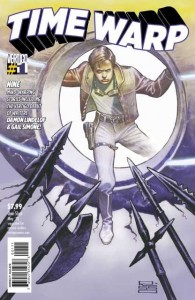 TIME WARP, a revival of a late 1970’s anthology format, presents nine stories by a variety of well known and new creators following a loose theme that may not be as loose as it appears at first glance. The key word “time” stands out as a recurring (literally) factor in these stories. On the whole, because the anthology contains so many varied story-telling techniques and art styles, its appealing and gives the reader a sense of time and money well spent based on its “something for everyone” approach. As a one-shot, it also reads like a graphic novel in disparate parts that comments on the potential of science fiction in the comics medium with capacity to challenge our concepts of humanity, technology, and their often troubled relationship.
TIME WARP, a revival of a late 1970’s anthology format, presents nine stories by a variety of well known and new creators following a loose theme that may not be as loose as it appears at first glance. The key word “time” stands out as a recurring (literally) factor in these stories. On the whole, because the anthology contains so many varied story-telling techniques and art styles, its appealing and gives the reader a sense of time and money well spent based on its “something for everyone” approach. As a one-shot, it also reads like a graphic novel in disparate parts that comments on the potential of science fiction in the comics medium with capacity to challenge our concepts of humanity, technology, and their often troubled relationship.
[Caution: Mild spoilers on content, but no plot-twist revelations ahead]
“R.I.P” , written by Damon Lindelof, with evocative art by Jeff Lemire and fluid colors by Jose Villarubia, is a strong start to the collection. What could be more basic, pulpy, and attractive than a time-travel tale with dinosaurs and multiple attempts to escape death? The story’s variations on a theme, however, get complex quickly, with satisfying results. All the kinds of questions about the implications of time travel that kids grew up with watching Star Trek: The Next Generation take a bite out of the story and lead the reader in logical loops. Lemire’s energetic, chaos-controlling line-work, combined with Travis Lanham’s quirky lettering, suggest an undercurrent of the haphazard about all human endeavors. The message seems to be, despite all our planning, when we deal with factors essentially bigger than us, we might get by, but only by the skin of our teeth. The suspension of belief necessary for the story isn’t overbearing since it points out all the problems and difficulties of handling big themes in its plot structure.
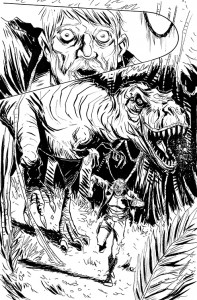 “It’s Full of Demons” is a particularly challenging story, one might almost call a mystery despite its early introduction of a possibly alien time traveller in turn of the century Austria. After reading the complete story, you might have a Memento-like experience of reconstructing the details of the story backward along the lines provided by a full revelation of their significance. This is engaging for the reader. Tom King’s writing is clever in providing just enough detail to make this backward reading possible while not revealing too much about why the increasing madness of a little girl growing up after her brother’s death might be important to readers. The themes of the story are, in fact, heavier the more you examine them, commenting on how fear and the “demonizing” of figures and groups may be an even greater threat than the shocking intrusion of the vastly unknown into daily life. Tom Fowler’s artwork suggests history well without rendering it ponderous, and in particular conveys emotional states in its main character with great empathy.
“It’s Full of Demons” is a particularly challenging story, one might almost call a mystery despite its early introduction of a possibly alien time traveller in turn of the century Austria. After reading the complete story, you might have a Memento-like experience of reconstructing the details of the story backward along the lines provided by a full revelation of their significance. This is engaging for the reader. Tom King’s writing is clever in providing just enough detail to make this backward reading possible while not revealing too much about why the increasing madness of a little girl growing up after her brother’s death might be important to readers. The themes of the story are, in fact, heavier the more you examine them, commenting on how fear and the “demonizing” of figures and groups may be an even greater threat than the shocking intrusion of the vastly unknown into daily life. Tom Fowler’s artwork suggests history well without rendering it ponderous, and in particular conveys emotional states in its main character with great empathy.
Gail Simone writes “I Have What You Need”, with upbeat and somewhat eerie art by Gael Bertrand, and vibrant colors by Jordie Bellaire. Simone isn’t afraid to get complicated, either, about the implications of time travel, even within one’s own mind, and delves pretty deeply into human nature by exploring the idea that a drug could enable you to revisit the best ten minutes of your life. Her kindly shopkeeper holds this god-like key to a “product” that everyone wants, and also provides commentary on what humans deserve, and what they get out of life. Twist endings are a common feature of many of the stories in TIME WARP, and though the stories might have been intriguing without them, it’s a pattern that gives the reader a sense of the value of each particular story as a unit of entertainment and harks back to the genre features of early pulp sci-fi.
“The Grudge” is an intelligent and very human tale of rivalry between two scientists, the kind of rivalry we’ve seen in techno pop culture between Steve Jobs and Bill Gates. Written by Simon Spurrier, with art and color by Michael Dowling, its compressed storytelling gives you a sense of having read a whole comic or perhaps a graphic novel, again presenting an entirely different, detailed world within the anthology. It spans the life of these scientists, their tragedies, and the tension between public demand for spectacle in scientific discoveries and the real needs of scientific advancement to look toward greater future building. Dowling’s near photo-realistic art style easily conveys the sense that this could be our twenty-first century future, still governed by the baser, and higher impulses of the human beings involved in advancement. But the story infuses even tragedy with humor, and most importantly, believing in the reality of the characters helps convey the messages of the narrative.
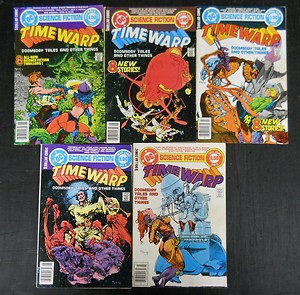 One of the most surprising additions to TIME WARP is a Dead Boy Detectives story. Originally created by Neil Gaiman as a spin-off from SANDMAN, the Dead Boy Detectives seem to veer pretty far from science fiction in their investigation of the occult. However, Gaiman was never one to draw a firm line between the occult and the scientific, and neither has pulp tradition, a borderland other comics in TIME WARP also explore. This episode, “Run Ragged”, written by Toby Litt, with layouts by Mark Buckingham, finishing work by Victor Santos, and letters by the great Todd Klein, reads like a sudden glimpse of a return to a favorite world, and indeed it’s described as a lead-up to a continuing storyline in THE WITCHING HOUR ANTHOLOGY. The artwork, and also the colors by Lee Loughridge are accomplished and appealing, particularly successful at conveying motion and action while creating a sense of the haunted atmosphere of the material.
One of the most surprising additions to TIME WARP is a Dead Boy Detectives story. Originally created by Neil Gaiman as a spin-off from SANDMAN, the Dead Boy Detectives seem to veer pretty far from science fiction in their investigation of the occult. However, Gaiman was never one to draw a firm line between the occult and the scientific, and neither has pulp tradition, a borderland other comics in TIME WARP also explore. This episode, “Run Ragged”, written by Toby Litt, with layouts by Mark Buckingham, finishing work by Victor Santos, and letters by the great Todd Klein, reads like a sudden glimpse of a return to a favorite world, and indeed it’s described as a lead-up to a continuing storyline in THE WITCHING HOUR ANTHOLOGY. The artwork, and also the colors by Lee Loughridge are accomplished and appealing, particularly successful at conveying motion and action while creating a sense of the haunted atmosphere of the material.
“She’s Not There” may remind readers of the more psychological aspects of good science fiction, with more than a dash of the noir emphasis on intense relationships. The premise, that a company in the future can charge vast amounts of money to resurrect ghosts as “information” gleaned from loved ones, hits one of the many common themes in TIME WARP, the general neediness of human beings and the lengths they’ll go to in order to seek comfort from their pasts. Another “mystery” aspect of the story, written by Peter Milligan, with art and colors by M.K. Perker, is the reason for the resurrected wife Angel’s death, and the lingering problems that might have comprised her relationship with her husband in the first place. The story poses a unique question, “Can you own a ghost?”. In a technological world where everything’s a commodity, it seems like a singularly dark possibility. The artwork suggests a blend of the familiar and the unknown in equal proportions, keeping readers guessing, just like the plot.
 The unusually titled story “00:00:03” places human beings under another kind of microscope under the pressure of extreme situations. During vast interstellar wars, we follow the decisions of Helene as she attempts to perform her military duties under the influence of a unique “molasses” protocol that extends perception of time. Written by Ray Fawkes and drawn by Andy MacDonald, this is the kind of story that sci-fi readers will be particularly attracted to. It offers sweeping conflicts on a large stage, space battles, and remarkably deep characterization of a central figure in action. The age old question posed by sci-fi, “Are we still human inside our technology?”, is both addressed and answered in a poignant way.
The unusually titled story “00:00:03” places human beings under another kind of microscope under the pressure of extreme situations. During vast interstellar wars, we follow the decisions of Helene as she attempts to perform her military duties under the influence of a unique “molasses” protocol that extends perception of time. Written by Ray Fawkes and drawn by Andy MacDonald, this is the kind of story that sci-fi readers will be particularly attracted to. It offers sweeping conflicts on a large stage, space battles, and remarkably deep characterization of a central figure in action. The age old question posed by sci-fi, “Are we still human inside our technology?”, is both addressed and answered in a poignant way.
If you’re all about the art of sci-fi comics, then you’ll have quite a few surprises to look forward to in TIME WARP, but it’s likely that Matt Kindt’s “Warning: Danger” will be top of the list. With Kindt’s sketchy outlines, and splashy use of watercolor tones, the story breaks from many of the common assumptions of what traditional sci-fi art should look like. How do you convey the crisp lines of spectacular technology in such an idiosyncratic style? Kindt’s answer is to render technology, and its premises in the story, organic, and therefore a little more alarming. By breaking with what readers may recognize, Kindt presents an unrecognizable, and very compelling vision of the future. His diagrams of the armor and accoutrements of two civilization-representing soldiers locked in single combat schematize the ingenuity and determination of one-upmanship in 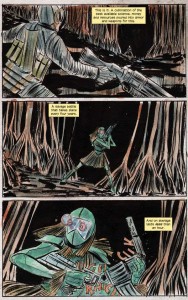 technological advancement. There’s a downbeat sense of recurring time that’s featured in a number of TIME WARP stories, providing the opportunity for humans to relive their obsessions and failures, or get it right when given another chance.
technological advancement. There’s a downbeat sense of recurring time that’s featured in a number of TIME WARP stories, providing the opportunity for humans to relive their obsessions and failures, or get it right when given another chance.
The final piece in TIME WARP gathers together the thematic threads of recurring time, human decision-making, and the bizarre responsibilities that power over technology entails. When technology becomes somewhat monstrous, who’s really in control? Is the humanity inside the machine enough to guide progress away from disaster? “The Principle” is written with a key focus on two main characters by Dan Abnett, and presented rather beautifully with colors and art by I.N.J. Culbard. The trope of presenting a guy new to his job as an identifying character for the readers is here completely necessary to add tension to the gradual revelation of plot. The attempt to prevent an assassination of the “principle” figure through staging the same moment in time over and over again gives characters repeated chances to get things right, and also humorously comments on some historical mysteries as time-travel screw ups. Culbard’s inks, particularly, have a certain noir sensibility, too, though infused with a sci-fi eye toward motion, and seem appropriate when grounding the future in the past. Abnett doesn’t hold off on the sci-fi theme of responsibility, either, and closes the collection with a final message about the tendencies of 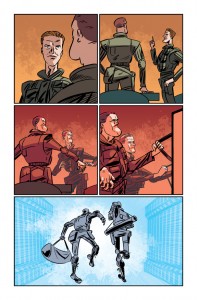 humanity to abuse power in banal ways, and the responsibilities, often dire, we face in trying to keep that kind of potential chaos under control.
humanity to abuse power in banal ways, and the responsibilities, often dire, we face in trying to keep that kind of potential chaos under control.
In fact, looking back through TIME WARP, the overarching implication of these stories seems to be Time=Responsibility. The further we push technological advancement, and the more we tinker with our humanity, the more work we generate for ourselves monitoring our trajectory. But with concepts and artwork like the kind contained in TIME WARP, the spectacle of those sci-fi heights never ceases to be attractive, even when it’s pointing out the potential pitfalls that almost certainly lie ahead. TIME WARP contains a miscellany of energetic science fiction, and its hard not to find the sheer breadth of material and the talent behind it a selling point. Nine worlds, and compact story-telling that often spans lifetimes in one volume? It’s both entertaining and consistently thought-provoking, marking a worthy return of the TIME WARP title.
Title: TIME WARP #1/Publisher: Vertigo, DC Comics/Creative Teams:
“R.I.P”: Damon Lindelof, writer, Jeff Lemire, artist/“It’s Full of Demons”: Tom King, writer, Tom Fowler, artist/“I Have What You Need”: Gail Simone, writer, Gael Bertrand, artist/“The Grudge”: Simon Spurrier, writer, Michael Dowling, artists/“Dead Boy Detectives”: Toby Litt, writer, Mark Buckingham, layouts, Victor Santos, finishing/“She’s Not There”: Peter Milligan, writer, M.K. Perker, artist/“00:00:03”: Ray Fawkes, writer, Andy MacDonald, artist/“Warning: Danger”: Matt Kindt, story and art/“The Principle”: Dan Abnett, writer, I.N.J. Culbard, colors and art
Hannah Means-Shannon writes and blogs about comics for TRIP CITY and Sequart.org and is currently working on books about Neil Gaiman and Alan Moore for Sequart. She is @hannahmenzies on Twitter and hannahmenziesblog on WordPress.
Blog: PW -The Beat (Login to Add to MyJacketFlap)
JacketFlap tags: News, Reviews, Comics, DC, Umberto Eco, Jeff Lemire, Alan Moore, DC Comics, Top News, Yanick Paquette, Scott Snyder, Animal Man #18, Rotworld, Steve Pugh, Swamp Thing #18, Add a tag
The end of the ROT WORLD crossover arc raises the question that Umberto Eco posed in his famous essay on Superman in 1972: can there really be change in a superhero universe? Doesn’t that imply aging, and movement toward an end, death, in fact? Whereas the constant return to a status quo at the end of each trial or adventure puts readers back in a position of looping time, and any seeming change in the lives of superheroes is seen to be a kind of necessary illusion. Eco even pointed out that “What If” stories are the only recourse to exploring meaningful life developments for superheroes like having long-term relationships or kids, milestones that can be neatly tucked away as “out of continuity”. We’re still struggling in superhero comics with the same realities of narrative constraint introduced by the Man of Steel, but that doesn’t mean that some writers and artists are satisfied to make all monumental events, the reason we read superhero comics in the first place, transient. Some are determined not to hand the property on to the next writer or artist in the same condition in which they received it, and that does suggest a lot of gumption on their part. Scott Snyder and Jeff Lemire have suggested in interviews before the ROTWORLD finale that they fought to incorporate lasting change into the universes of SWAMP THING and ANIMAL MAN respectively, and the question is, are those changes really meaningful to the reader? What did the ROT WORLD arc add to the mythology of the DCU and will its impact continue to be felt, or will there still be a gradual return to the status quo to follow?
[Spoilers for ROTWORLD arc, ANIMAL MAN #17, 18, and SWAMP THING #17, 18 below!]
All evidence points to New 52 marketing wanting readers to believe that ROT WORLD was culminating in something monumental, something unheard of that might never be seen again. SWAMP THING #18’s cover, depicting Abby and Swampy embracing reads, “’Til Death Do Them Part!”, and ANIMAL MAN #18’s even more emotionally gripping cover, with Buddy Baker screaming in the dark, reads in rather gigantic letters: “This is the Most Tragic Day in the Life of Buddy Baker!”. As far as hype goes, it’s pretty extreme, and even though fans might not want these characters to suffer, anything less might seem like a rip off after this kind of advertizing. Maybe they want readers to feel conflicted because that means they are personally engaging with the titular characters.
Let’s start with the ROT mythology, and the way in which it affects a reader’s view of the DCU, then discuss the kind of “change” ST #18 and AM #18 introduce. As mythology, the introduction of The Rot is a significant accomplishment. It shines a light on the dark corners of the underlying principles of the DC Universe and helps fill out the cosmic principles that hold it together for readers. The Rot functions as a third element to stand in balance to The Red, the element of animals (and humans), and The Green, the element of the plant world. It makes sense there should be more than just The Green and the The Red struggling, often against each other. Adding a third principle, first as a mutual foe, that represents “decay” is pretty ingenious. It speaks to the reality of death and entropy in the DCU and gives readers a greater sense of just how things function in the DCU. So from an overarching standpoint, thumbs up. But honestly, it gets even better. In issue #17 of SWAMP THING when Swamp Thing and Animal Man start questioning their own view of what The Rot is, things get more “real” in the sense that the opposition between The Red and The Green versus The Rot becomes instead a triad of opposing forces.
As Constantine had warned earlier, The Red and The Green are not “black and white”. They are not alone, and don’t simply have a mutual foe. They have a mutually equal principle to deal with taken over by Anton Arcane. They begin to realize that the avatars of each principle can determine whether the element works in more helpful or harmful ways and that The Rot, a principle of decay, is, in fact neutral, though corrupted by Arcane. Though readers might have seen this coming, it forms a sudden clear paradigm for principles acting in the DCU, and suggests a satisfying emphasis on “harmony” between principles as a universal goal. It syncs well with all the struggles of heroes in the DCU, and could speak to Superman’s endeavors just as well as Batman’s. The ROT WORLD arc has added this paradigm to the DC Universe, and contributed to its mythology.
So much for a view from a distance. It’s wonderful, and maybe even essential to have a solid and well thought out mythology behind a superhero universe, but without elements of humanity in its characters, there are no real stories to be told. The entire ROT WORLD crossover is deeply psychological. One could argue that perception and uncertain perception of reality are some of its key themes, particularly focused upon Swamp Thing and Animal Man. Are the worlds they fall through and move through even real at all? Can anything be fixed and certain when time-travel and world-travel are involved? That could move the reader away from a sense of seriousness in the events they are witnessing, not being sure that anything happened “for real”. Snyder and Lemire actually break through the “fourth wall” in a way by writing this uncertainty into the storyline openly. When Swampy and Animal Man storm Arcane’s stronghold in Rotworld in ST #17 and AM #17, they encounter monstrous, twisted versions of their loved ones, Abby (Abigail Arcane, Swamp Thing’s girlfriend) and Maxine (Animal Man’s daughter) respectively. The loved ones seem lost, bent beyond recognition into Arcane’s principle of Rot, and though they speak in familiar voices, Swampy and Animal Man still question whether it’s “really them”. It’s a version of them, Arcane confirms, since he’s grown them from infancy for this role, but there’s a lingering possibility that somewhere, if only in a version of the past, Abby and Maxine are still untainted. It’s emotionally engaging to see Swamp Thing and Animal Man interact with these twisted versions, but if it’s not “really” them, the impact is limited.
That’s where issues #18 of both comics come in. They hold the key to determining if these are just essentially rather gruesome “What If” stories that have plenty to say about the DCU and especially a great deal to say about the psychology of central characters, but then, like a dream, will cycle back to normality having won the battle against Arcane and restored balance to the newly defined three principles of the universe. Lesson learned, life could more or less return to a version of the DCU that readers recognize. This is where, it seems, Snyder and Lemire’s determination to insist on change in the DCU after ROT WORLD comes in. They each take divergent paths to accomplish this, but the principle seems the same: restoring balance takes personal cost. If the universe is capable of righting itself after an imbalance, it does so with little concern over the impact on human lives, but works toward a bigger goal. Let’s also remember that Swamp Thing has agreed to be the avatar of The Green and give up his Alec Holland matrix of identity (as introduced originally by Alan Moore) and that Animal Man faces the same strict principles though his daughter Maxine is actually the avatar of The Red. This means that nothing is safe, and nothing is more sacred than that role.
Snyder brings humanity to the post-Rot roles of Swamp Thing and Abby through the unlikely final farewell to their humanity and a backward-looking but meaningful sentiment about their connection to each other, visually depicted by Yanick Paquette in stunning terms as their two human bodies lying together, presumably deceased, gradually covered by the flowers of The Green. It’s a farewell for fans, one that deserves some rites of its own, but its implications bring actual change to the DCU also. Abby has knowingly taken on the role of avatar for The Rot in its new, neutral form as a safeguard for keeping it that way. She’s not only resisting the kind of horror arcane unleashed upon the entire DCU in the form of his own version of The Rot, she’s doing something about, and sacrificing her humanity to do so.
As counterbalanced principles now, she and Swamp Thing cannot truly be together (witness the ashes arising between them when they touch). He is growth and she is decay, interactive elements with their distant parts to play. Satisfyingly in some ways, Abby is now Swamp Thing’s equal. Surprisingly, that makes sense, as if her potential and future role had something to do with bringing them together in the first place. How can it be satisfying, though, that they can never be together again? It’s satisfying only in the sense that it rings true because it is honest to goodness change in the DC Universe, one Snyder went to bat for. How can these stories continue to be deeply meaningful to us if there is never any deep change visible? Bravo, Mr. Snyder, no matter how miserable you have made Swampy and Abby. To be fair, they seem to accept this fate the way elementals do, with rather profound wisdom.
Jeff Lemire has, in some ways, a more difficult task at hand in ANIMAL MAN #18. Thrown back into his world to learn if things have changed, if at all, he has his entire family to worry about, not just his daughter Maxine. To introduce change into a family configuration is complicated. Do you change the nature of the relationships? Does Maxine, assuming she’s alive, stop being the avatar of The Red? What about losing his mother? That seems somehow like a reasonably nod toward change. But the scale of ROT WORLD has been so extreme that, simply stated, losing a parent might not quite satisfy readers. If Swamp Thing and Abby were tragic and nostalgic (and isn’t The Green usually anyway?), Animal Man needs something raw and violent to contend with, something primal perhaps. Steve Pugh does an excellent job rendering scenes between Buddy and his family human, and physical, once he returns to his world (particularly necessary with a title like ANIMAL MAN). I wouldn’t say that having his already ill son Cliff Baker, finally die, was predictable. It was a roulette spin on who might die, though death did seem likely, especially given the book’s cover art. Cliff doesn’t need to be the avatar of The Red like Maxine, and his death can be an emotional touchstone for readers to connect to Buddy Baker. Superhero stories have contained quite a few lost sons over the years, but that doesn’t mean the trope doesn’t pack a punch.
After everything Animal Man has been through to save the universe from the Rot, doesn’t he deserve better than this? And yet, that’s the point. In this way, he’s not special. He’s vulnerable and human, and could experience the loss of a child. This is change for Buddy, but it’s more a psychological change than a major plot shift for future issues of ANIMAL MAN. This isn’t to say that losing a character doesn’t change the DCU, it does, but Cliff’s death doesn’t change it on the same scale that Abby’s transformation will. Is the change that Lemire introduces less of a success because of this? Nope. He introduces change to the fabric of Animal Man’s life, and an emotional impact that will last forever in psychological terms. Exactly how Cliff’s death will impact the ANIMAL MAN comic, in fact, remains to be seen, but it would be very hard to brush it aside. This certainly isn’t a “What If” story.
So, the bottom line about the end of an era with Snyder’s final issue of SWAMP THING and the end of the ROT WORLD arc is that it does remarkable things to alter the way in which readers perceive and understand the DC Universe as a whole, and is a pretty impressive feat of universe building from the inside out. It creates growth and greater appreciation of a universe perpetually under construction, and for that reason, rarely explained in broad terms. But Snyder and Lemire also do something that shows a lot of fortitude and personal vision for what readers need to see in superhero stories to really grasp their significance: the potential for change. If these characters cannot be affected by their life experiences, where does that leave us, the readers, trying to connect and apply their experiences to our own?
SWAMP THING #18 and ANIMAL MAN #18 complete what you might term “Eco’s loop” in terms of creating continuity again in the DCU (by restoring balance in The Rot), but they also break through that loop and give us a glimpse, hopefully an enduring one, of heroes in a “real” situation of loss, maybe even a form of sacrifice to restore that balance. There’s nothing more human than the realization that things don’t always work out the way you want them to. Thankfully, for Snyder and Lemire, they did this time.
Title: ANIMAL MAN #18/ Publisher: DC Comics/Creative Team: Jeff Lemire, Writer, Steve Pugh, Artist, Lovern Kindzierski, Colorist, Jared K. Fletcher, Letterer
Title: SWAMP THING #18/ Publisher: DC Comics/Creative Team: Scott Snyder, Writer, Yanick Paquette, Artist, Nathan Fairbairn, Colors, Travis Lanham, Letters
Hannah Means-Shannon writes and blogs about comics for TRIP CITY and Sequart.org and is currently working on books about Neil Gaiman and Alan Moore for Sequart. She is @hannahmenzies on Twitter and hannahmenziesblog on WordPress.
View Next 2 Posts



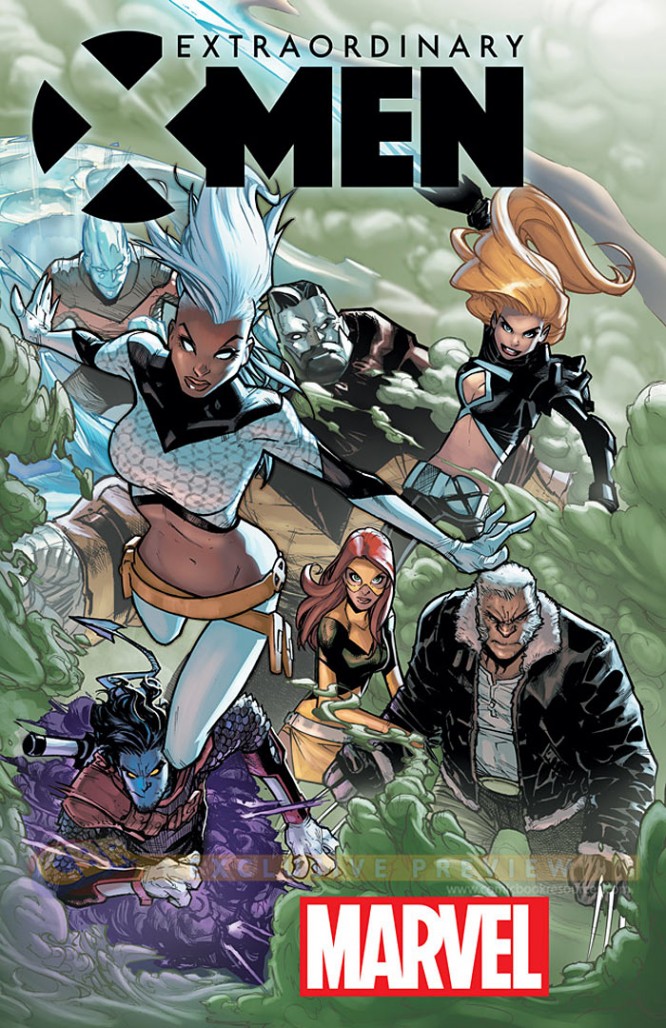
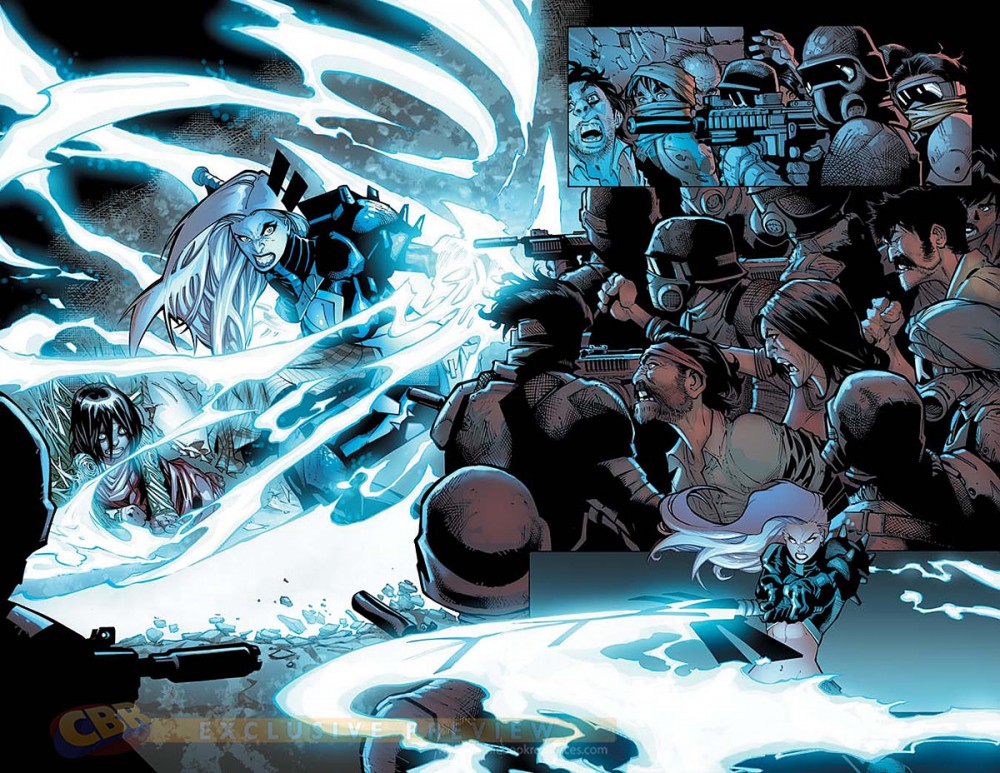
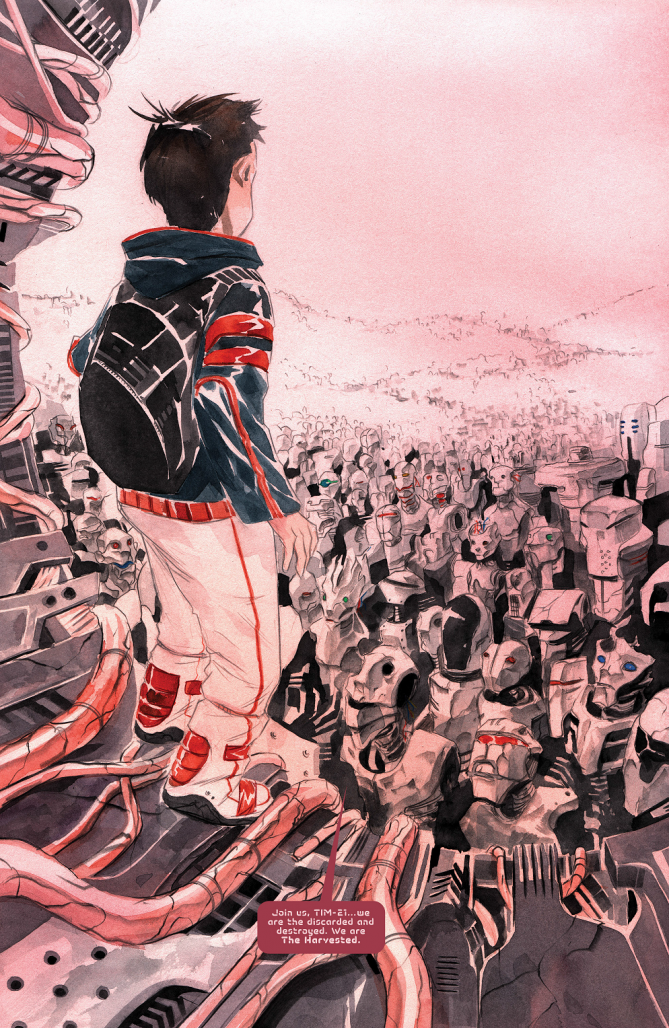
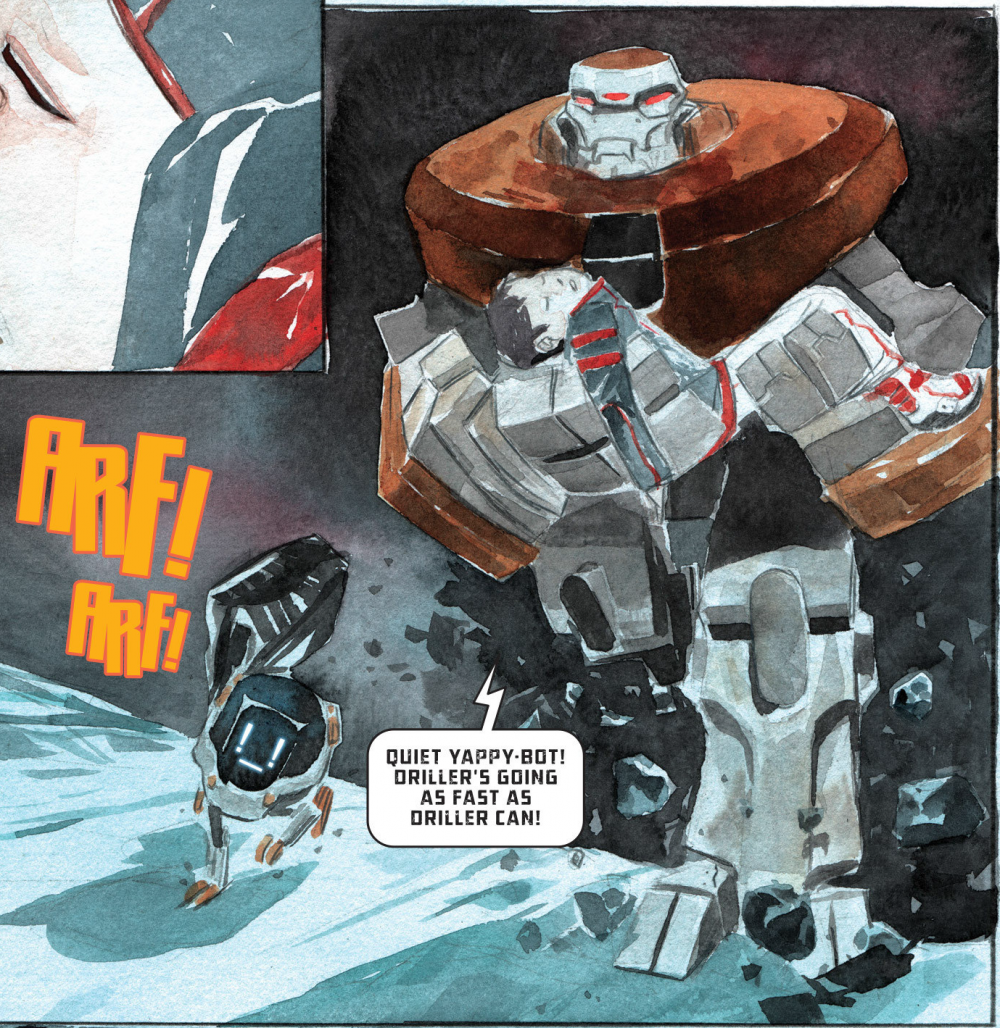
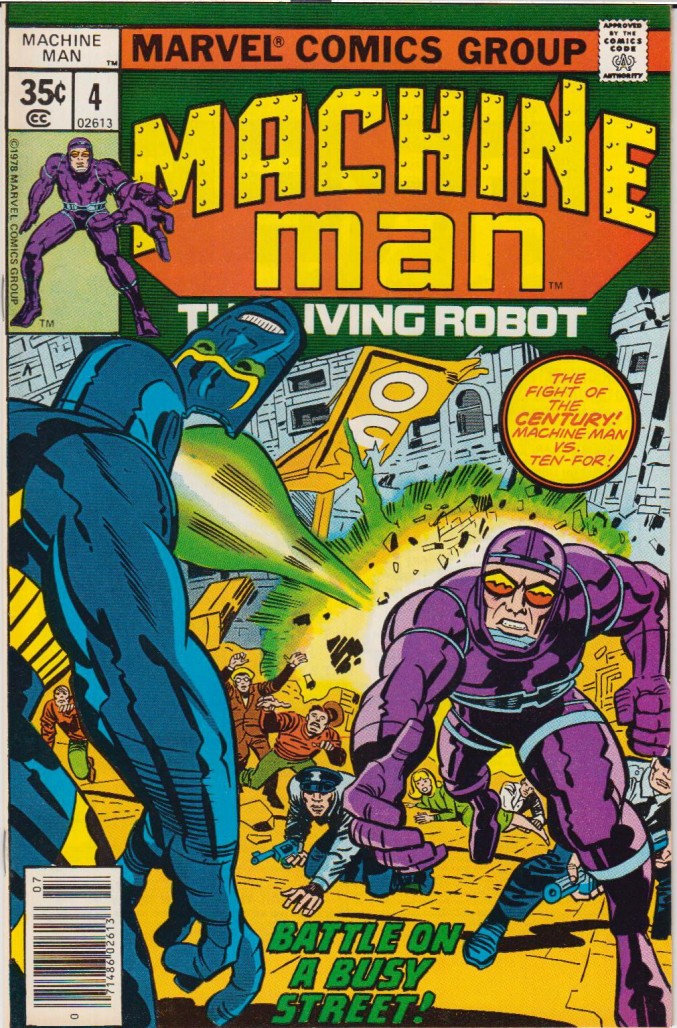
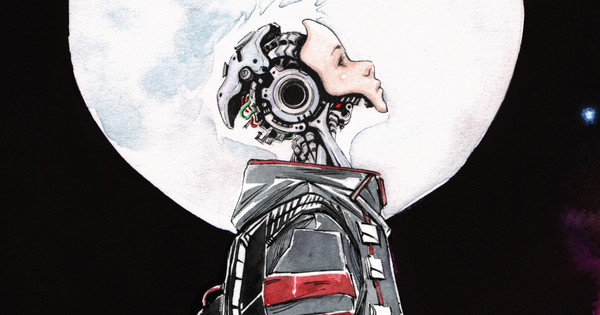
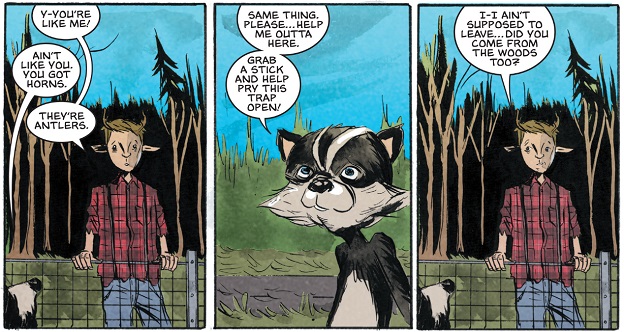
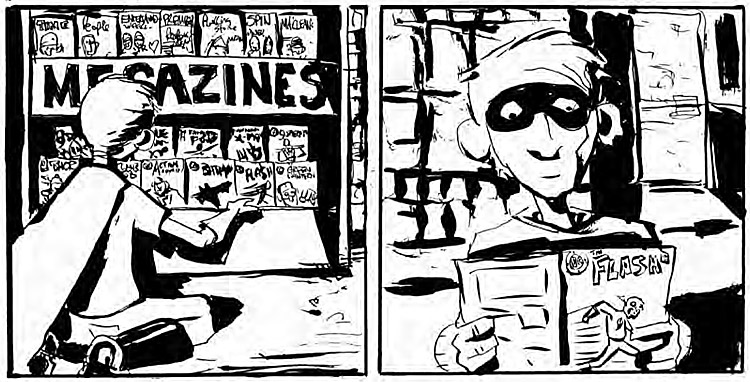
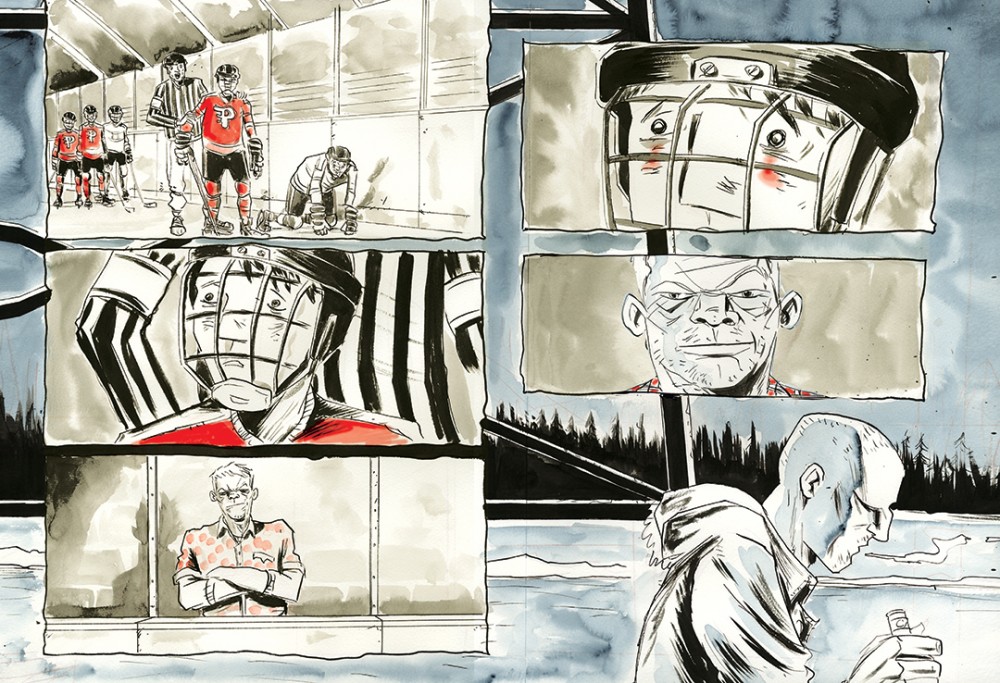
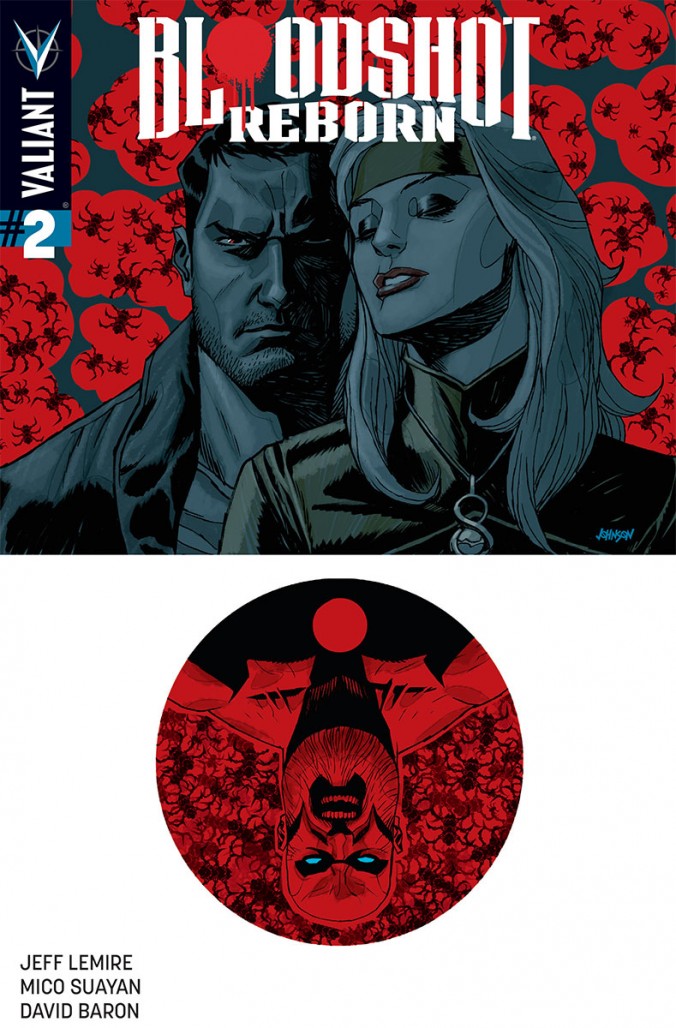
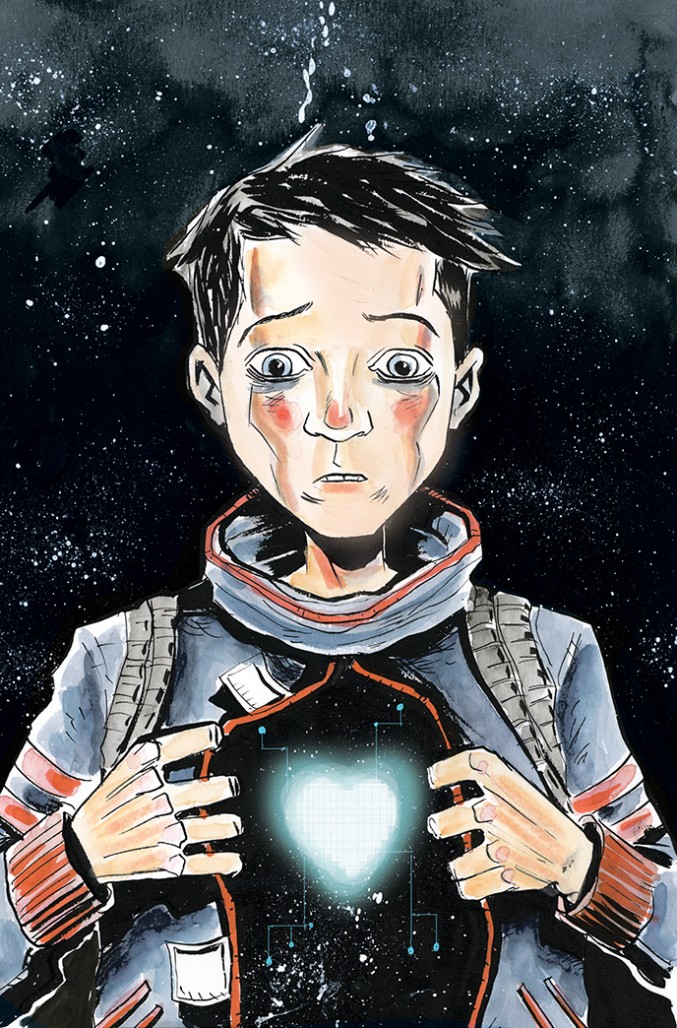
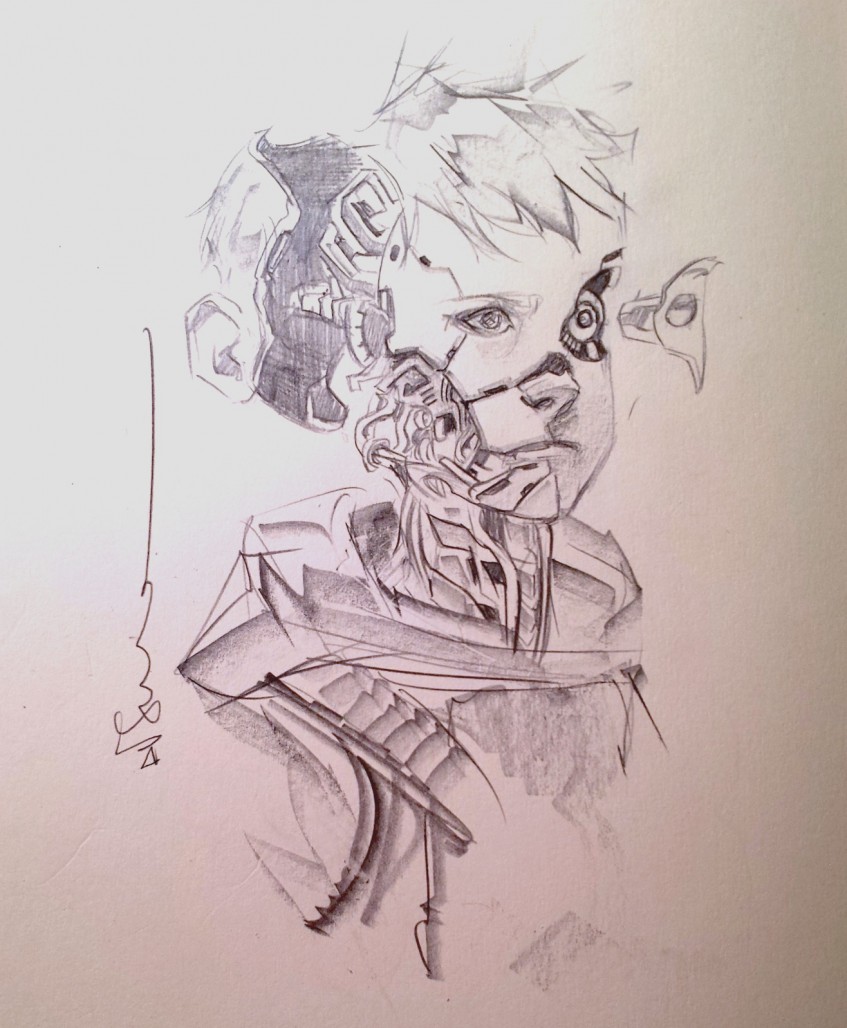
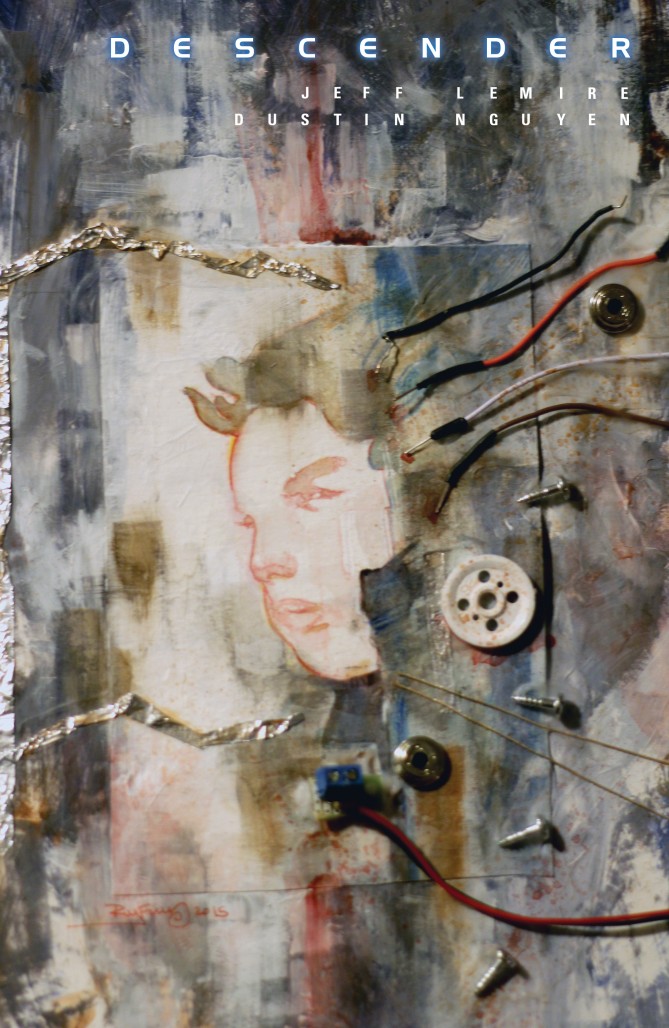
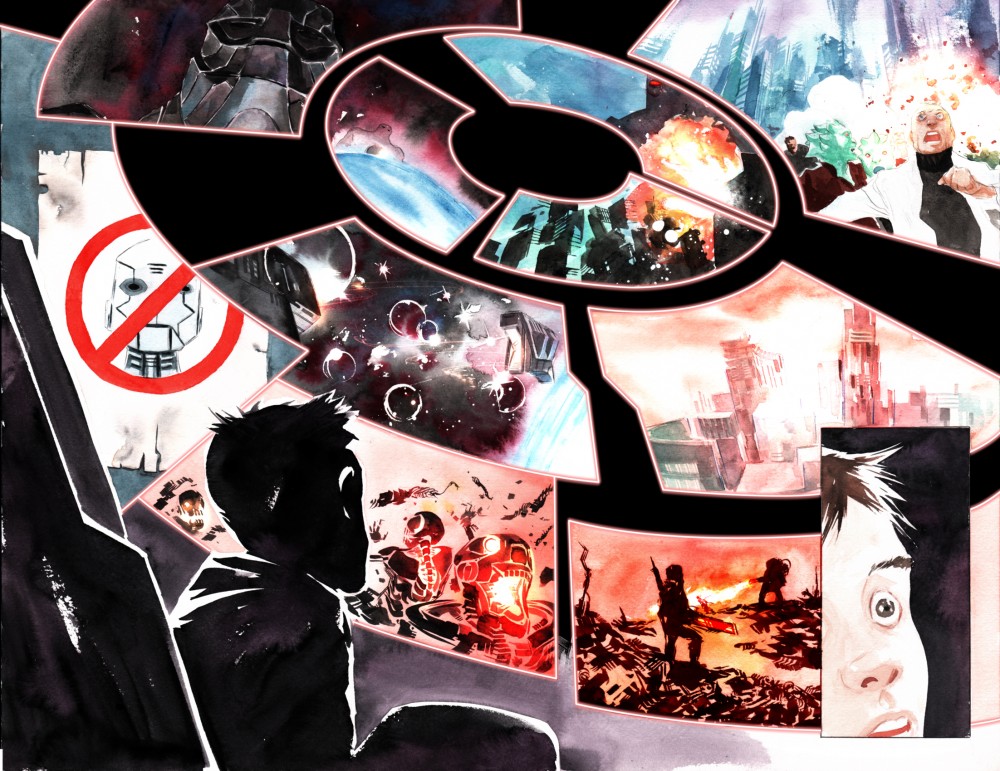
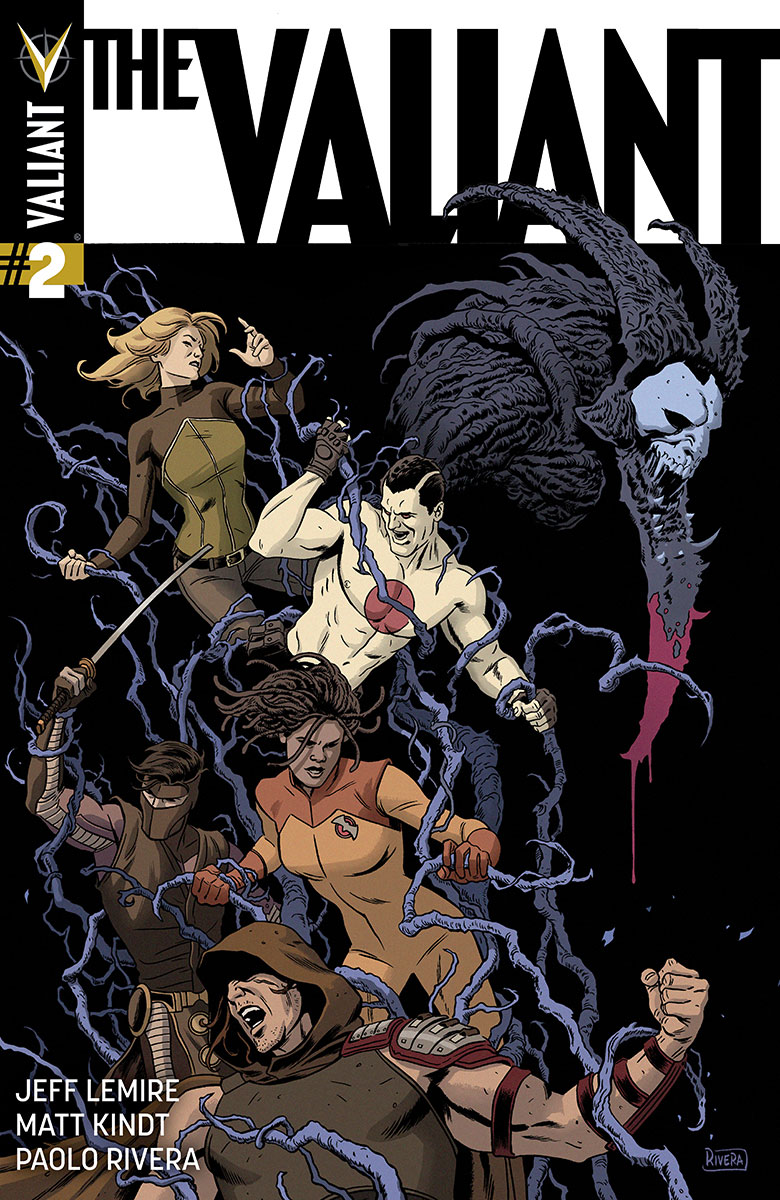
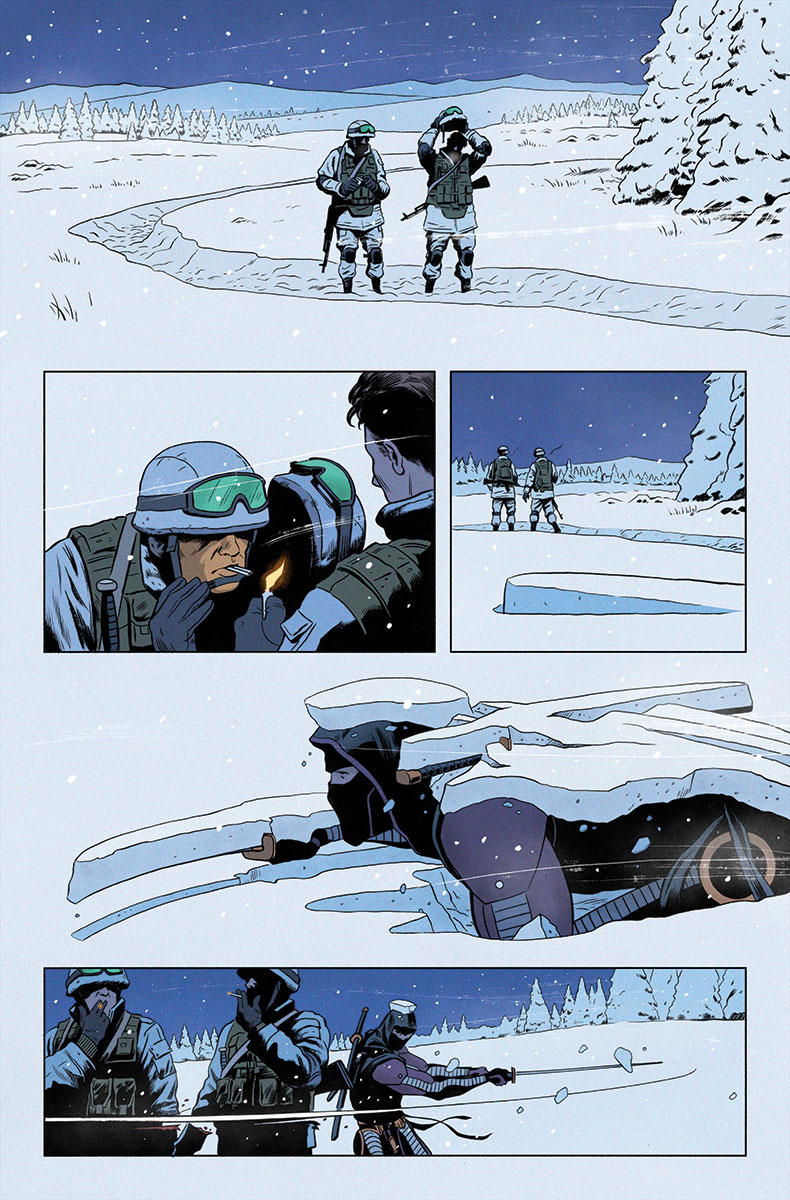

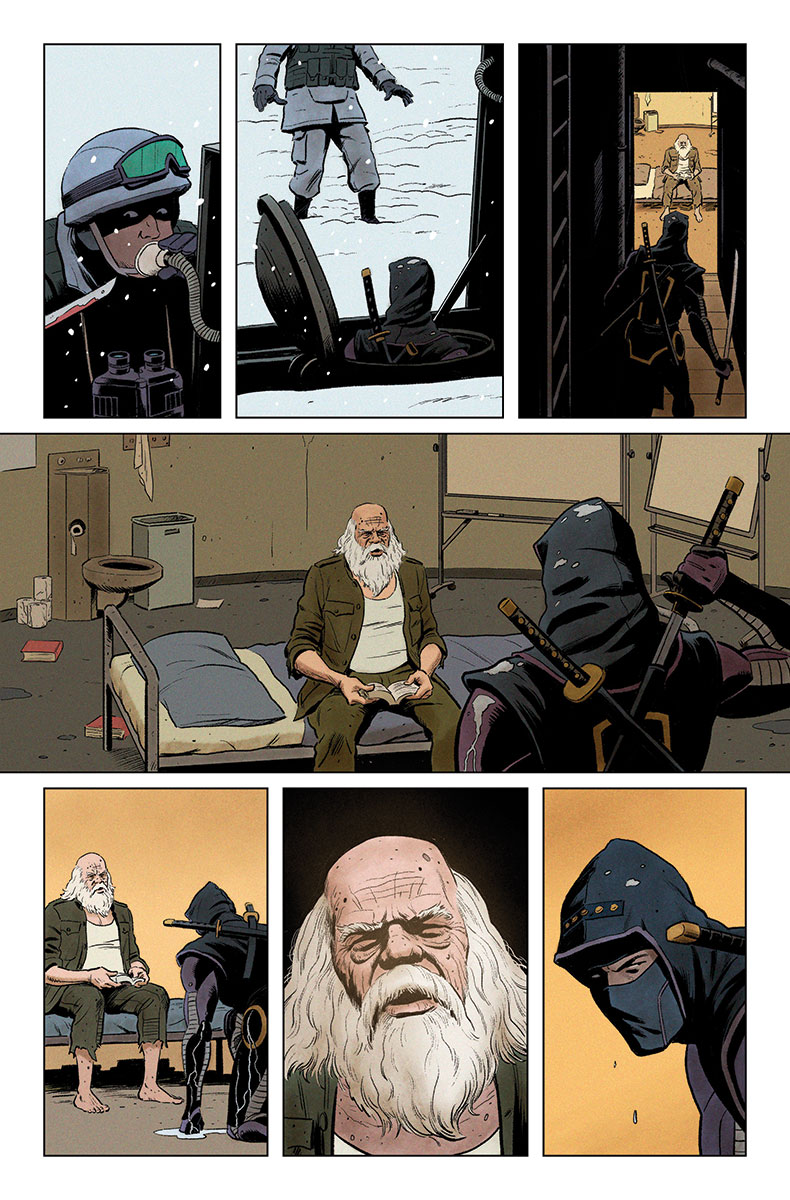

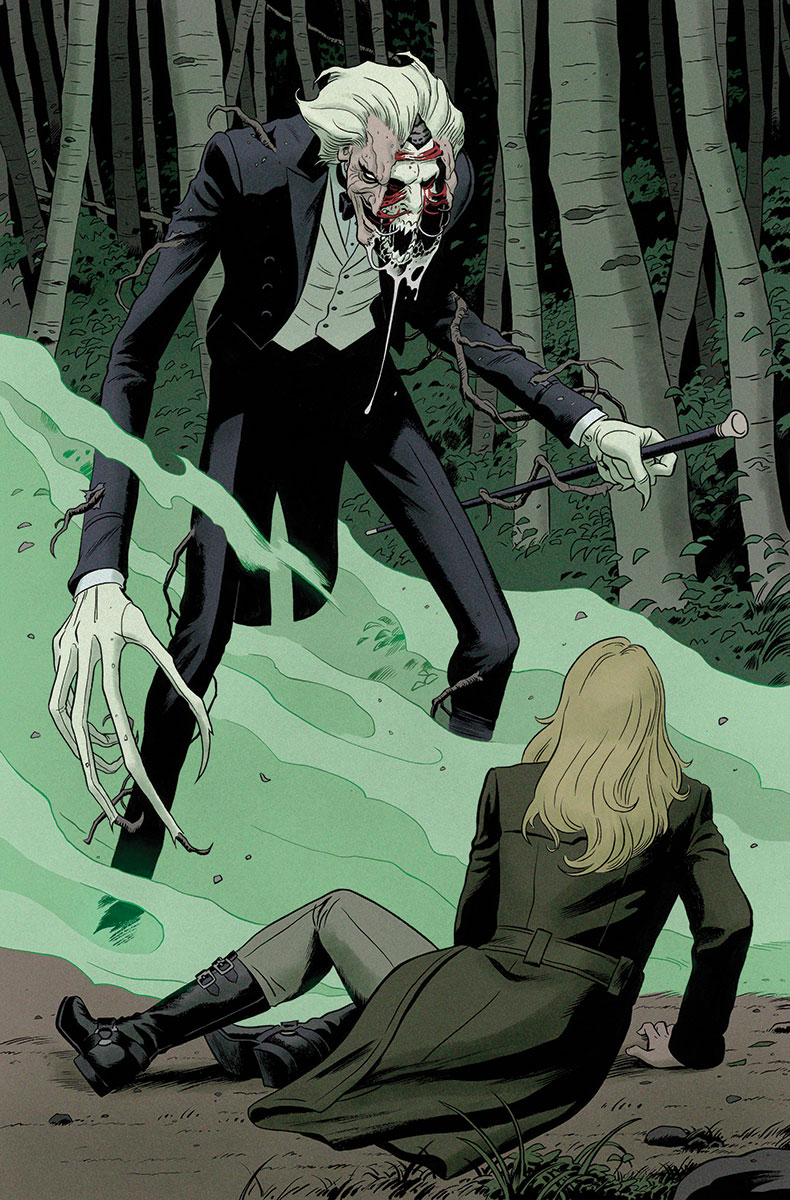



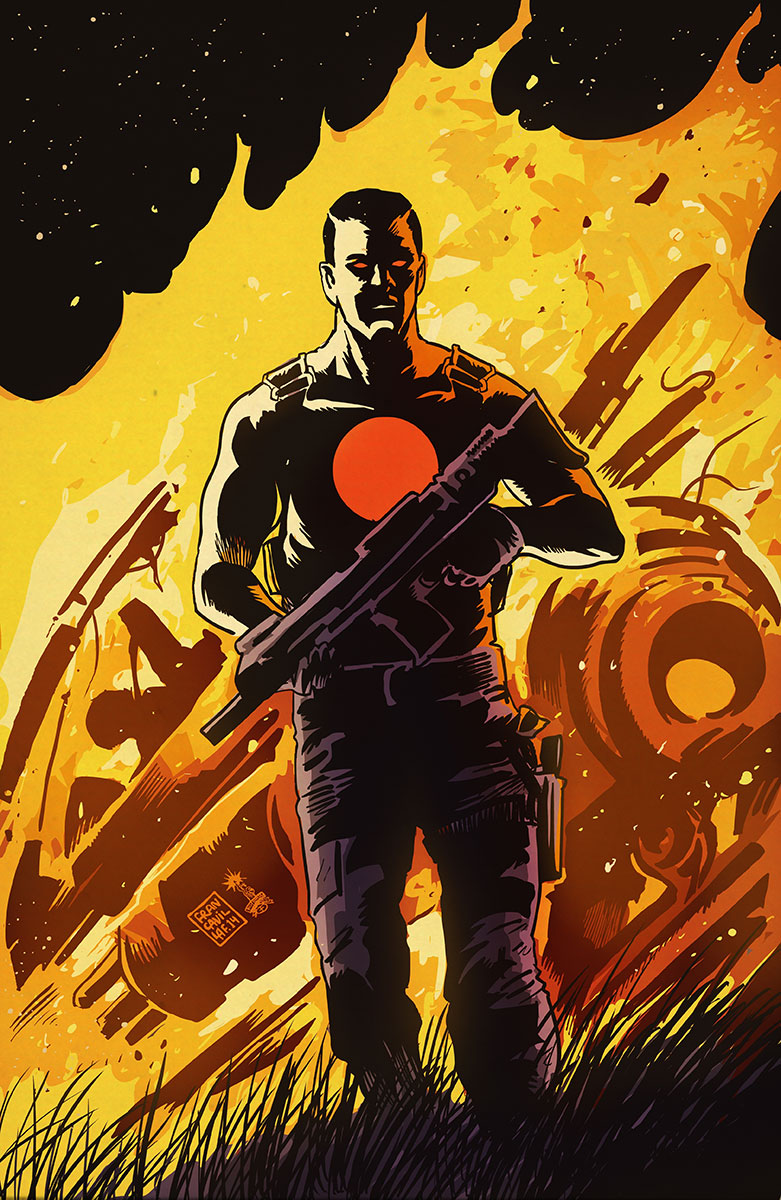

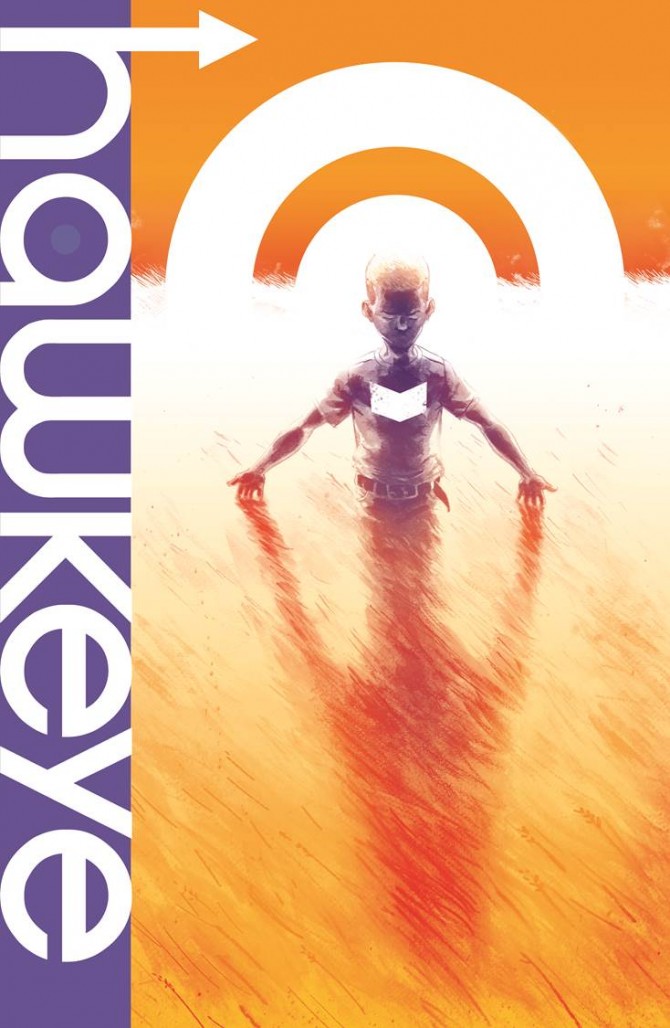

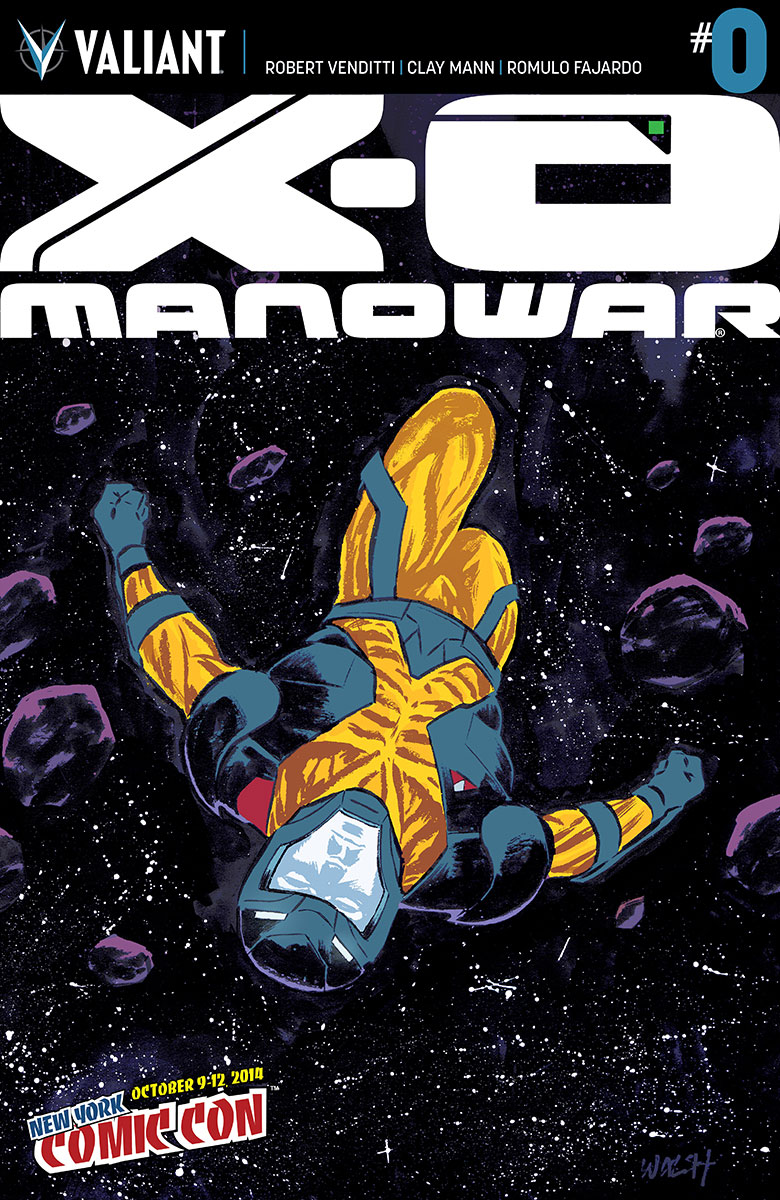
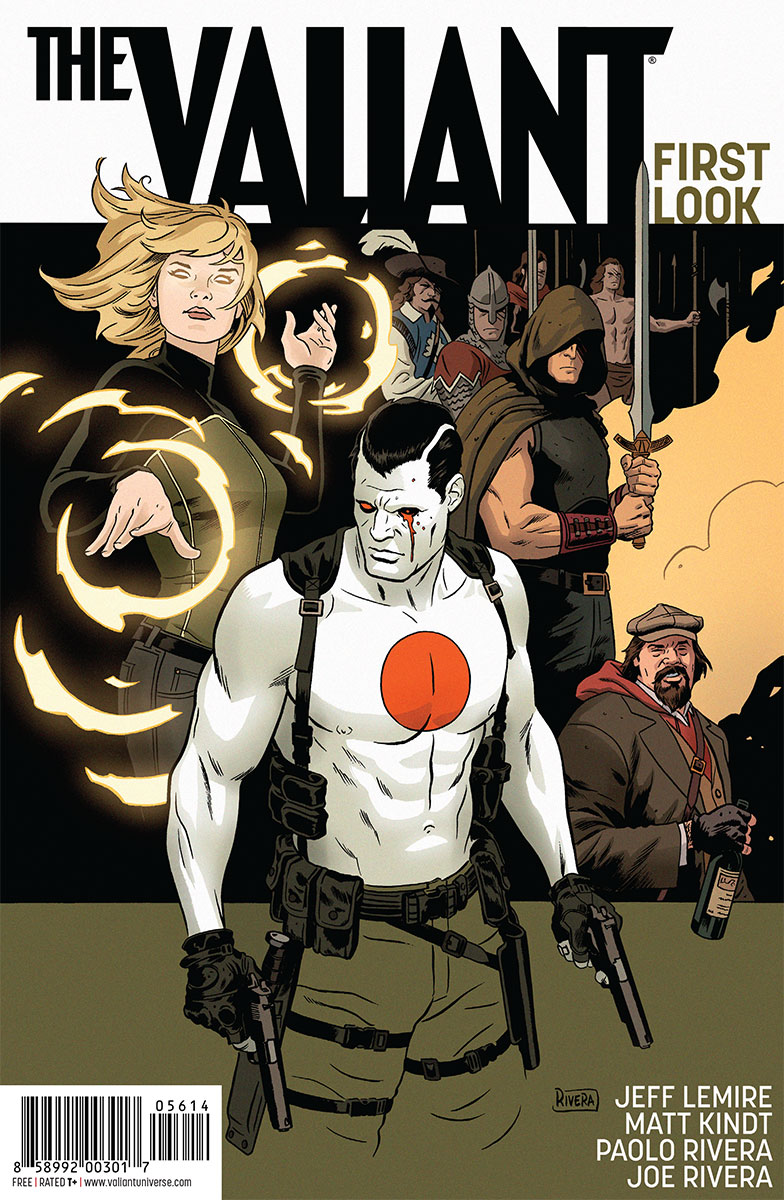
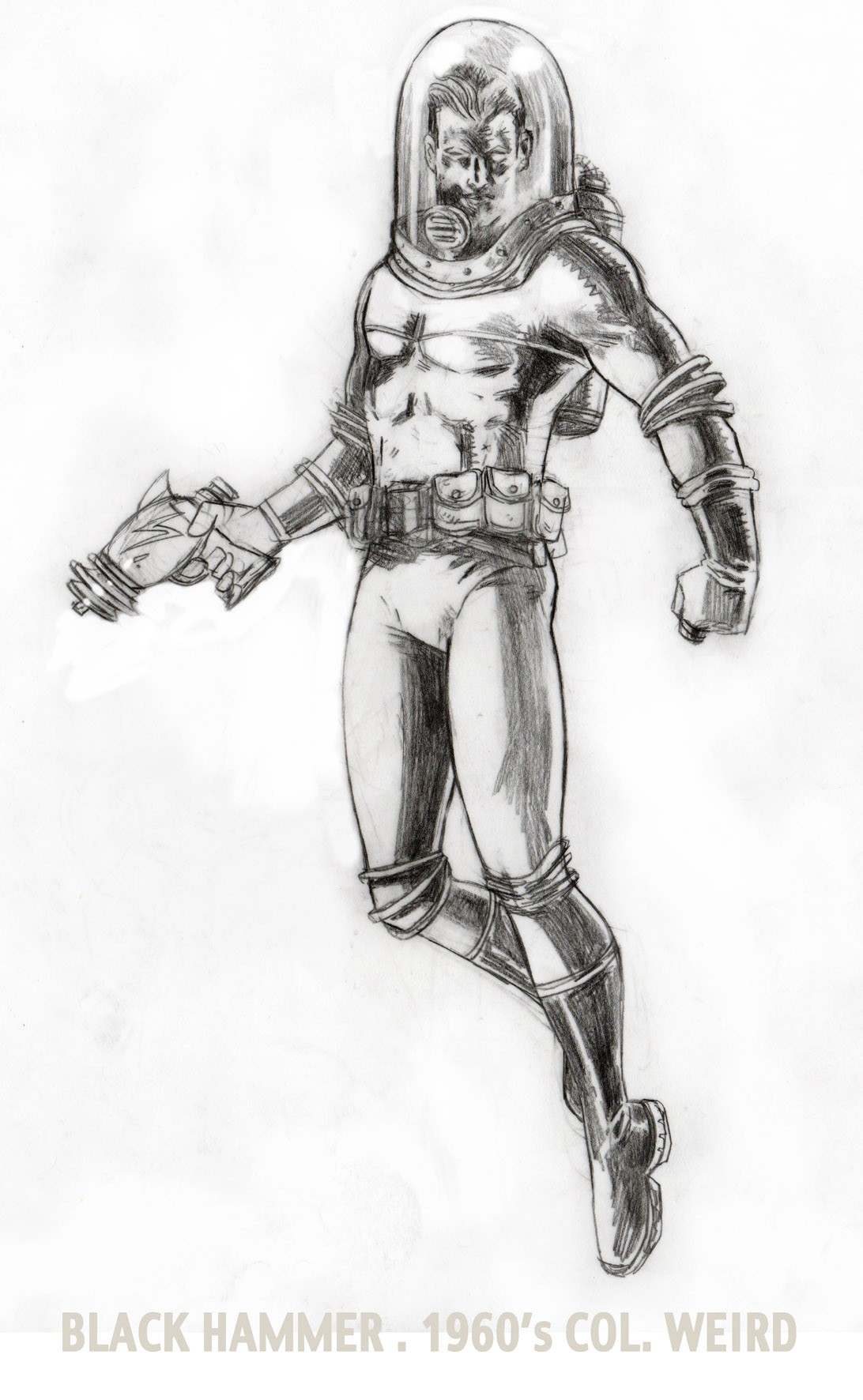
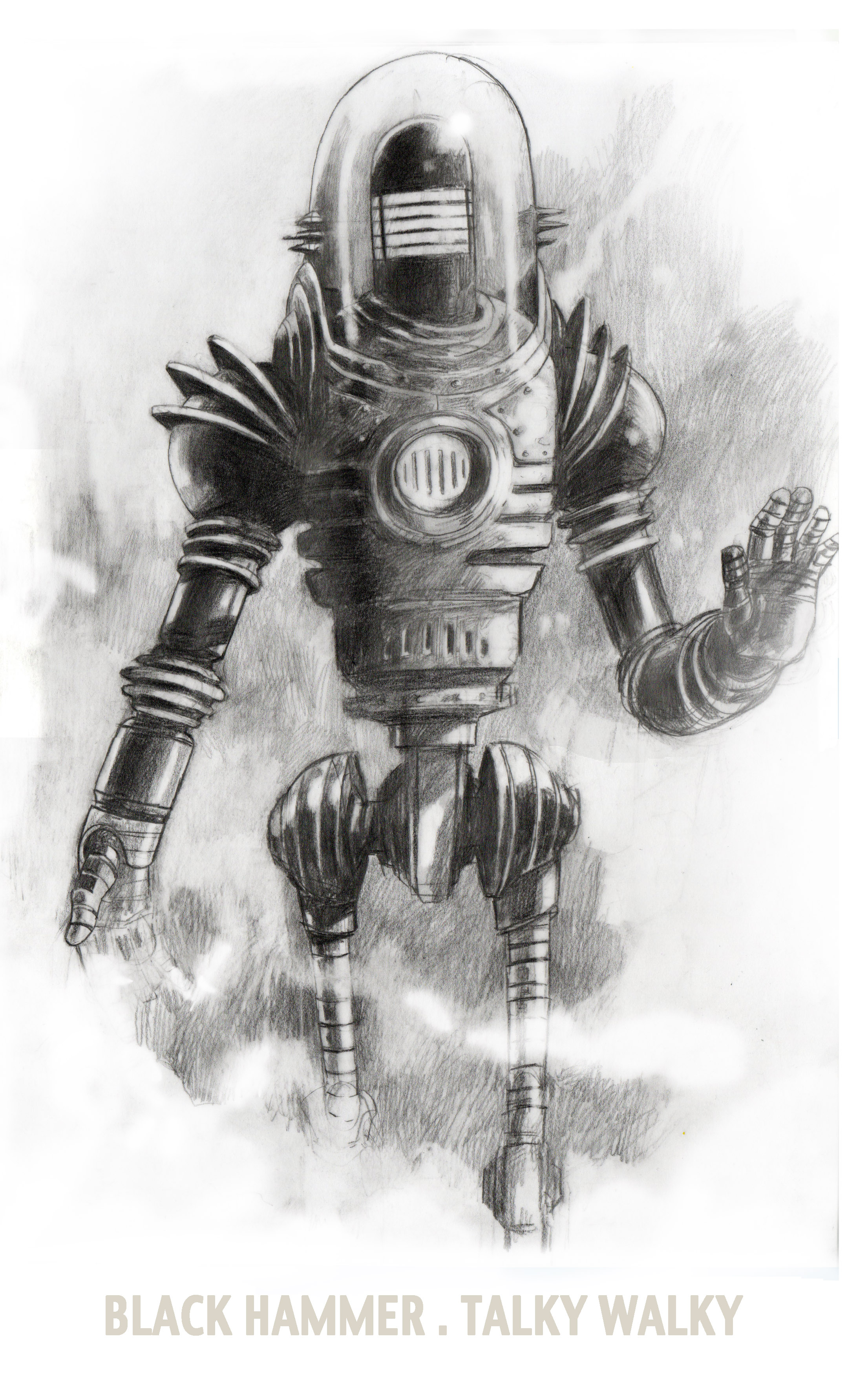


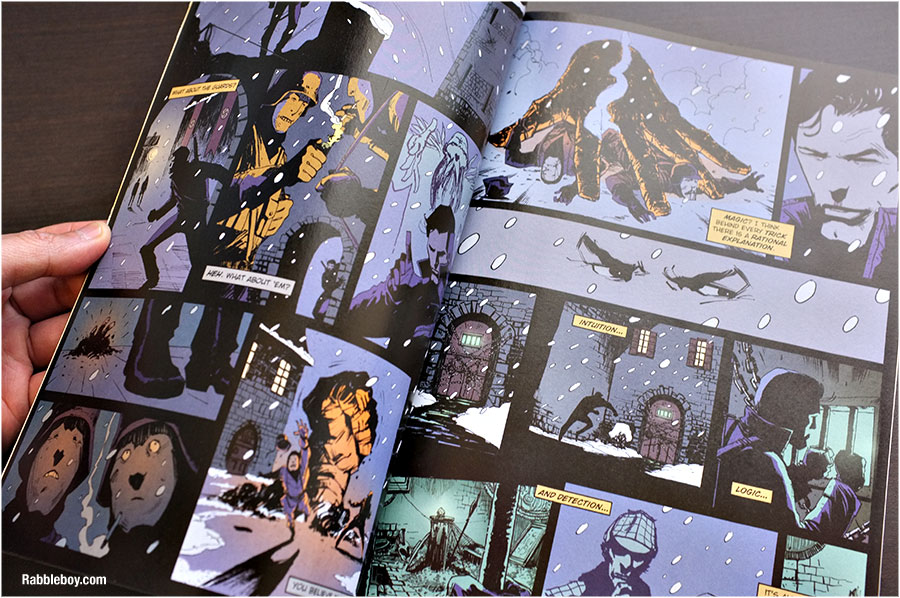
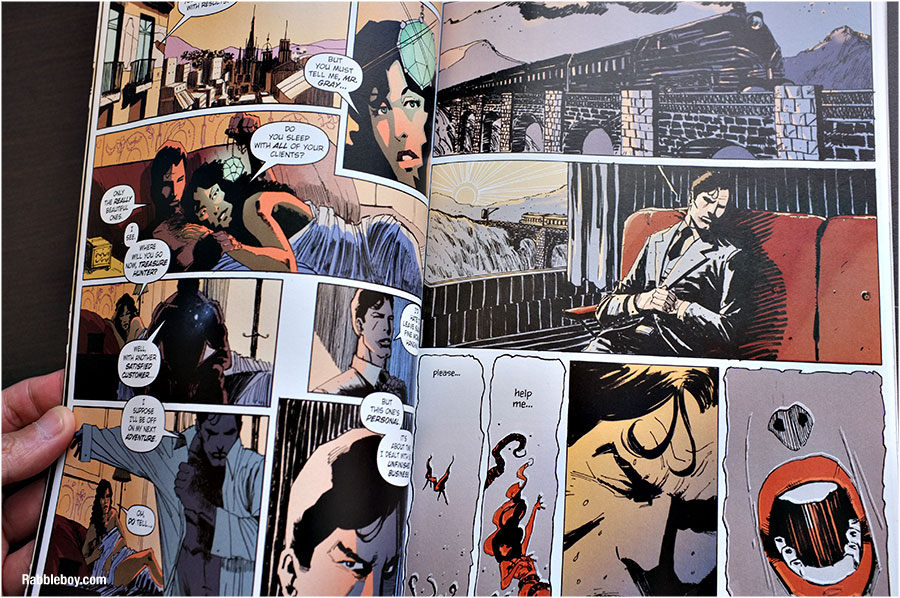
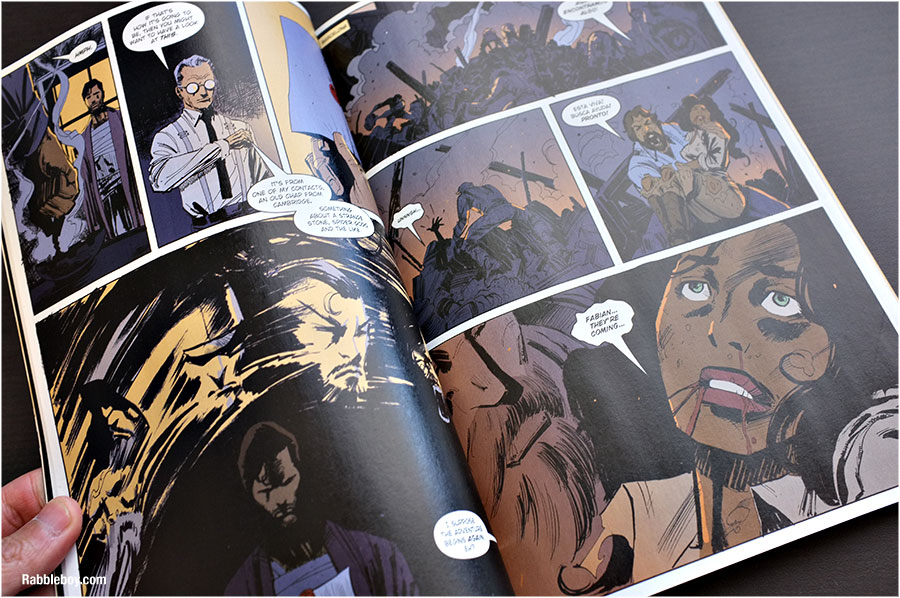
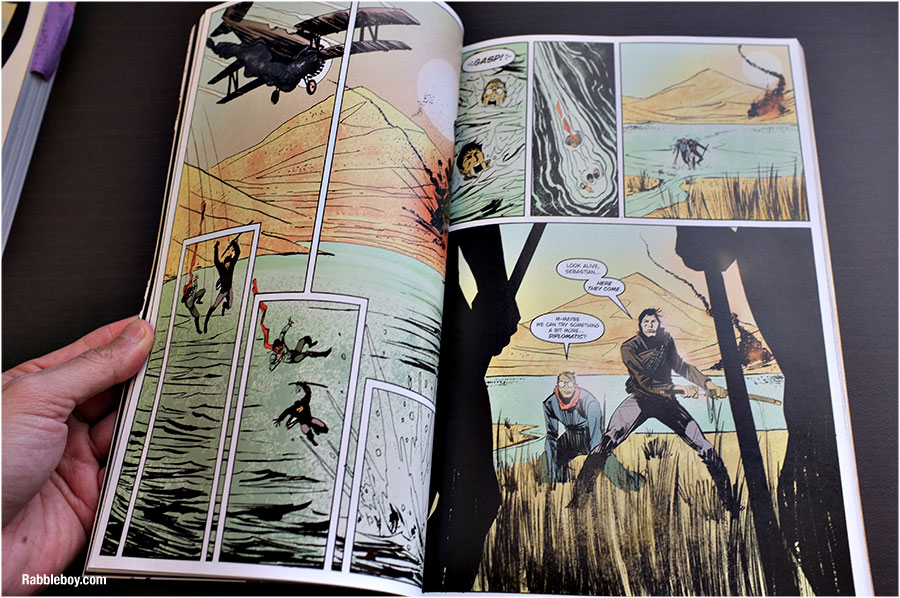
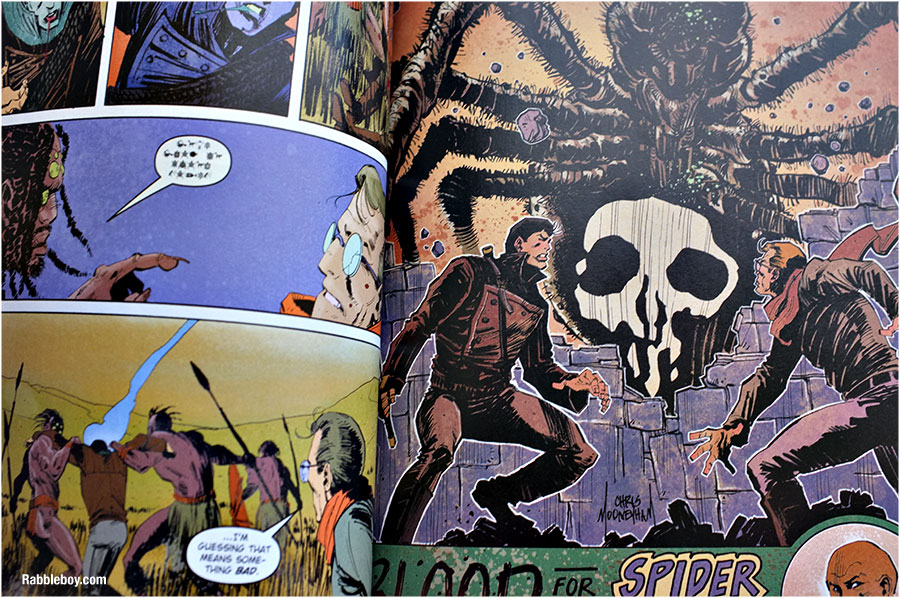
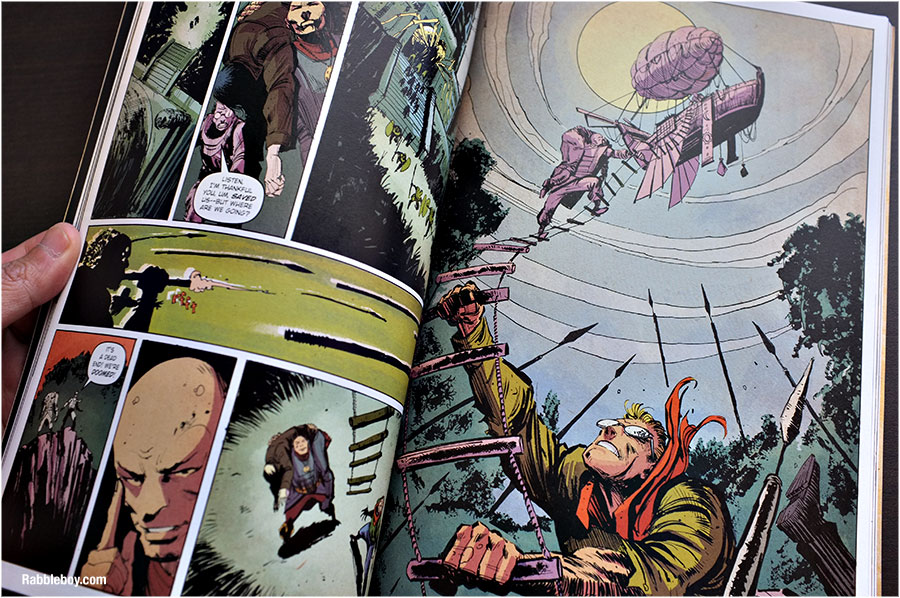

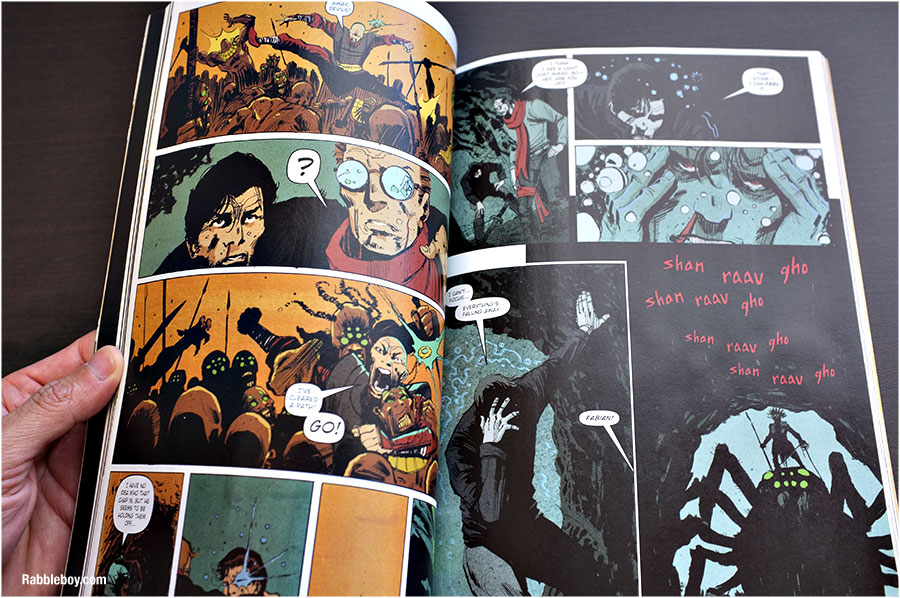
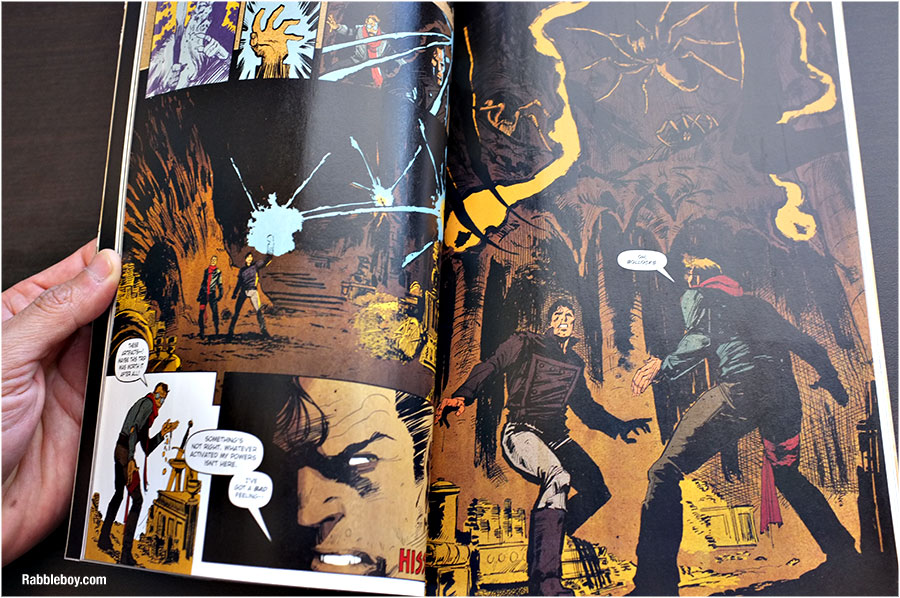
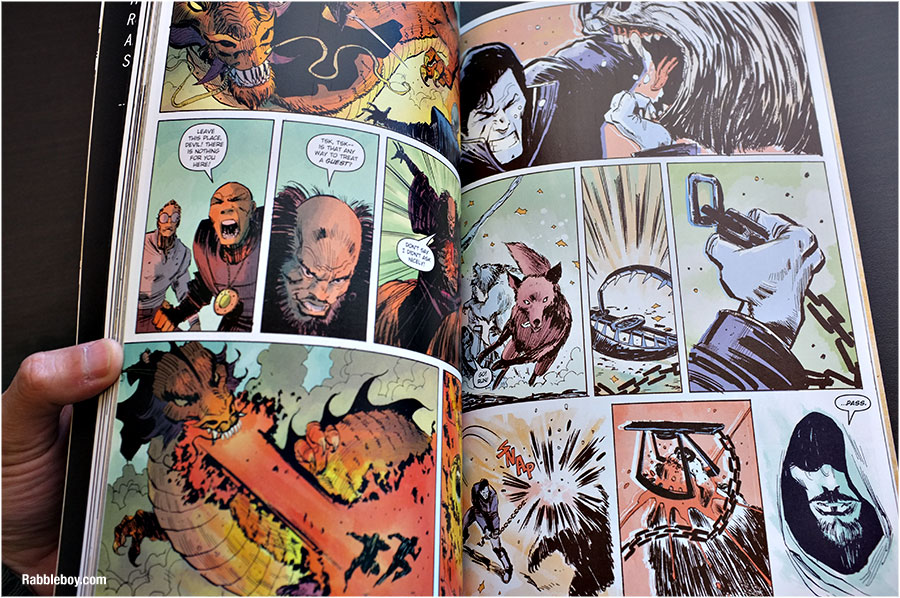
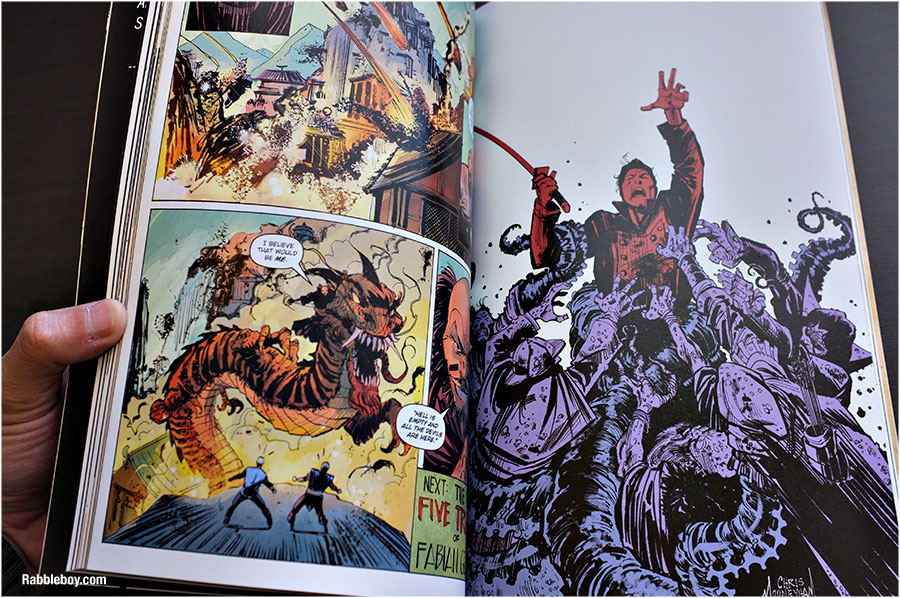
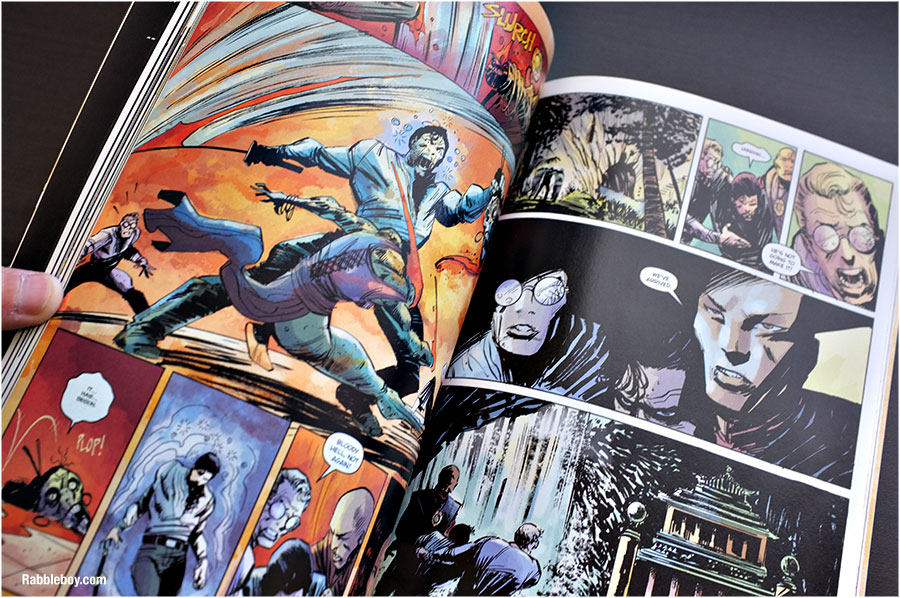
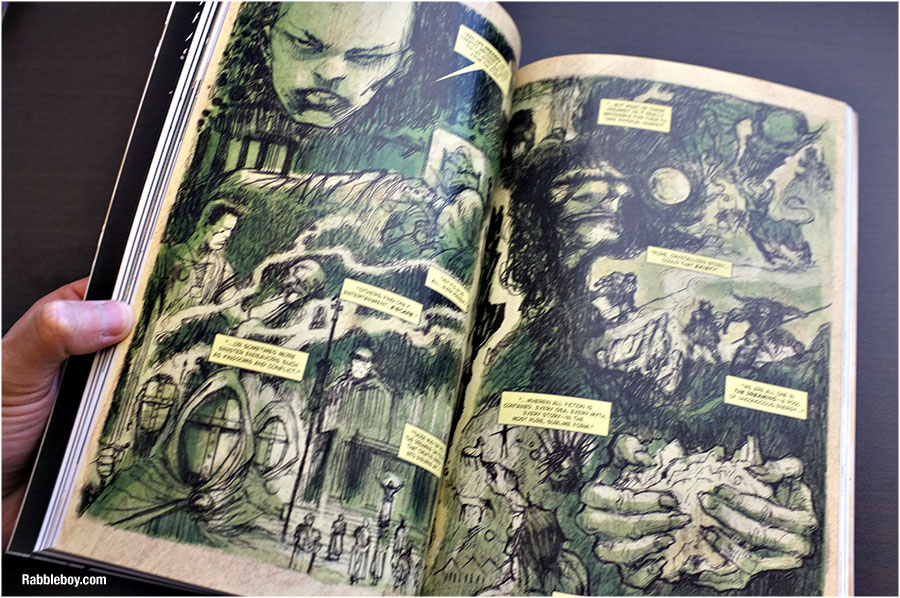
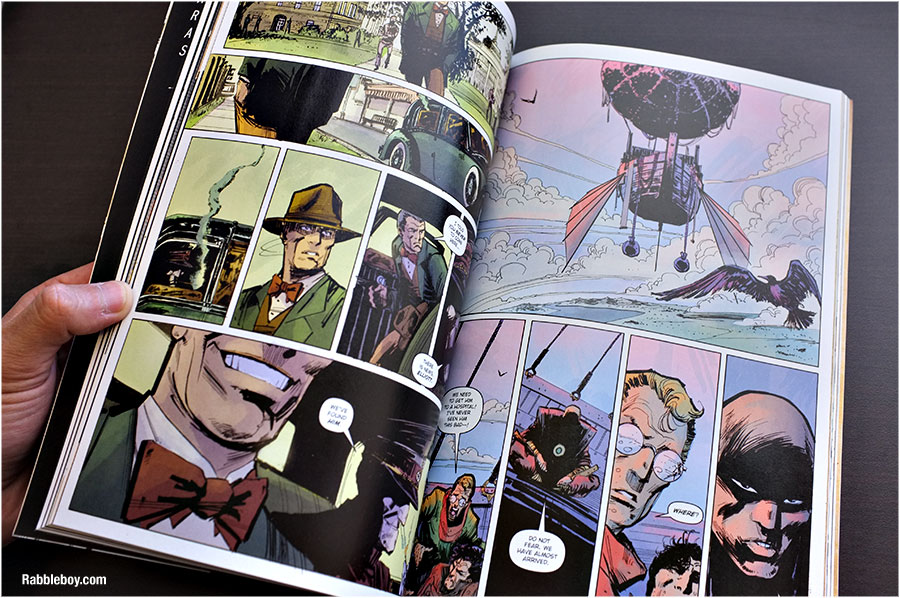
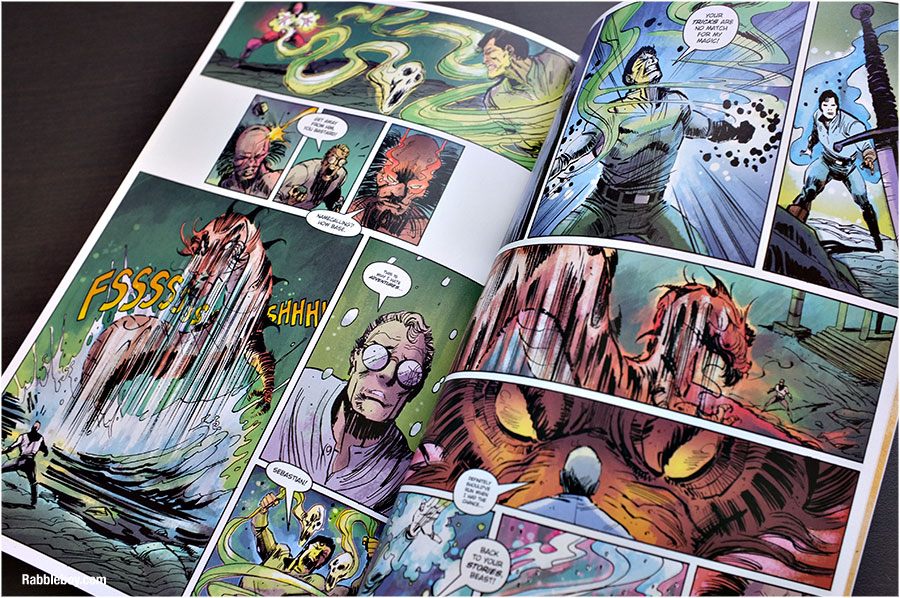
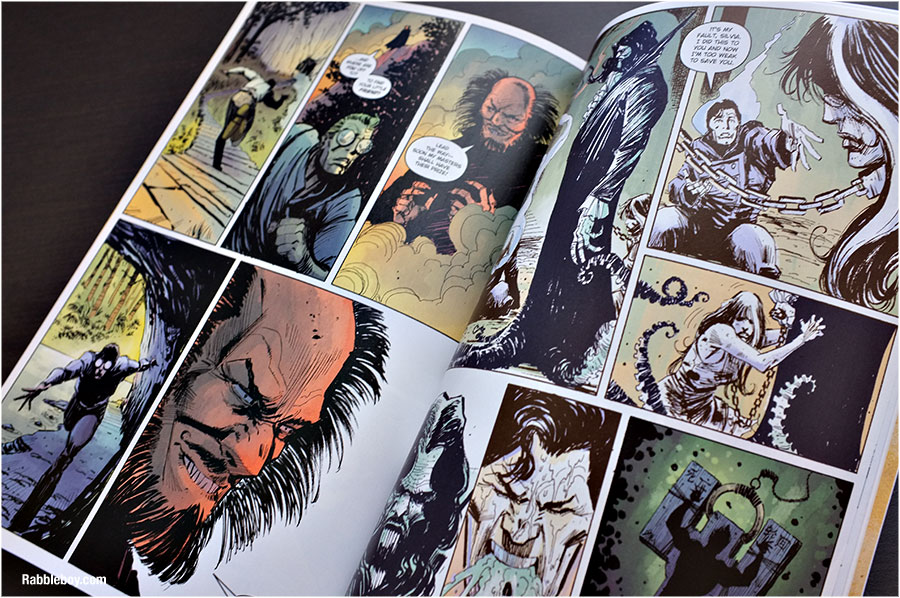
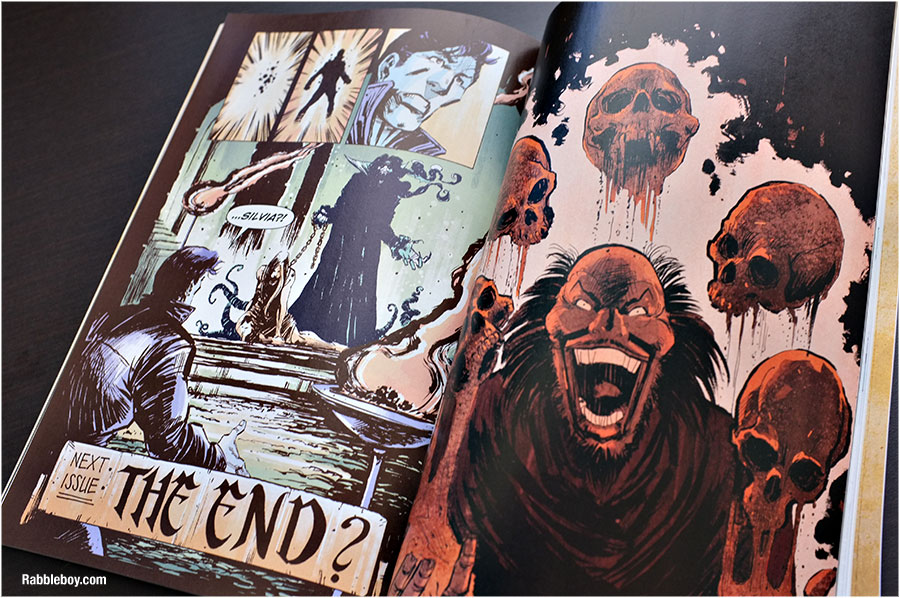
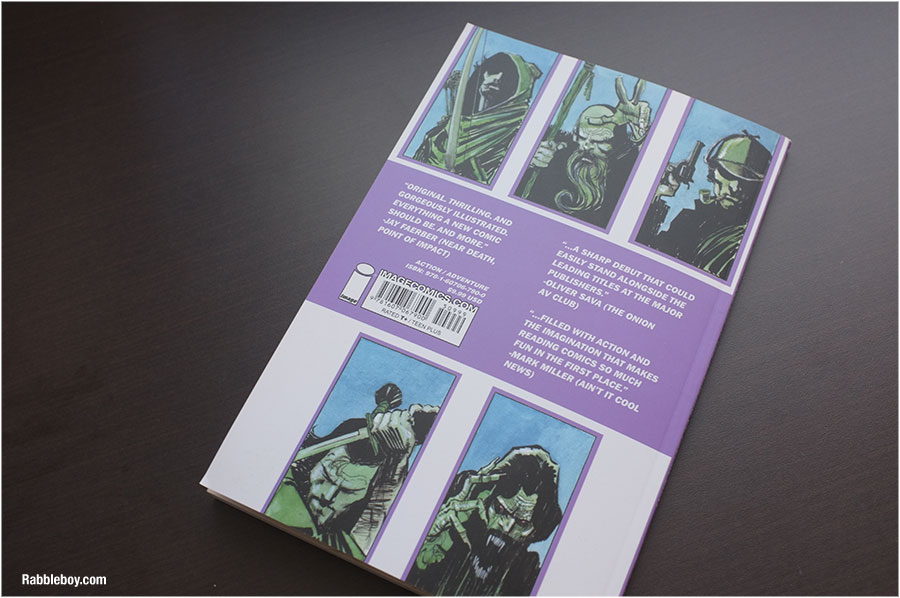



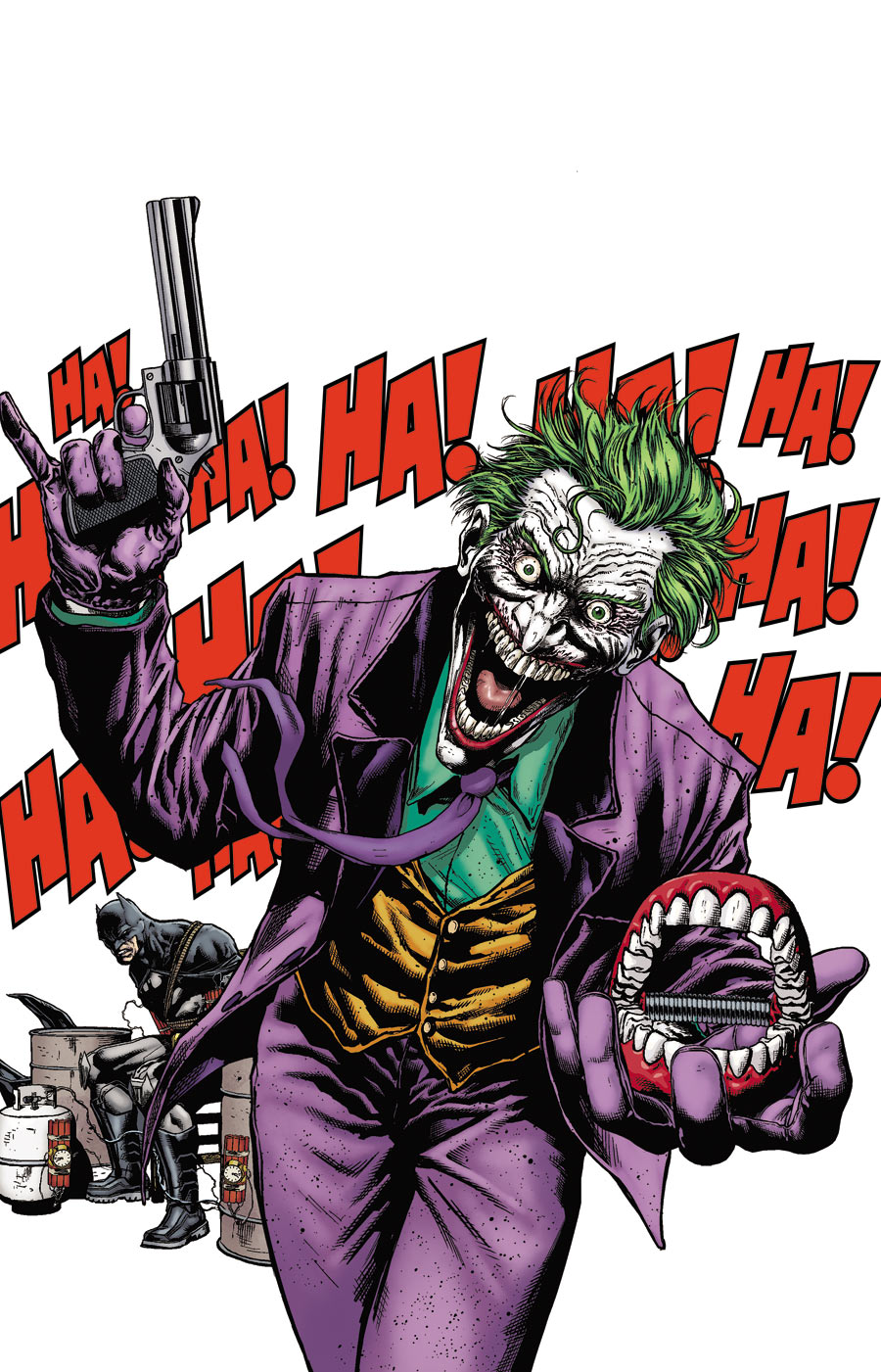


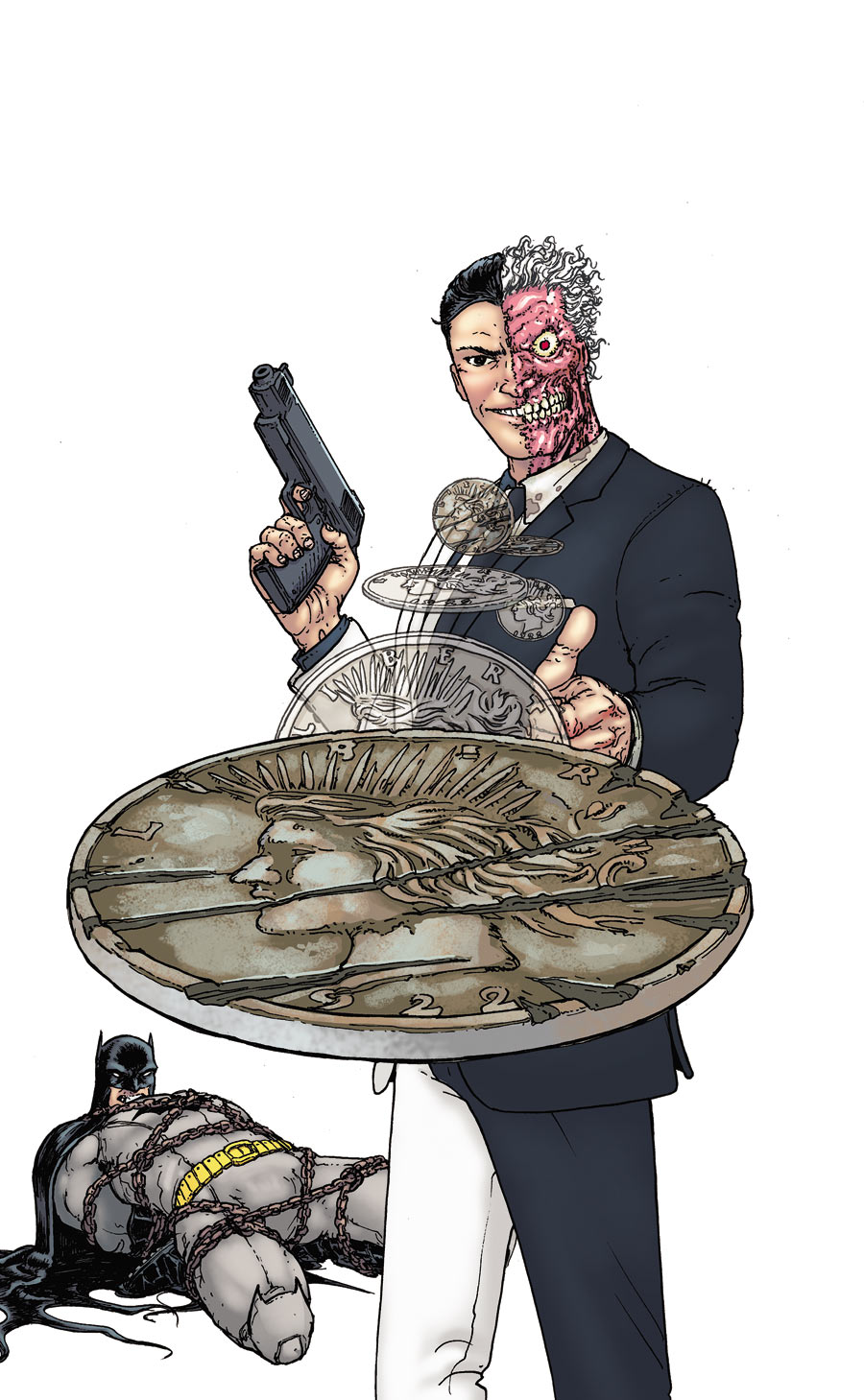
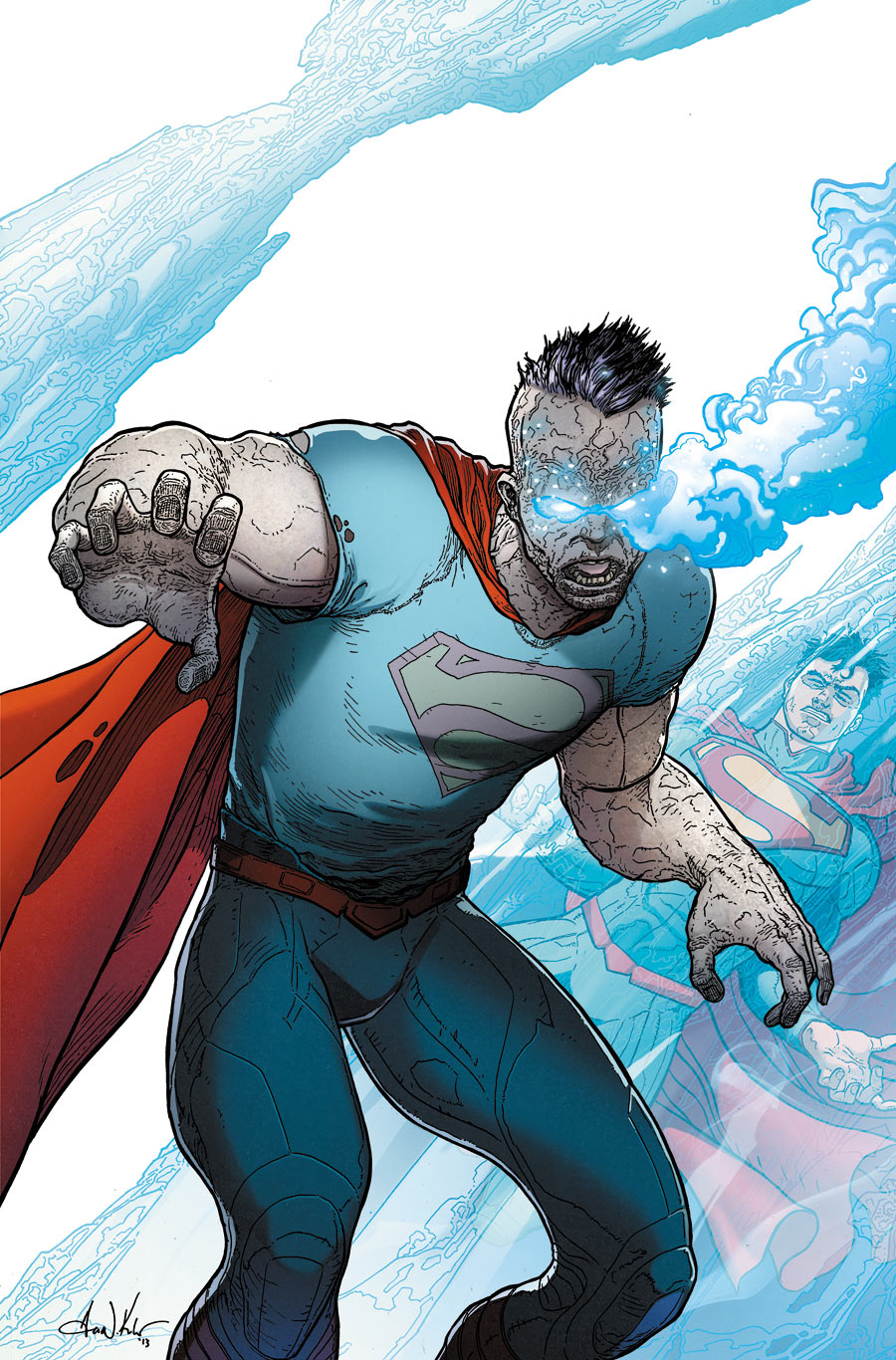













A great series that has a lot of emotion and surprises.
Be interesting to see how a film adaptation plays out.